Michael Caine at 90


Best of



Best of
Regulars
12 Modern Life: What is main character syndrome? Richard Godwin 21 How to survive a sex scandal Sir Les Patterson 27 Mary Killen’s Fashion Tips 40 Town Mouse Tom Hodgkinson 41 Country Mouse Giles Wood 42 Postcards from the Edge Mary Kenny 43 Small World Jem Clarke 44 School Days Sophia Waugh 44 Quite Interesting Things about ... horses John Lloyd
46
46
47
48
50
50
63
63
9
64
10
12
Moray House, 23/31 Great Titchfield Street, London W1W 7PA www.theoldie.co.uk

66
55
57
59
Crossword 91 Bridge Andrew Robson 91 Competition Tessa Castro

70

Golden Oldies Rachel Johnson 71 Exhibitions Huon Mallalieu
73
74
74
75
76
76

78
78
81
Travel
Overlooked Britain: Woburn Abbey and the flying duchess Lucinda Lambton
On the Road: Dolly Wells Louise Flind
Taking a Walk – by the North Sea Patrick Barkham
For display, contact: Paul Pryde on 020 3859 7095 or Rafe Thornhill on 020 3859 7093 For classified: Jasper Gibbons 020 3859 7096
News-stand enquiries mark.jones@newstrademarketing.co.uk
Front cover: Michael Caine by David Bailey, 1965


Just before Christmas, historian Lady Antonia Fraser composed a verse on confronting that age-old companion to faith –doubt – at Farm Street Church, Mayfair.
Whenever I doubt, I get out and about. To Farm Street I go –The journey is slow. I mutter and murmur, ‘My resolve should be firmer… Doubt? Kick it out.’
Then I flop down on my chair.
They put it specially there. So it’s solid and true, As I should be too. I pray throughout Mass. Doubt? Kick it out. Suddenly there’s a change Just within range.
The Host is held high Into the church sky. Peace is retrieved I believe…
Nick Downes is one of the most treasured cartoonists at Oldie Towers (see above right for an example).

The American cartoonist has been contributing to these pages ever since The Oldie was founded in 1992. Also prominent in the New Yorker, he is the cartooning heir to the great Charles Addams (1912-1988) – as in The Addams Family – in the gifted way he reveals the dark


Kenneth Cranham (p17) is one of our leading actors. He was in Oliver! and starred in Shine on Harvey Moon. On stage, he’s appeared in Loot, Entertaining Mr Sloane and An Inspector Calls.

Wilfred Emmanuel-Jones (p18) is known as the Black Farmer. He farms on the Devon-Cornwall border. Born in Jamaica and brought up in Birmingham, he was a BBC producer of food and drink shows.

Amelia Butler-Gallie (p31) is a postgraduate at Lincoln College, Oxford. She is doing an MA in 18th-century literature. In this issue, she writes about the threat to Virgil and Homer at Oxford.

Elinor Goodman (p32) was political editor of Channel 4 News from 1988 to 2005. She is a regular presenter of The Week in Westminster and was a member of the Leveson Inquiry panel.

underbelly beneath everyday American life.
Nick has published a new book, Polly Wants a Lawyer: Cartoons of Murder, Mayhem & Criminal Mischief. Perfect for anyone with a macabre taste for the blackest humour.
Any oldies who are a little hard of hearing will be moved by Norman Lebrecht’s new book, Why Beethoven? A Phenomenon in 100 Pieces (Oneworld, £20), published in February.
The book includes a moving translation of Beethoven’s renowned Heiligenstadt Testament, written to his two brothers – Carl Caspar, a government clerk, and Nikolaus Johann, a pharmacist, who unfortunately prescribed accidentally harmful remedies for Beethoven’s ailments.
Beethoven wrote the testament in 1802, when he accepted he’d gone completely deaf after six years of increasing deafness.
He’d first spotted a shepherd, out in the fields, blowing on a wooden flute – and he couldn’t hear a thing. Then he went out for the evening in the vineyards of Heiligenstadt, on the fringes of Vienna. Around him, revellers chatted and drank new wine, clinking tankards, and Beethoven couldn’t hear any of it.
And so he wrote to his brothers, ‘I was compelled to isolate myself, to live life alone. I could not say to
‘I want to make you Mrs Psychotic Drifter!’Charles
Addams’s heir: a Downes cartoonfrom
his new bookDoubt by Antonia Fraser
Man
Call for new Welcome to Colne signs Burnley Express
Stunned detectorist finds hoard of old porn mags Sun
£15 for published contributions
NEXT ISSUE
The March issue is on sale on 8th February 2023.
GET THE OLDIE APP Go to App Store or Google Play Store. Search for Oldie Magazine and then pay for app.
The Very Best of The Oldie Cartoons, The Oldie Annual 2023 and other Oldie books are available at: www.theoldie.co.uk/ readers-corner/shop Free p&p.

OLDIE NEWSLETTER
Go to the Oldie website; put your email address in the red SIGN UP box.
HOLIDAY WITH THE OLDIE Go to www.theoldie.co. uk/courses-tours
people, “Speak louder, shout, for I am deaf.”
‘Ah, how could I admit an infirmity in the one sense that ought to be more perfect in me than in others, a sense I once possessed in the highest perfection, a perfection such as few in my profession have ever enjoyed.
‘Oh I cannot do it; therefore forgive me when you see me draw back when I would gladly have mingled with you.

‘For me, there can be no relaxation with my fellow men, no refined conversations, no mutual exchange of ideas. I must live almost alone, like one who has been banished.’
Poor Beethoven! Next time you’re tempted to irritation by an oldie who keeps saying, ‘What?’, remember the agony of the Heiligenstadt Testament.
Calling all oldie women artists!
The artist Posy Simmonds has drawn a brilliant cartoon (pictured below) to help promote Hosking Houses Trust.
The trust is inviting applications from women artists who would benefit from a residency (two weeks to two months) in a country cottage near Stratfordupon-Avon.
Since 2002, the Trust has offered residencies to older women writers. Over 160 writers have benefited from a period of peace for personal work without other duties.
Church Cottage is a one-up, one-down artisan cottage beside the churchyard in the village of Clifford Chambers, Warwickshire. In 2019, Arts Council England sponsored the building of a
small, light studio extension. The cottage is free and utility bills are paid.
Artists with a substantial body of successful work –particularly cartoons, illustrations, graphic novels, calligraphy or animation –are invited to apply (hoskinghouses.co.uk).
All applicants are advised, though, to keep an eye out for ‘something nasty in the woodshed’, as Stella Gibbons put it in Cold Comfort Farm (1933). Look closely at Posy’s picture to stay fully abreast of the perils.
One of the perks of the theatre critic is the occasional glass of free wine laid on by the theatres.
That’s what happened at the opening night of Hex, a musical at the National Theatre.
During the interval, the
Something nasty in the woodshed:
Church Cottage, Warwickshire, by Posy Simmonds

‘I hear you’re Australian…’
National laid on free wine for the drama critics, traditionally a not unthirsty crew. The Daily Mail’s Libby Purves, 72, was not in the mood for Château Screwtop – so she moved towards a large tray of free ice creams.


‘Hands off!’ she was told. ‘They’re for the children.’

Purves is a quiet soul and made nothing of it, but a couple of other critics were also shooed away from the tubs of vanilla and chocolate.
The New York Times International Edition’s Matt Wolf informed the National press officers they were displaying ‘ageism’. That did the trick. Modern officialdom lives in terror of being accused of an ‘ism’.
The central truth, though, is surely this: no one is ever too ancient for an ice.
James Gillray (17561815), the great caricaturist, is having a comeback!
First came Tim Clayton’s new book, James Gillray: A Revolution in Satire
In his biography of the ‘Prince of Caricatura’, Clayton followed Gillray from his first satires on the American War of Independence through to revolutionary France and the Napoleonic Wars, expertly skewering British politics and behaviour along the way.
And, in March, Alice Loxton, a 26-year-old historian, publishes Uproar! Satire, Scandal & Printmakers in Georgian London. She writes about Georgian Britain
through the illustrations of Gillray, Thomas Rowlandson and Isaac Cruikshank.

Her particular themes are wild royals, political intrigue and the birth of modern celebrity – there’s nothing new under the sun!
Slightly Foxed have reissued The Prince, the

Showgirl and Me, Colin Clark’s delightful memoir.
It tells of his time as third assistant director on The Prince and the Showgirl (1957), the film version, starring Laurence Olivier and Marilyn Monroe, of Terence Rattigan’s play The Sleeping Prince Colin Clark, Alan Clark’s
younger brother, captures Marilyn Monroe’s charm, vulnerability – and enchanting looks.
One day, he walked into her room, to find ‘MM, completely nude, with only a white towel round her head. I stopped dead. All I could see were beautiful white and pink curves. I must have gone as red as a beetroot… MM gave me the most innocent smile.
“Oh Colin,” she said. “And you an Old Etonian!” ’
The introduction to the new edition, by Derek Parker, also recalls Colin Clark’s later reminiscence, My Week with Marilyn (2000).
One morning, a car drew up, with Marilyn in the back seat under a blanket. ‘I don’t want to be Miss Monroe today,’ she said. ‘I just want to be me.’
So Colin set off in the car, cuddling up to Marilyn in the back seat. They went for a walk in Windsor Great Park, where they soon attracted a little crowd.
‘Shall I be her?’ Marilyn asked.
Colin continues, ‘Without waiting for an answer, she jumped up on a step and struck a pose. Her hip went out, her shoulders went back, her famous bosom was thrust forward. She pouted her lips and opened her eyes wide, and there suddenly was the image the whole world knew.’
Oh, how the Old Un wishes he’d been there, too!
‘Before we can make it o icial, we’ll need you to pee into this cup’


I hit it off with Sinéad Cusack – but she fell for the footballer instead
I have started the new year with a new hobby.
I am taking a weekly walk down memory lane – literally. My physiotherapist, Finola, is doing her best to improve my posture and balance in the hope that I fall over less in the future than I have in the past.
Part of her regimen requires me to take regular brisk walks. To add interest to my promenades, I have decided to revisit places I once knew well but haven’t been to in a while.
I started in Oakley Street, London SW3, where I lived with my parents as a little boy in the mid-1950s. It’s a wide, handsome street of Victorian terraced houses that runs from the King’s Road down to Cheyne Walk and the River Thames.
My father liked to say that everyone lives in Oakley Street at some point in their lives. Oscar Wilde and his mother lived there for a time. Scott of the Antarctic lived there with his mother. Bob Marley and David Bowie lived there in the 1970s (at different numbers).
When I first met him, the footballer George Best was living at number 87, the house where Oscar and Lady Wilde had once lived. Donald Maclean, the Cambridge spy, had lived at number 29, in the house next door to ours.
It must be 50 years since I last went into a house in Oakley Street.
In 1973, I visited number 15 to have lunch with Richard Goolden, a lovely old actor, whose claim to fame was playing the part of Mole in the original stage adaptation of The Wind in the Willows in 1929. He went on playing the part almost until he died, in 1981, aged 86.
Dickie Goolden was Mole: small, bent, gnome-like and completely delightful. Over lunch, he chattered away merrily about Kenneth Grahame (who wrote the book) and A A Milne (who wrote the play – he knew both of them) and about life in

the trenches during the First World War, when he was in charge of the latrines.
He scurried about the house – it was the family home, left to him by his mother. When I told him how much I liked our chicken soup, he ran off to the kitchen and returned triumphantly waving the empty Knorr soup packet at me.
After lunch, he took me into the kitchen and showed me his collection of empty Knorr soup packets – hundreds of them. He did not throw anything away. He took me upstairs to the top room in the house – bare floorboards with old suitcases and cardboard boxes all over the place – and showed me the shelves where he had kept every bank statement and chequebook stub he’d had since he first opened a bank account in 1914.
I am thinking of going to Ireland next, to walk the streets of Dublin, as I did one night in 1970 after a romantic disappointment.
I was in Dublin, aged 22, to be a guest on The Late Late Show hosted by the late great Gay Byrne (1934-2019), then the most famous man in Ireland – by a margin.
His show was huge, and he was more famous than the Pope. Truly.
I remember him as leprechaun-like,
very charming and quite unspoilt by his incredible success. For me, though, the excitement of the night was not appearing on Ireland’s most popular TV show. It was meeting the actress Sinéad Cusack at the star-studded post-show party.
Sinéad and I became immediate friends – and found we had been born barely two weeks apart.
We exchanged jokes, theatre stories and our phone numbers within minutes and talked simultaneously, nose to nose, non-stop. Our hands kept touching.
I was bowled over by her. And she liked me. I know she did. For an hour or so, we had a really lovely time together – and then…
And then I introduced her to George Best! Why did I do it? She told me she wasn’t interested in football. I believed her.
George was a fine footballer, of course, but he wasn’t Pelé or Maradona, let alone Messi or Mbappé.
He wasn’t articulate or funny, and he wasn’t that good-looking either. He was rather awkward and scruffy, in fact. But Sinéad said goodnight to me and she went off with him. And, alone, I walked the streets of Dublin.
Sinéad will be 75 at the end of February. I will be 75 at the beginning of March.
Between our birthdays, my friend Sheila Hancock turns 90. She is a wise and funny lady who has been getting some stick in the press for talking up the value of the old-fashioned stiff upper lip.
I am with Sheila all the way. Let’s have more resilience and less bleating and blubbing and letting it all hang out. Keep your woes to yourself. Sinéad fancied George Best. She married Jeremy Irons. Get over it.
Gyles celebrates his 75th birthday with Judi Dench, Sheila Hancock and friends at the London Palladium, 5th March. In aid of Great Ormond Street Hospital
 matthew norman
matthew norman
This time, it struck me at 4.30am – the halfway mark of a refreshing five-hour sojourn in A&E – I truly mean it.
Admittedly, I’d been equally convinced that I meant it on three vaguely similar occasions in the last couple of years. The ultrasound on the testicular lump (epididymal cyst). The ECG to investigate cardiac arrhythmia (nothing lethal). The gastroscope after years of acid reflux (tiny duodenal polyp).
Each time, I believed I meant it when, while striking the cowardly atheist’s classic deal with God, I swore to the deity in whom I unbelieve that, if I could dodge the bullet, a radical metamorphosis would ensue.
This time, however, I really, really meant it.
The development that took me to the Royal Free, in the smug liberal leftie Shangri-La of Hampstead, was of a type that appeals to the professional hypochondriac more in the abstract, as described on a newspaper’s health page, than in the personal and particular.
Much as I’d like to euphemise, for the squeamish and those struggling to plough through this nonsense over their breakfast egg, I will simply repeat what I told a delightful Portuguese triage nurse in that miraculously empty department.
When I was asked what had enticed me to pay a visit on that picturesque, snowy early morn, the unwonted succinctness was dictated by the intensity of the pain radiating across the entire region between navel and upper thigh.
‘Can’t pee,’ I muttered, so sotto voce he wasn’t sure what he’d heard.
‘Sorry, are you saying you cannot go to the toilet?’ he followed up.
‘I’m saying no such thing,’ I said, relocating the gift for irksome loquacity. ‘I most certainly can go to the toilet. I have been to the toilet 30 or 40 times since midnight. What I cannot do, on reaching the toilet, is pee.’
‘Nothing?’
‘Not a f****** droplet.’
Sudden-onset urinary retention is not one of those symptoms that permit you to live in denial for long. A dodgylooking mole you can ignore for months. Blood on the Andrex can for a good while be ascribed, with fingers crossed, to piles.
But the total inability to urinate, apart from the indescribable mental anguish, is a bona fide medical emergency. It can lead, if not promptly treated, to renal failure, sepsis and death.
‘Are you in pain?’ asked an equally delightful staff nurse from Rome, as he attached a saline drip to the cannula. Plainly, this was neither the time nor the place for sledgehammer irony.
‘Never felt better,’ I responded. ‘If the roads weren’t so icy, I’d be off for a run.’
He smiled wearily, took some blood and went off to order an analgesic suppository.
A quiet A&E department in the middle of the night, with its weirdly seductive, harsh lighting and eerily serene atmosphere, lends itself beautifully to reflection on one’s own depthless inadequacies.
Obviously, in any such circs, the hypochondriac assumes it to be metastatic cancer, the primary tumour grown large enough to obstruct the urethra.
But, if not, should the cause be benign and treatable, it would be utterly shameful not to use the reprieve as the catalyst for reform.
In the CT scanner, the pledge was duly made. Let me off, Lord of whose non-existence I’m unshakably convinced, and to thee I vouchsafe to cut out the lashings of whisky and mounds of junk food; to redirect the untold hours in front of the telly to reading books; even to writing the sort of barely mediocre novel of which I might at best be capable.
‘Do you have the results?’ I asked the Portuguese when he ambled over to check the saline drip. He nodded. ‘It’s cancer, then? Kidney, bladder, prostate? All of them?’
‘It’s a kidney stone.’
‘Cancer and a kidney stone?’
‘Just a kidney stone.’
‘No cancer then?’
‘No.’
‘Can I kiss you?’
‘I’d rather not.’
I offered a fist bump. He graciously accepted.
A doctor confirmed this, and by 7.30 I was back at my mother’s house, where I’ve lately been in residence. I took her coffee and a buttered half-bagel, almost relishing the revived agony for the reminder of what it wasn’t.
Never one to centre-stage, she took the news stoically. ‘This is terrible,’ she said, adroitly side-stepping the triviality of the diagnosis. ‘I will never get over the shock.’
‘Of course you will,’ I reassured her. ‘All things pass. Even, eventually, this sodding stone.’
‘They say the pain’s every bit as bad as childbirth,’ she helpfully advised. ‘If not worse.’
I informed her of the epiphany; of how, from that moment on, I would cease squandering time in front of the telly, and begin looking after both body and mind.
‘Oh yes,’ she said, pursing lips. ‘Of course you will.’
The morning passed as pleasantly as the scrotal and abdominal excruciations would allow, in front of ITV, until I fetched us both quadruple Scotches and opened negotiations about lunch.
Several plant-based options were proposed, and jointly rejected. ‘McDonald’s?’ she proffered.
‘McDonald’s it is.’
After years of false alarms, my trip to A&E was a real emergency

The phrase Noblesse Oblige first appears in a Balzac novel, Le Lys dans la Vallée (1836). An elderly aristocrat tries to sum up for a younger friend how to live.
The Oxford English Dictionary defines it as ‘Noble ancestry constrains to honourable behaviour; privilege entails responsibilities.’
Why is the concept originally French?
It’s related to the idea of chivalry, the word itself deriving from the French word for horseman, chevalier (from the lateLatin caballarius). This word doubled as a term for a member of a higher social class, as it did with the Greeks and Romans.
The code of chivalry, familiar to us from Arthur’s knights and Pre-Raphaelite paintings, dated from the end of the 12th century, but was never codified. It derived from the medieval Christian institution of knighthood and was popularised in medieval literature.

The code of chivalry originated in the Holy Roman Empire, deriving from the idealisation of the cavalryman, especially
in Francia, where Charlemagne’s horse soldiers were such a potent force. By the late Middle Ages, chivalry had become a moral system that combined knightly piety, warrior ethos and courtly manners. This created the sense of honour and nobility that underlines Balzac’s famous phrase.
Dr Johnson saw as a source of nobility Aristotle’s notion of ‘the great-hearted man’, whose magnanimity embraced generosity of spirit as well as valour. As early as the Iliad, Homer’s Sarpedon understood the concept, telling Glaucus they enjoy royal privileges because they lead by example in battle.
Alexander the Great lived by this principle and his troops loved him for it. The Roman aristocrat Regulus endured a lingering death rather than break an oath he had given to his Carthaginian captors.
Modern democracies have understandable difficulty with the concept of nobility, preferring to admire it from afar in plays or historical novels.
Remember Burke’s words to the House of Commons on the death of Marie Antoinette: ‘I had thought ten
thousand swords would have leaped from their scabbards. But the age of chivalry is dead, and that of sophisters, calculators and economists is upon us.’
Still, the men who went out to govern the British Empire continued to read the Greeks and Romans at school. Few would have admired the selfish morality of Achilles or his Roman counterpart Coriolanus. Cicero’s advice to a future governor may have been preferred: ‘The first duty of a governor is to ensure the happiness of the governed.’
Modern aristocrats have not always behaved well. None of Stephen Ward’s grand clients would testify for him at his 1963 trial during the Profumo affair.
But the public schools of today still believe in doing service to those less fortunate and in making pupils aware that ‘privilege entails responsibilities’ – a memory of Noblesse Oblige.
John DavieJohn Davie was head of classics at St Paul’s School, London, and a lecturer at Trinity College, Oxford. He is co-author of Et Tu, Brute? The Best Latin Lines Ever
Main character syndrome is when you find yourself behaving like the protagonist of some kooky Hollywood romcom. Or maybe it’s a French arthouse movie for you, a Taylor Swift video, or a novel by John Le Carré.
You imagine all the world is your stage and everyone you interact with is a supporting player. Not a medically recognised condition, it’s a way of investing each mundane interaction with cinematic grandeur and novelistic significance.
The term gained currency on pandemic-era TikTok, when millions of bored teenagers started uploading parodic videos, gently ironising their own humdrum lockdown routines. Some are funny deconstructions of common
Hollywood tropes – the montage of the romcom heroine returning to her home town, for example.
Main character syndrome isn’t confined to TikTok. It is a widespread instinct in our self-conscious, mediasaturated age.
And it goes back a long way. Duffy, the sad bank clerk in James Joyce’s story A Painful Case (1914), seems to suffer from it: ‘He had an odd autobiographical habit which led him to compose in his mind from time to time a short sentence about himself containing a subject in the third person and a predicate in the past tense.’
I remember my English teacher declaring this to be the behaviour of a ‘loon’ and my girlfriend and me turning to each other to say, ‘But we do that all the time!’
Vladimir Nabokov was alert to the syndrome, too. The unhappy hero of his story Signs and
Don Quixote: daydream believerSymbols (1948) suffers from a condition called ‘referential mania,’ whereby ‘the patient imagines that everything happening around him is a veiled reference to his personality and existence’.
The archetype is Miguel de Cervantes’s 17th-century hero Don Quixote, who has read so many romances about knights in shining armour that he imagines himself to be one. Keith Waterhouse reinvents the form in Billy Liar (1959).
It isn’t easy having main character syndrome. ‘No one wanted him; he was outcast from life’s feast,’ Duffy muses in A Painful Case – another of those third-person past-tense sentences of his.
But there is also something rather consoling about it too. Are we not, after all, the main characters in our own lives? Is life not rendered all the more meaningful by our noticing all the little signs and symbols?
Walk around your town, pretending to be a film star – and tell me it isn’t an improvement.
Richard Godwinwhat is main character syndrome?
what was Noblesse Oblige?

As the great actor turns 90, Andrew Roberts salutes his long apprenticeship in forgotten B movies
Sixty-five years ago, many cinemagoers wanted to avoid the supporting feature for the Danny Kaye vehicle Merry Andrew.
That supporting feature – Blind Spot (1958) – was standard B-film fare, with scenery costing approximately 5/6d. The only redeeming element was the lastminute revelation of the villain, nicely underplayed by a tall, fair-haired actor billed 13th in the opening credits.
It was the great Michael Caine, who will turn 90 on 14th March.
‘Michael Caine-spotting’ is a pastime familiar to those of us who appreciate British cinema of the 1950s and early 60s.
Caine did national service between 1952 and 1954, seeing active service in Korea. After he’d left the army, it was a long, hard slog before he hit the big time.
Before the release of Zulu in January 1964, he appeared in 16 films. In 1958 alone, Caine made six brief appearances, including as a Gestapo officer confronting Jack Hawkins in The Two-Headed Spy. A year later, he was a squaddie in a cinema commercial promoting Watney’s Ale.

Caine memorably describes this treadmill of bit-parts and temporary jobs in his autobiography The Elephant to Hollywood
His one prominent cinema role of this era was as an inarticulate Irish labourer in the 1957 comedy How to Murder a Rich Uncle. Unfortunately, playing Gilrony required little more of him than looking woebegone and saying ‘Aye’ in a very strange accent.
Otherwise, he was making minor
appearances, including as a matelot at the beginning of Sailor Beware (1956) – Paul Eddington was a shipmate – and again in The Bulldog Breed (1960), helping to rescue Norman Wisdom from Oliver Reed’s Teddy Boy gang.
Towards the end of the 1950s, there appeared to be a glimmer of hope of big roles – with the possibility of Caine’s joining Associate British Picture Corporation’s stable of contract artistes. But the casting director Robert Lennard told him, ‘I know this business well and believe me, Michael, you have no future in it.’
Caine was far from alone in having his talents ignored by British cinema. Peter Sellers was 30 when he starred in The Ladykillers (1955), and Ian Hendry didn’t achieve a major film role until he was 31.
Meanwhile, in 1961, the 28-year-old Caine cameoed as a police constable in the science-fiction drama The Day the Earth Caught Fire – ‘and I didn’t even manage that very well’.
Still, Caine’s stage and television CVs were expanding. He is one of the last prominent British film actors to emerge from provincial ‘rep’, starting his career in 1953 at Horsham under the name Michael Scott. The West Sussex County Times praised how ‘Mr Scott switches alarmingly from quiet charm to maniacal frenzy’ in the play Love From a Stranger (based on Agatha Christie’s short story Philomel Cottage). Another critic noted how the performance attracted ‘an idolising bevy of high-school beauty’ in the audience.
Shortly afterwards, the former Maurice Micklewhite adopted the
professional identity of Michael Caine, inspired by The Caine Mutiny (1954).
Over the next few years, he would appear at Stratford East and in Birmingham in The Long and the Short and the Tall as Private Bamforth, alongside fellow cast member Terence Stamp.
Television increasingly augmented Caine’s stage work, including a part as a Swiss prisoner in The Adventures of William Tell, wearing what looked like a tea cosy. His small screen roles gradually improved, and in 1961 he co-starred with Frank Finlay as a mentally disturbed occupant of The Compartment, a duologue written by Johnny Speight.

The Stage applauded Caine’s ‘fascinating performance’, which is ‘missing, believed wiped’. The year 1961 saw him cast as the splendidly named Ray the Raver for Granada’s The Younger Generation series of dramas.
In 1962, Caine appeared as an escaped mental-hospital inmate in Speight’s The Playmates and told a reporter, ‘That’s the end of Cockney nutty parts on TV for me.’
Towards the end of the year, Caine starred as Willie Mossop in an ITV adaptation of Hobson’s Choice. But the best cinema could offer him was a gangster role in Solo for Sparrow, one of
the Edgar Wallace Mysteries B-film series. The conclusion of this epic involves a low-budget gun battle, the arrival of a police Wolseley and a surprise guest appearance from a chicken.
Then 1963 proved Caine’s breakthrough year, with his West End debut in Next Time I’ll Sing to You and the title role in the BBC play The Way with Reggie. Dennis Potter regarded his performance as the ambitious docker as ‘beautiful’.
Although the Daily Telegraph’s reviewer was less keen, he referred to Caine as a ‘bright young actor’.

When Edna O’Brien interviewed him for the Evening Standard, he informed her that in Zulu ‘I play an aristocrat and I am proud of that. It means I’m not just a Cockney with a capital “C”.’
The days of uttering trite dialogue in second features now belonged to the past. Yet those cinemagoers who avoided Blind Spot missed an opportunity to see a star in the making.
Johnny Brent anticipated the insouciant charm of Harry Palmer in The Ipcress File (1965) and Lt Gonville Bromhead’s dulcet tones in Zulu. Caine modelled the slow speed of his accent on the Duke of Edinburgh. He’d noticed that grand people speak slowly because they know their audience will listen to them; while the less grand had to speak quickly before someone interrupted them.

And only an actor of Caine’s skill could make the threat ‘You haven’t been rash enough to inform the police, I hope’ and a getaway car that changes from a Vauxhall Victor to a pre-war Hillman remotely believable.

He is one of the last prominent British film actors to emerge from provincial rep

When Kenneth Cranham performs Rudyard Kipling, he thinks of the late Josephine Hart, the writer and poetic pioneer
In February, I’ll be performing a selection of poems by Rudyard Kipling, Wilfred Owen and Robert Lowell and I’ll read prose by J B Priestley. The show explores the poignant experience of human beings in war.
The first third of the show will be Kipling. His poems take me back to Bill Gaskill (1930-2018), the theatre director at the National Theatre and the Royal Court. I was in eight plays directed by Bill, including a part as Len in Saved by Edward Bond at the Royal Court.
The last production Bill directed was his own funeral service. For his list of chosen readings, he wrote, ‘Kenneth Cranham – Kipling’.
He didn’t say which one. So I chose Kipling’s When Earth’s Last Picture Is Painted, with the lines:
When Earth’s last picture is painted and the tubes are twisted and dried, When the oldest colours have faded, and the youngest critic has died, We shall rest, and, faith, we shall need it...
I chose those words because Bill once tried to ban critics from his productions!
I also performed Mandalay, with its stirring refrain:
On the road to Mandalay, Where the flyin’-fishes play, An’ the dawn comes up like thunder outer China ’crost the Bay!
The poems go up to the recent past, in the shape of the American poet Robert Lowell (1917-77) and his poem on the My Lai massacre in Vietnam, in 1968, Women, Children, Babies, Cows, Cats:
We was to burn and kill, then there’d be nothing standing women, children, cows, cats.
Looking back, I can remember doing a series of poetry performances. I shared a stage with Christopher Logue at the National Theatre, performing his poems about London. I did a selection of Samuel Beckett at the National with Peggy Ashcroft.
For a Christmas service at Westminster Abbey, I recited a text
about Joseph and Mary seeking sanctuary in the dark of night. I read a three-word phrase, describing their plight: ‘Far from home’. Simple words – great power. The boys’ choir really did sound like a choir of angels.
I read, too, for the late Josephine Hart (1942-2011), the author of Damage, a pioneer of poetry performances and the wife of Maurice Saatchi.
Josephine thought that ‘In the beginning was the Word, and the Word was with God, and the Word was God’ was the first line of pure poetry she’d ever heard, as a little girl in Ireland.
As Randy Newman writes in his song Kathleen (Catholicism Made Easier), ‘I’ve always been crazy about Irish girls.’
In the February show, my daughter, Kathleen Cranham, will perform poems found by Josephine, the great huntressgatherer of poetry: Train by Helen Mackay; Perhaps by Vera Brittain; Paris, November 11, 1918 by May Wedderburn Cannan.
When I first read about Josephine, the dynamic, brilliant writer and promoter of performed poetry, I wanted to be one of her gang. Knowing she loved Elvis, as I do, I hand-decorated an Elvis cassette and sent it to her. Elvis worked his magic.
She asked me to perform Kipling at an evening at the British Library – a role previously performed by Roger Moore.

I emulated Roger’s favourite party piece, Kipling’s The Mary Gloster, a 16-minute storm of words from a dying father to his son:
Harrer an’ Trinity College! I ought to ha’ sent you to sea –
But I stood you an education, an’ what have you done for me?
The start of the reading was delayed because Margaret Thatcher was due to arrive – she was now retired and suffering from dementia but remained a Kipling fan. The hall at Downing Street during her time there was dominated by a large painting of Kipling, sitting at his writing desk in profile.
Margaret Thatcher’s favourite poem was If. I’d been given the task of performing it, including the lines:
If you can force your heart and nerve and sinew
To serve your turn long after they are gone,
And so hold on when there is nothing in you
Except the Will which says to them, ‘Hold on!’
John Major was also in the audience. His parents had been in music hall – a key element in Kipling.
Thanks to Josephine, I read in the Josephine Hart Poetry Hour at the Donmar Theatre in 2011. She put together a compilation of First World War poetry, writing what she called ‘introductions’ to groups of poems.
That triumphant week, she’d been battling cancer and had to be replaced by the actress Deborah Findlay. On the afternoon of the show, 2nd June 2011, it was announced that Josephine had died.
Her charming, witty, perceptive introductions were beautifully read by Deborah. Our hearts wept for Maurice. The audience and we readers were blind with tears.
One of my poems was To Any Dead Officer by Siegfried Sassoon, with the lines:
I’m blind with tears, Staring into the dark. Cheero!
The Soldier, performed by Kenneth Cranham, is at the Marylebone Theatre, London, on 5th February
Getting the 5.52am train from Exeter St David’s to Paddington is not a journey for the faint-hearted. But I believe face-to-face meetings are essential to build and maintain relationships in our business and personal lives.
It is an expensive trip at this time of the morning and a long way to go for a one-hour meeting. Still, my belief is that the old-fashioned way of doing things outstrips the convenience of the modern age.
‘Why not send an email or have a Teams or Zoom meeting?’ my younger colleagues are always asking.
I organise trips up-country myself from my farm on the Devon-Cornwall border, and I do so as if I were getting ready for a date. I confirm, confirm again, and ring ahead so I can hear from a person’s lips that the meeting will be going ahead.

I got one of my bright, young, university-educated interns to organise this particular trip. As I journey onwards from Paddington to Holborn, it is as if I have landed on another planet. Almost everyone is glued to their phone, oblivious to the world around them.
I am relieved to reach the sanctuary of my destination and the office reception area, and I give praise that I can escape those humanoids controlled by their screens.
‘He is not in.’ The reply pulls me up short. But I have a 9am appointment with him. ‘Sorry, but he has been on holiday for the past week and he will not be back for another four days.’
I ring my intern to ask if the meeting has been confirmed. Frustration bubbles up to explosive levels when I’m told the damning words, ‘Well … I sent an email.’
Since the start of the digital revolution, I have been in a losing battle with young people. I try to get them to understand that, rather than expecting
things to get done by sending an email, they must pick up the phone and speak to people.
The new form of business communication is via WhatsApp messaging and emails. Everything is text-based. This technology has speeded up communication. But it is breeding a generation of young people who are terrified of picking up the phone and speaking to a human being.
Although the mobile phone was first invented so that people could talk to one another more easily, mobile speaking devices are now mobile texting devices. Calling and leaving voice messages is almost extinct.
Technology has given us the gift of speed and convenience but, in the process, it has begun to strip us of our ability to connect – and connection is what is vital to the human soul.
We live in an age when people are desperate for human connection but, because they are so glued to their phones and computers, they are losing the vital skills that enable them to forge such a bond.
It is only when we talk to someone that we are able to build a clearer picture of what they are truly saying and, importantly, meaning. That contact gives us a glimpse into a person’s personality. We can hear the complexity that makes up their character.
Messaging is transactional unless you have the gift of poetry. Something
said in a text can have a completely different meaning from the same thing said on the phone or in person.
For some time now, having seen the growing trend to communicate with people only via text or email, I have been running my own private campaign to try to save people from themselves.
In my company, The Black Farmer, no matter your rank, everyone has to do their turn on customer service – and that means picking up the phone and speaking to someone.
Obviously this intern didn’t get the memo. Perhaps I should have emailed. I see every day how this customer-service approach pays dividends, as most people are so grateful that we bother to phone them.
I fear this problem of a younger generation, uneducated in how to connect with people, means that those of us who grew up navigating human interaction at every turn will be called upon in our older years to pass on those skills.
Companies that thought it wise to manage people of a certain age out of their business will soon realise they have a human-resources problem: a young workforce that has evolved to become so like the machines they worship that they have forgotten that most human art of connection.
Wilfred Emmanuel-Jones is a farmer and founder of The Black Farmer food range
Wilfred Emmanuel-Jones, the Black Farmer, has to teach his young employees to pick up the phone and talk directly to people



olest me, Les. Molest me in my workplace, you dirty old devil!’
The replay on the CCTV screen froze on a shot of my bum. The boardroom at Oz House was as full as a pommy complaints box – with Australian dignitaries, all old mates, shitting themselves. Otherwise, the boardroom was very quiet.
On the screen, I recognised Chantelle Pugh, one of my nubile PAs and a trusted member of Team Patterson. I looked around the room. There was the picture of Betty Windsor on the wall; some bastard had forgotten to replace it with Charlie.
Naturally, on the evidence of the hidden CCTV camera, my politico colleagues were a bit concerned that their own extra-curricular activities were similarly under electronic scrutiny. Most, if not all, research assistants in the office had had more than one distinguished visitor in her workplace – or, in the case of Bronwyn Cheknik, workplaces.
The reason for all this snooping is that the Labour Government wants the electorate to believe it’s cracking down on political immorality in high places – and every happily married man knows where those high places are located. Are you with me? So I was the sacrificial kangaroo. I was Patterson the patsy.
But I only got rapped over the knuckles because I know where too many bodies are buried. The PM was a nice bloke, and I’d helped him out of a few tight corners, some of which were very tight indeed. With me?
My colleagues were pretty understanding as well about my peccadillo (more pecker than dildo), considering most of them were fully paid-up scallywags themselves.
A few Labour PMs ago, I really did our bloke a favour.
Prior to that, I’d given him a sweetener: a lovely vintage Persian rug and an original Renaissance artwork of a Chow sheila with a green face on velvet, both from Kuala Lumpur.
I was trying, on behalf of a developer mate, to get demolition permission to bowl over some ‘colonial’ building in Melbourne. One of the last.
I knew the PM could sort out those heritage bastards who were standing in the way of one of the biggest shopping malls in the Southern Hemisphere in Australian history, and the Chows and their money were on the table. So it was a lay-down misère.
Then I heard on the grapevine that there was a rundown emu farm on the Queensland border of bloody nothing.
I persuaded the Australian Prime Minister to spend half a mill on that shit property in the outback. Everyone laughed at him, but I told him to hang on.
Well, about 18 months later, the emus had all carked it, but the Indonesians offered my eminent mate 20 million big ones for that shitty bit of nothing.
Turns out it’s full of uranium worth a zillion. Even after they had squared off the Aboriginal owners and their shonky Sydney lawyers, there was still a shitload left in the pot. The PM was as happy as a pig in poo.
But he owed the Indos big time, didn’t he? A bit of payback was required. There are more ways than one to bribe a head of state, and our bloke wasn’t too smart at international wheeling and dealing, though he’d come a long way from selling Toyotas on the Parramatta road.
Of course the bloody Indos used the poor bastard to the hilt – concessions here, mining rights there, deals worth a zillion. Even I got a finder’s fee – a week in Jakarta for two with all the trimmings.
Sadly, my wife, Gwen, God love her, couldn’t make the trip because they were running a few more tests on her that week, and I was forced to rub along without her. Me and Meredith Acropolis went instead.
My Gwen was off with the fairies thanks to the three Vs: Valium, vodka and Vera. She loves that TV show. She watches it mostly for the fashion tips.
A couple of Labour administrations later,
I was in strife again for going the grope – at a Christmas party of all things!
I bet little Jesus saw a thing or two going on with the shepherds and shepherdesses when he peeped out of the manger. Well, I was sent for ‘counselling’ by a not unco-operative shrinkess*, but I was fed up. I’d served Australia selflessly for donkey’s years, and what did I get?
Counselling! I want out. I’m sick of bloody woke. With my international credentials and my grasp of pretty well everything, I’m starting the new year on Les Patterson’s terms.
It’s not generally known that I groomed Tony Blair, and one of his team leaked it to me that old Tone makes a bundle on the lecture circuit. Particularly in the US. The Seppos† lap up his story about how he talked the heartless Royals into leaving their funkhole at Balmoral Palace and coming down to London to chuck a few daisies on Lady Di’s casket.
Boy, do they love that ‘true’ story!
The exclusive agency that handles Tone suggested a title for my lecture tour: LES PATTERSON, MUSINGS AND APERÇUS. To be perfectly honest, I’ve never done either of them, but if I wanted an audience of wall-to-wall pillow-biters and freckle-punchers, then that would be the perfect title.
In my search for a top job, I had an interview yesterday.
‘What is your greatest weakness, Sir Les?’ asked the too-clever-by-half interviewer.
‘I reckon it’s honesty,’ I replied, after a moment’s reflection.
‘I don’t think that’s necessarily a weakness,’ said this smartarse.
‘I don’t give a f**k what you think,’ says I, quick as a flash.
Have a good one!
LES
* A female psychiatrist † (Aust coll, obs) Hypocorism for septic tanks – Yanks
Sir Les Patterson was caught with a nubile research assistant with his trousers down – but got off scot-free
The first Rainbow Gathering was in 1972, when thousands of people climbed Table Mountain in Colorado to pray and meditate for world peace.
In the summer of 1986, I received an invitation at a Hare Krishna temple in Los Angeles to go to one of the Gatherings in the foothills of Big Sur, California – an invitation that was to change my life.
What followed has been an epic 36-year journey of love and learning with the Rainbow Family, which has taken me to Gatherings all over the world – Hawaii, Thailand, Morocco, Russia, Guatemala, the Canary Islands, Australia, the Arctic Circle, Israel, Mexico and almost every country in Europe. My daughters have grown up at Gatherings and still sing the Rainbow songs.
I decided to put together a new book of my photographs to celebrate the 50th anniversary of the Gatherings.

The Rainbow Family is not an organisation. It is non-commercial, non-political and non-religious. It has no leaders and no one to represent it.
At least three Gatherings happen every month all over the world. Thousands of people go to Rainbow Gatherings and yet it has no members. Some say it is the largest non-organisation of non-members in the world.
Gatherings can be reached only by foot and are often at the end of a long trail through a forest, a jungle or a desert.
My longest walk in was a gruelling eight-hour climb up a trail in the Dolomites in Italy.
The Gatherings last a month and follow the lunar cycle, new moon to new moon, peaking with a full-moon celebration in the middle.
The heartbeat of every Gathering is the music and the singing circles. Heart-
opening Rainbow songs, medicine songs, bhajans and mantras are sung communally in dance, in praise, in reverence – around campfires or in tipis. There are no facilities. Everything is done as organically as possible. We wash in streams, rivers or lakes. We cook on open fires. We drink from fresh-water springs. We dig communal or private ‘shit-pits’ and use ash, lime and earth to cover up our deposits.
We take everything out that we bring in. We aim to leave nature more beautiful than we found it.
It’s incredible but it works – we always have an abundance of everything that we need. The magic and the connection you feel are the essence and heartbeat of Rainbow.
Joth Shakerley’s Rainbow is available from jothshakerley.com (£65)





For 55 years, Peter Tatchell, 70, has been beaten up at protests. Just back from Qatar, he reveals how he prepares for his injuries

When I was asked by Qatari human-rights defenders to stage a protest in Doha in the run-up to the World Cup, I was apprehensive.
Sure, I’ve done more than 3,000 protests over the last 55 years, been arrested 100 times and experienced 300-plus violent assaults. So I’m a risk-taker and not afraid of a few knocks.
But Qatar upped the risk factor to a much higher level. It is a police state where protests are banned. Protesters get beaten and jailed. Westerners have died after being arrested. I was afraid – but my fears were overridden by the importance of shining a light on Qatar’s abuse of women, LGBTs and migrant workers.
I knew protesters can end up in prison for several weeks – or months. I took a calculated gamble that the Qataris would not want bad publicity a month before the World Cup.
When I said goodbye to my partner the day I left for Doha, I was anxious. I did not know when we would see each other again. I made an addendum to my will and left him money to pay my share of the bills for the next few months, in case I was incarcerated. Unlikely, I thought, but not impossible. Best to prepare for an ugly outcome.
To get into Qatar, and evade pervasive state surveillance, I borrowed ruses and deceptions that I’d read about in spy novels: hiding my placard in a copy of the Daily Telegraph; using evasion techniques to lose any state agents on my trail; taking a new, clean mobile phone; and avoiding all contact with Qatari rights activists.
Once I got there, I posed as a tourist, visiting the information office and taking selfies outside Doha’s main attractions.
It worked. I succeeded in staging a one-man protest in front of the National Museum of Qatar. But not for long.
Police and state security turned up. I was detained and interrogated on the pavement. When they warned me that what I was doing was illegal and a serious offence, I feared the worst.
To my surprise, after 49 minutes I was released and told to go to the airport and get my onward flight to Sydney. The Qataris apparently realised that jailing me would be a PR disaster 26 days before the start of the World Cup.
The story of my protest and the human-rights issues I raised were reported by over 4,000 media outlets worldwide, reaching an estimated audience of nearly a billion people.
That was the objective: to expose the abuses of the Qatar dictatorship and stand in solidarity with brave Qataris who are striving for democratic reform.
They can’t protest, out of fear of the draconian consequences. So I went to Doha to amplify their cause and support their struggle.
Since I was 15, I’ve done many similar protests – some are depicted in the current Netflix documentary Hating Peter Tatchell. They’ve included staging the first LGBT+ protest in a Communist country, in East Germany in 1973, which resulted in my interrogation by the Stasi. I went to Moscow in 2007 to support Russian LGBT+ activists who attempted to hold a Pride parade.
We knew the dangers and, sure
enough, I and others were badly beaten by neo-Nazis, with police collusion.
I am best known for two attempted citizen’s arrests of the Zimbabwean dictator Robert Mugabe – the more recent one, in 2001 in Brussels, resulted in my being beaten unconscious by his thugs. On the bright side, it helped highlight the brutality of his regime.
These bashings have left me with a bit of cognitive and eye damage. But it doesn’t stop me. I’m still campaigning.
Despite the many edgy protests that I’ve done, they’re still incredibly nerve-racking every time. I fear not succeeding – being caught before I manage to do the protest. I also fear jail time or being beaten. The nervous tension causes a splitting headache. I feel nauseous. My stomach churns over.
I get the shakes and my body temperature plummets. These physical discomforts don’t deter me. The campaign goal drives me on.
To reduce potential injury, I wear padded clothes and a small rucksack to protect my back. I stuff tissues in my back pockets to cushion a fall. My protest trousers have deep pockets or zips, so I don’t lose my money and phone if the police throw me around.
I carry ID and proof of address to reduce delays in my release after arrest. Protests are physically exhausting, so I pack sweets and an energy drink.
Some people say I’m brave. No. Not in comparison to truly heroic humanrights defenders in Russia, Iran, China and Ukraine. They pay with their lives and liberty. I’ve never been jailed or tortured. I’ve got off lightly.
Retirement? No, thanks. I’d find it boring and there are still many humanrights battles to fight and win.
I’m 70 now and hope to continue for another 25 years. Like the Duracell bunny, I plan to go on and on.
Hating Peter Tatchell is currently on Netflix


I was watching daytime television, as a way of decompressing, when a charming old boy in a three-piece tweed suit appeared on the screen.
He was sitting by a crackling log fire in a book-filled room with a dog at his feet as he answered, in alert and genial manner, the questions of his interviewer.

I was just thinking to myself, ‘I wonder if he’s a widower?’ as I called to mind an elderly spinster friend who might be just up his street.
But, as the camera moved into close-up, I saw something stuck onto the centre of the adorable man’s forehead. Pale-pink-coloured and conical, it protruded about two inches from his head, with a diameter of about three inches.
What on earth was it filled with? And why was he not self-conscious about it?
The growth was, I judged, likely to be either seborrheic keratosis or a keratotic horn – both sun-induced – and whether benign or malign it clearly needed to be excised at a surgery. But the old boy continued to discourse in an amiable manner as though there were nothing wrong.
And there is the rub. A multitude of disfigurements can appear on the face, usually after the age of 50. When we get them, they creep up on us so slowly that we come to accept them as part of our facial landscape.
Blobs – a non-clinical term, obviously, but the one into which category I place the aforementioned horn – include everything from the tiny skin tags that look a bit like Rice Krispies hanging by stalks off the face and neck, to colourless facial warts and slow-growing cysts, which can spring up on any site on the head and can, if left untreated, grow to the size of a tennis ball.
Even if we admit to ourselves that these blobs exist, two factors make us ignore them.
One is the syndrome exemplified by Dr Max Pemberton, the Daily Mail’s doctor: FOFO (Fear of Finding Out),
Warts and all: Cromwell told Peter Lely not to ‘flatter me at all; but remark all the roughness, pimples, warts and everything’

Pemberton himself, despite being a practising doctor, left a red mark on his own face for a year because of FOFO. He knew that the sooner he went to have it checked out, the better – but he still left it a year. When he finally went to a dermatologist, the diagnosis was squamous cell carcinoma and, luckily for him, it has been caught in time – just.
The second factor is that we don’t like to bother our overstretched NHS GPs. And the third is that even if we can pay for a private dermatologist, that would involve getting a referral letter from our overstretched NHS GP – and so we tend to put the problem on the back burner.
Don’t do this. The vast majority of unsightly blobs on the face are entirely
benign and can be swiftly dealt with. If you do not have them removed, they act as a distraction to your interlocutors.
They can’t concentrate on what you are saying. They are putting all their energy into not staring at the blob and wondering how they can tactfully suggest you have it dealt with.
Another age-related disfigurement is called an angioma. Angiomas are bright-red mini-blobs with a cherry like appearance. There are also spider angiomas, which lie just below the skin’s surface and radiate outwards like a spider’s web. These are also harmless and often worn proudly by those country dwellers who see themselves as merely ‘ruddy-faced’.
May I inform you that any skin blemish – even a tattoo – that is not standing proud on your face can be made invisible – I promise you – by Veil Cover Cream. You get sent a little selection of colours to try before buying. It is simple to apply; be sure to follow the instructions carefully for best effect.
The standing-proud blobs can often be simply sliced off by means of curettage. Seborrheic keratosis – flat, colourless, raised bumps under the skin –are often more prevalent on male faces than on female. These are entirely benign clinically – but not visually. Mercifully they can be treated by shave excision, in other words the doctor simply slices them off – with no lasting scars.
I myself have twice been able to help people by gasping guilelessly, as though I’ve only just noticed it, ‘Oh look! You’ve got a thing on your face just like I used to have. I’ve just had mine cut off by the brilliant Mr P. Have you heard of him? He’s the dermatologist everyone is going to. It was entirely painless and he reassured me it was benign. Do you want his number?’
Both of them did want his number –and, by use of this chatty, conversational approach, neither was offended.
Don’t ignore warts, cysts and skin tags. They can be easily removed
In 1989, I moved from the country to live in a mansion-block flat in Battersea, with my family and bull terrier, Parker.
Through Parker and his canine friends I met a variety of local people, including many of my neighbours. There was one who commanded attention, and I often saw him walking in Battersea Park where we exercised our dogs.
He was tall and well-built with broad shoulders and long limbs. Nobody approached him, as he looked forbidding and seemed quite private. He usually carried a football and was always accompanied by his small dog.
One day, when I was in the park talking to a neighbour, this impressive looking man passed us.
‘Do you know who that is?’ my neighbour said, once the coast was clear. ‘He’s John McVicar.’
Memories came flooding back from the newspapers I’d read. McVicar (1940-2022) was an armed robber who managed to break out of Parkhurst. He promptly tried to rob an armoured security van and went back to jail. He escaped again and was made Public Enemy Number One by Scotland Yard.
After his recapture and eventual release, his autobiography was made into a film, McVicar (1980), in which he is played by the lead singer of the Who, Roger Daltrey.
Now I realised McVicar lived in the block of flats next to mine. I couldn’t recognise the description given of him as a violent thug; he was always courteous and reserved. He liked to hear about Parker, and his own dog, Clemmy, used to greet me like an old friend.
One evening, when I was taking Parker for his walk, I was aware McVicar was behind me. He was with Clemmy, returning to his flat on the first floor. Just as I was about to turn back to go home, his dog appeared and started to jump up at me.
Parker was enraged, picked up Clemmy by his jaws and shook him violently. The dog screamed and I tried to separate him from my bull terrier. Without saying anything, McVicar took over and managed to free his dog. I assumed I’d be in deep trouble but, to my astonishment, McVicar was very understanding and polite. After that, he invariably asked after Parker and we would have a friendly chat.
After about a year, a young man called Scott moved into the flat next to mine. He owned two very large dogs who were locked up in his flat and howled.
A few months later, the area was buzzing with rumours. A young man had been badly beaten up by McVicar and reporters were gathering to interview the locals. Everyone thought McVicar would be sent back to prison for years.
Eventually more details came out. Scott, my neighbour, had been attacked over something that involved his two dogs.
Scott had come home early in the morning to let his dogs out. McVicar was just about to go into his flat when Scott’s dogs saw Clemmy, rushed forward and proceeded to tear her to shreds.
McVicar dived in to rescue her and
his arm was badly bitten. He held up his bleeding arm and asked Scott what the hell he thought he was doing. Scott retaliated with a stream of insults and became extremely aggressive. Provoked beyond endurance, McVicar beat up Scott, who ended up in casualty with bruises and a broken nose.
After leaving hospital, Scott contacted the Sun with his story. He was due to receive several thousand pounds following an almost certain conviction.
I told a friend of McVicar’s I would be happy to be a witness to his behaviour over the incident with Clemmy. Summoned to Kingston Crown Court, McVicar defended himself. I appeared as the main character witness. He gave his account of what had happened, and his calmly delivered defence was convincing.
The judge seemed impressed. I told the court what had happened when Parker shook Clemmy ‘like a rag doll’ and McVicar acted with politeness and restraint.
Later that evening, I heard on the radio that John McVicar had been found innocent. He left a message on my answerphone thanking me profusely and inviting me to have dinner with him.
I was pleased to accept. He took me to a fashionable Battersea pub and we talked for hours, mostly about athletics and the weightlifters competing in the Olympics – interests we shared.
I’m glad to have known John McVicar, a strangely intense, private man. It was impossible not to admire him for overcoming a violent past to educate himself in prison and pursue a career as a journalist and author.

I wasn’t surprised to hear that when he died recently, he’d been living happily in a caravan in Essex, away from everyone he knew.
A fiercely proud man, he wouldn’t have wanted anyone to witness his physical deterioration.
John McVicar – the armed robber who kept breaking out of jail – was a lovely neighbour, says Vivian Marnham










The university’s classics department is threatening to cut back on Homer and Virgil. Amelia Butler-Gallie is horrified
Otempora! O mores! The Classics faculty at the University of Oxford is looking more likely to proceed with proposed reforms to the degree course, first suggested in 2020.
Homer and Virgil – the greatest poets of Greece and Rome – would be pushed to the sidelines in favour of a more diverse assortment of Classical texts and contexts. Horribile dictu!
The implications – not only for undergraduates, but also for the wider cultural messages this sends about how we value civilisation’s most magnificent literary works – are gargantuan.
The reforms would mean the compulsory study of the Iliad and the Aeneid, normally examined during second-year Honour Moderations (or Mods), becomes an optional study for papers in Greats, the Classics Finals papers.
As Virgil warned in Book VI of the Aeneid, ‘facilis descensus Averno’, ‘the descent to hell is easy’!
I applied to study Classics at Oxford a few years ago and was, quite rightly, rejected. The dons who interviewed me easily sniffed out my grammatical ineptitude and lack of linguistic ability.
But I did end up reading English there and have always retained a deep love of – and veneration for –Classical literature.
Only a lunatic would contemplate exiling Shakespeare from the English syllabus because he’s too difficult.
That’s precisely what makes Shakespeare worth reading at degree level. To ignore him would be to miss thousands of vital allusions and references in lesser-known writers who came after him.
In my English degree, Shakespeare is so indispensable to a comprehensive view of English literature throughout the ages and his language so inexhaustibly complex that he is given an entire paper
in my English exams. Surely Homer and Virgil deserve the same level of reverence, if not more?
Seeking to make Classics more accessible to those who have not had the opportunity to attend private schools sounds laudable, but it will backfire.
Pupils who did Latin or Greek A-Level will certainly have read extracts from the Iliad, the Odyssey or the Aeneid (in the original or in translation) before university. What good does it do to delay introducing the magna opera of Classical antiquity to less fortunate undergraduates once they get to Oxford?
In the name of access, these texts will be reserved for and enjoyed by a coterie of privileged public-school students. The Classics – and their literary treasures – belong to everyone, regardless of background.
Some people claim that banishing Homer and Virgil from Mods will make work more ‘manageable’ for all students. This bureaucratic jargon reeks of the old jibe that my generation (Generation Z) is less capable of learning the same things our predecessors encountered. Patronising and untrue.
Maintaining high standards is
actually a kindness, mollycoddling an insult.
The Classics department ought to have more faith in their undergraduates’ ability to engage with and grasp challenging ideas. As the American politician Jesse Jackson said, ‘No one has ever suffered from being talked up to.’
Homer and Virgil wrote universal truths – and garner universal appeal. Their influence on writers both within and beyond the ancient world is immeasurable. How hubristic to remove them from the centre of the Classics course at the university that has been the centre of Classical scholarship for centuries.

As Virgil wrote in the Aeneid, ‘Sunt lacrimae rerum.’ Seamus Heaney’s translation captures the sense: ‘There are tears at the heart of things.’
Amelia Butler-Gallie is a postgraduate researcher in 18th-century literature at Lincoln College, Oxford
As Jesse Jackson said, ‘No one has ever suffered from being talked up to’Virgil with muses Clio and Melpomene – Tunisian mosaic
Goodman loves her leopard-skin pair
When she was my age – in her seventies – my maternal grandmother had two pairs of shoes and a pair of slippers.
Both shoes were lace-ups on sturdy, two-inch heels, of the kind nannies or schoolmistresses wore.
My paternal grandmother had two similar pairs and a pair of wellington boots because she lived on a farm.
Both had roughly the same uniform: tweed, pleated skirts, cream blouses and a long cardigan with a pocket for a handkerchief.
My mother was much more fashionconscious well into her nineties. Her favourite magazine was Vogue. She was aware of trends – big bows at the neck and padded shoulders when Mrs Thatcher was power dressing.
She would take the hems up and down – just the right amount above or below the knee to conform with the direction of travel laid down by fashion editors.
And she always looked good.
Her biggest regret was her feet –which I have inherited. A doctor stupidly told her when she was 12 that she wouldn’t be able to walk as an adult because they were so weak.
In fact, she could walk almost up to the time she died, but only if she wore shoes made for her by the NHS, stuffed with arch supports. They were flat leather lace-ups – one grey pair and one navy. She despaired of ever looking really glamorous in them.
How much easier it would be for her today. Now everybody wears trainers.
They evolved many years ago out of shoes worn for exercise. When I was a child, my mother would never have let me swap my Start-Rite sandals for them: ‘only village children’ wore plimsolls, as they were called then.
Now they cross all class divides. When ITV’s Robert Peston interviewed former prime minister Liz Truss at the Tory Party conference, both of them were wearing trainers.
Peston complained recently that he was forced to remove his trainers at a London gentlemen’s club and borrow some of their smart shoes.
Princess Alexandra is said to wear trainers at formal functions. The former MP Nicholas Soames, now a peer, wears trainers with Savile Row suits. Other MPs wear trainers to speed between the Millbank TV studios and the Commons.
The trend accelerated in lockdown. When I crept back to London after almost two years in the country, everyone of all ages seemed to be wearing trainers.
Some carried bags with high heels in them for meetings with clients or to pop into the Ritz, which bans trainers (the nightclub Annabel’s will let you in, provided they are ‘fashion’ trainers). When the late Peter Cook was asked to remove his before gambling at the Ritz Casino, he said, ‘What? My lucky trainers?’
Alongside everyday trainers, I have a leopard-skin pair, expressing my inner Theresa May, and another pair with sparkly stars. I wore these recently at a funeral.

Fashion magazines show young models wearing floral dresses with ‘elevated trainers’. One magazine assured an anxious reader that flowery trainers are fine for weddings. And according to the Guardian, ‘trainers with a trouser suit became the go-to look for
CEOs doing Ted Talks’. Influencers offer advice on what colour trainers to wear: white last year.
The problem is once your feet have got used to comfort, they rebel angrily when pressganged into high heels. And there are certain things you can’t do in trainers – such as dance the tango, or dine at certain men’s clubs. One woman is currently involved in a legal suit with a staid City club whose rules insisted on a trainers ban.
On a recent trip to that emporium of middle-class respectability Peter Jones, 80 per cent of the women were wearing trainers or rubber-soled jodhpur boots. The only stilettos were on mannequins in the windows.
It won’t last. When the older generation starts wearing the uniform of the young, the younger generation moves on.
My generation likes to think of itself as not bound by the rules that meant most grandmothers dressed alike 60 years ago.
We wear jeans, almost regardless of the shape of our backsides. We like to think we are expressing our individuality by wearing whatever skirt length we like, bright colours and voluminous knitwear to cover the bulges.
I have a vision of the time when I have to go into a home. All the residents will be wearing trainers. Some wellmeaning, irritating entertainer will urge us to get up and dance in them. They will be as much a uniform for us as those little, heeled lace-ups were for my grandmothers.
Grandchildren, meanwhile, will have their feet in plaster after operations for bunions from wearing stilettos after trainers went out of fashion.
Elinor Goodman was political editor of Channel 4 News, 1988-2005
In 1984, Margaret Thatcher was due to visit the famous school. Two days before, a menacing ‘parent’ cased the joint. By Robert Portal
In the autumn of 1984, the then Prime Minister Margaret Thatcher was invited to be the guest of honour at Harrow’s annual School Songs. I was at the school at the time.
Churchill Songs, as the event is known, involves the whole school together singing from the school songbook, followed by an address from a person of note with links to the school, on a topic of their choice.
School security (such as it was – there wasn’t much) was ramped up. On the Tuesday (Songs was on the Thursday), our custodian (known as Custos) was in Speech Room, where Songs is held.
In walked a man with a strong Northern Irish accent, asking if he could be shown round the school as he might be interested in enrolling his son as a future pupil.

Smelling a large rat, Custos let him into Speech Room before darting out, slamming the door and locking it. He then went off to inform the head of school security, who told him to keep the door locked and he would ring Special Branch.
Special Branch told him to keep the man there – they were on their way. The head of school security then ran over to Speech Room. There, to his consternation, he found the door open, Custos looking sheepish – and no Northern Irishman.
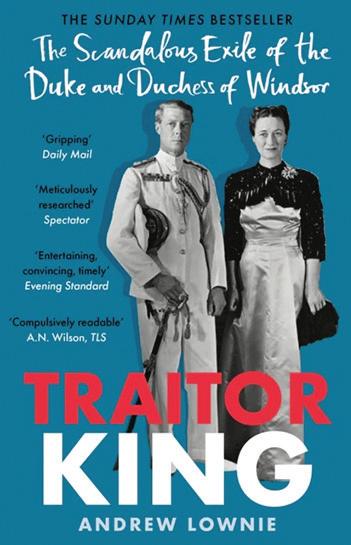
Custos explained that the man had been trying to smash the door down with such violence, he’d felt he had no choice other than to open it.


This was what he repeated to Special Branch when they arrived. Custos was asked to accompany them back to

Paddington Green to identify this man using the old-fashioned Identikit. This he did.
And that seemingly was that until, one morning, three weeks later, on 12th October, the country awoke to learn of the atrocity committed by the IRA in Brighton. A bomb had been detonated at the Grand Hotel, killing five and brutally injuring many, including Norman Tebbit and his late wife, Margaret Tebbit.
A manhunt then followed to find the perpetrator. He was eventually caught, tried and was sent to prison.
His name? Patrick Magee. The same man who came to our school, asking to look around, as he was interested in enrolling his son as a future pupil.

The kitchens of the National Liberal Club are closed until May. So we have decided to go on tour, in aid of local charities (save the dates: 26th April at Fairlight Hall near Hastings; 9th May, back at the National Liberal Club)
on Et Tu, Brute? The Best Latin Lines Ever, written with John Davie Latin omnibus, from Virgil to saucy gra iti
on Traitor King: The Scandalous Exile of the Duke and Duchess of Windsor The gripping tale of the Windsors after the Abdication
on Diary of an MP’s Wife
The juicy inside story of the David Cameron years

From The King’s Speech to The Crown, historical dramas are full of lies. Playwright Francis Beckett prefers the truth
Turning history into drama, you have some artistic licence.
You can be cavalier about the precise facts, alter the sequence of events and even invent some, and you have to invent a lot of dialogue.
But is there a line you mustn’t cross?
In November, two former prime ministers, Tony Blair and John Major, attacked The Crown for depicting Prince Charles (now King Charles) lobbying them to help force his mother to retire.
I know the problem. I’ve just written a historical play, Vodka with Stalin. It tells the story of the troubled relationship between Stalin and the Communist Party of Great Britain.
The meetings with Stalin happened, but I invented a pivotal scene between Communist leader Harry Pollitt and Labour Party leader George Lansbury.
My other play, A Modest Little Man, about Clement Attlee, has been performed in London and Liverpool. I wanted to build up the importance of my central character. So I was less than fair to big figures in his Cabinet, such as Nye Bevan and Herbert Morrison.
It was on Attlee’s behalf that I felt indignant when I saw the 2017 film Darkest Hour. Writer Anthony McCarten gives us a war cabinet in 1940 that believes Britain to be defeated and wants to negotiate with Hitler. Winston Churchill (Gary Oldman) is isolated and alone until King George VI gives him support.
Which is rubbish. Churchill’s crucial support came from Attlee and Attlee’s deputy, Arthur Greenwood. Churchill, Attlee and Greenwood outvoted the defeatists, Chamberlain and Halifax, in the five-member war cabinet.
I cannot see a good dramatic reason for not telling the truth here.
In 1940, Britain was hours away from a German invasion that military chiefs thought would succeed. That the government was not panicked into negotiating was mostly the work of Churchill and Attlee. That’s a dramatic enough tale. Why not tell it?
There’s also a widely mocked scene in the film, in which Churchill takes a trip on the London Underground and speaks to Ordinary People who buoy him up with their John Bull spirit. It’s laughable but transparent, unlike the falsehood about defeatism, which is neither.

There’s another example in the 2010 film The King’s Speech, about the speech therapist who enabled King George VI to speak without stammering.
Timothy Spall’s Winston Churchill urges Edward VIII to abdicate in 1936. He tells the future George VI (Colin Firth), ‘Parliament will not support the marriage [to American divorcee Wallis Simpson]. There are those who are worried about where he will stand when war comes with Germany.’
This is the opposite of the truth. Churchill wanted the King to face down Prime Minister Stanley Baldwin and stay on the throne. Churchill was even touted as the leader of a potential ‘King’s Party’.
It lent weight to the stammering story if you could link it to the much bigger issue of fighting Hitler, even though no one made this connection at the time. In a film that simplistically pits the goodies (pro-abdication) against the baddies, it’s convenient to have a national hero like Churchill on the side of the goodies.
As history gets more recent, offence is more likely. I have seen in Neil Kinnock’s archive a hurt private letter he wrote to David Hare after seeing the latter’s 1993 play, The Absence of War. Though the leading character was called George Jones and was not Welsh, Hare admitted he was a thinly disguised Kinnock, struggling through the 1992 general election, which Kinnock unexpectedly lost.
Kinnock wrote to Hare, ‘No one watching it, or writing about it, will make the distinction between what is biographical and documentary and what is fictitious and theatrical.
‘George is remote, garrulous, innumerate, a noble soul manipulated into respectable coma and searching for scapegoats.’
Hare felt Kinnock was seeing it not as drama, but as reportage, which it isn’t.
I have some sympathy with Kinnock. As he wrote to Hare, the play ‘echoes the mythology’. No one seeing it was going to say, ‘It’s only a play.’
It’s safer to set your play a long time in the past. In Robert Bolt’s 1966 A Man for All Seasons, Thomas More is brave and principled. In Hilary Mantel’s novels, later plays, he is a cruel, selfrighteous bigot.
Both are right. More was the sort of man – like many Catholics of his time and many 20th-century Communists –who bravely confronts death for his beliefs, convinced it was those who got the line wrong who ought to be killed. Equally, Thomas Cromwell was Mantel’s far-seeing, serpentine statesman and Bolt’s cynical manipulator.
Both Bolt and Mantel emphasised those parts of their protagonist that help their audience to care about him. That’s what Hare did with Kinnock, and I hope I have done with Attlee and Stalin. No piece of writing offers the whole truth about anything, not even this one.
But there is a line that to cross is to distort the story of our past to the point where your drama becomes a lie.
Darkest Hour crossed it, because it made great characters in our history do exactly the opposite of what they actually did.
Francis Beckett’s Vodka with Stalin is Upstairs at the Gatehouse, Highgate, north London, in February

The word ‘tragic’ is often misused nowadays. It’s fitting to apply it to the life of my friend and literary collaborator Matthew Leeming, who died at the end of November at the early age of 58.
Matthew’s life was tragic in the Greek sense of the word, with a descent from a high estate down to the depths.
As an Oxford undergraduate, he shared a house with Boris Johnson, and was regarded as one of the most brilliant and promising members of a gilded generation there in the mid-1980s.
In the early 2000s, thanks to his work in Afghanistan he was fêted as the next big thing in travel writing – as if ‘Hunter S Thompson meets Robert Byron’, one critic said.
Yet he was not simply a man of letters. He was also an irrepressible entrepreneur. Every time you saw him, he was on the trail of a new venture –often in Afghanistan: oil, gold, gems, marble, tourism, printing.
In the last decade of his life, he spent time on the streets, not just back in Oxford, but also sleeping rough in the graveyard of the church in which he was baptised.
His decline, after the failure of a 2012 venture (the supply of jet fuel to Afghan NATO bases), came in spite of the best efforts of many friends to help him.
Although he regained some of his earlier equanimity in the last year of his life, resuming his literary journalism and business schemes, years of self-neglect caught up with him, being the most likely reason for his early death through as yet undetermined natural causes.
Underlying both his prosperity and his collapse is the fact that he maintained in all his dealings the mien of an Edwardian adventurer. In essence, he was a gentleman anarchist. A gentle and scholarly soul at heart, he suffered an angrily abusive upbringing at the hands of his father and terrible bullying as a boy at Bradfield. As a result, he was inclined towards Quixotic quests that would bring him security and esteem, while at the
same time giving way to self-destructive tendencies and taking pleasure in shocking sensibilities, challenging authority and causing chaos all around.
His long sojourns in Afghanistan allowed him to give free rein to these aspects of his character. He mentions in his diary how happy he was in Kabul drinking vodka and listening to Don Giovanni on headphones while sitting one table along from a Mujahideen warlord: ‘[I] felt I had found all I wanted: alcohol, Mozart, a weird and slightly dangerous city.’
Matthew had been personally encouraged to go to Afghanistan by the great explorer Sir Wilfrid Thesiger. Thesiger told Matthew that Afghanistan was one of the few places left where one could still explore in an old-fashioned way.

This Matthew did, to the full. Under the guidance of the Oxford classics don Robin Lane Fox, he hunted for traces of Alexander the Great, running genetic tests on the blond-haired inhabitants of the Hindu Kush to see whether they were descended from Alexander’s Greek soldiers, and mounting expeditions to the ancient lapis-lazuli mines.
The Spectator carried his dispatches from the country, where he recounted extraordinary happenings: a visit to a Kabul prison death row, in which he found high comedy; an interview with a Hazara
man who was forced by the Taliban to plant explosives in the Bamiyan Buddhas.
He remains most famous for the account of his accidental meeting with the suicide bombers who killed the anti-Taliban leader Ahmad Shah Massoud just before 9/11. He failed to recognise them as suicide bombers, and even loaned them his satellite phone.
In 2005, he wrote with me the first full guidebook to the country to be published since the 1970s. His own uproariously funny travel narrative of the country remains unpublished. In an example of his self-destructive streak, he refused to remove a small number of jokes at the request of his – in his eyes – overcensorious editor, as a result of which the book was pulled.
His anarchic, self-destructive tendencies meant personal relationships with him were fascinating but difficult.
Once he cheerfully greeted a friend and his two children calling at his cottage in Alresford with ‘Hello, I’ve just shot a swan!’ He told me the ashtray he was using at the cottage was Stalin’s soap dish, which he had gleefully stolen from Stalin’s train in Georgia (this artefact is presumably now lost).
As a visitor, he left a trail of devastation: chocolate-mousse handprints up staircases, or kitchens covered in dried spaghetti and Nicorette chewing gum.
His unruliness belied a genuine care for Afghanistan. He was scandalised by the British abandonment of interpreters and others who had helped the allies there.
To the end of his life, he made every endeavour to support them. Like many an apparently supercilious Edwardian adventurer, he had a profound love for the country he spent years exploring.
For this, as much as for his other achievements, we should remember him.
Afghanistan: A Companion and Guide (Odyssey) by Bijan Omrani, Matthew Leeming and Elizabeth Chatwin is out now
Nowadays, it isn’t just oldies who are baffled by thoroughfares like Bond Street.
The glossy façades of our most famous shopping streets have never housed cheap goods. But there was a time when Covent Garden piazza had stalls selling quirky belts, scarves or trinkets and Burlington Arcade could yield a delightful, affordable gift such as a Battersea enamel box or an Irish linen, hand-rolled handkerchief.
Today, Covent Garden is a soulless hub for high-street chains and brands such as Chanel or Tom Ford. Burlington Arcade is a polished marble souk for the super-rich.
To browse in Asprey or Hermès is to feel overwhelmed by the prices and beady-eyed, hovering staff. Suited-andbooted security men make the very act of entry intimidating.

And once you’re in, then what?
A Chanel woman’s jacket costs more than £6,000, a tiny Gucci leather handbag nearly £2,000 and a pair of Prada loafer-style shoes around £890. Judging by the queue (kettled behind a sumptuous red velvet rope) for Chanel on Bond Street this week, there are plenty of people, both indigenous and otherwise, in London able to afford such prices.
So the question is not so much ‘How can they afford it?’ as ‘Why do they spend all that money?’
While a fancy brand logo can be a reassuring stamp of undisputed quality, it often isn’t. People end up shelling out for the branding rather than the product itself. So why do it?
As editor of the annual publication Great British Brands, I know the talent and craftsmanship the British luxury industry represents.
Yet on a global stage, we struggle to be perceived as having brands as aspirational as, say, Hermès, Dior or Chanel, with the notable exception of
Rolls-Royce, forever used as a benchmark for excellence internationally.
If we stopped being dazzled by the big global brands and paid closer attention to our home-grown talents, we’d be reminded of and cheered by our long history of unrivalled quality.
Take our perfumers, shoemakers and tailors. Floris has been around since 1730 and remains England’s oldest purveyor of fragrance. Savile Row has represented the sartorial zenith for gentlemen since Henry Poole opened a shop on Savile Row in 1846. Henry Poole invented the dinner jacket for the Prince of Wales, later Edward VII, by cropping the back of his tailcoat.
The oldest working factory in the world, Lea Mills in Derbyshire, was founded in 1784 by John Smedley and continues to manufacture its signature Sea Island cotton clothes today.
Northamptonshire has been home
to numerous shoe factories since the 19th century, from Edward Green to John Lobb and Loake.
Jonathan Jones of Northamptonshirebased Crockett & Jones puts the longevity of the popularity of gentleman’s British shoes down to the longevity of the shoes themselves.
‘We stand for the quality of our materials and construction. A pair of our classic Oxford-style shoes is as good today as it was over a decade ago,’ Jones says. ‘There’s a subtle balance between moving with the times and not losing our Englishness.’
Investing in Englishness is a wise choice. Top-end British brands aren’t just keeping craftsmanship alive but increasingly ensuring their products don’t harm the planet.
Take Barbour’s waxed jacket, a timeless classic built to last and synonymous with the ultimate in effortless outdoor style.
Barbour knows a thing or two about
Luxury goods needn’t be overpriced tat. For real quality, buy the things we’ve been making for centuries. By Charlotte Metcalf
making effective, resilient outerwear. It was founded in South Shields in 1894, selling oilskins to mariners and farmers to protect them against our filthy weather.
Rather than urging us to buy more, Barbour encourages us to nurture and recycle their jackets, with its Wax for Life and Barbour Re-Loved programmes. A Barbour represents a once-in-a-lifetime investment, music to the ears of oldies familiar with postwar frugality.
Frugality suggests homespun, a word long associated with the sort of modest, rough garment worn by someone in Cold Comfort Farm
Now, though, ‘homespun’ is a byword for luxury – literally so in the case of Harris Tweed, one of Britain’s proudest heritage exports.

The principles of making Harris Tweed are enshrined in a 1993 Act of Parliament, ensuring every metre is made from virgin wool in the weaver’s home and only in the Outer Hebrides.
Even the great industrialist Lord Leverhulme failed to overturn the ‘one weaver, one loom, one croft’ maxim when he tried to scale up the process.
Harris Tweed, sought after globally for its homespun rarity, is made only to order by about 160 certified weavers. It now personifies slow fashion and ultimate luxury.
Charlie Pragnell, of the sixth generation of Pragnell, a family-run jeweller, says if you have rarity, you have buyers.
Pragnell opened its new flagship store in 2018 on Mayfair’s Mount Street where, alongside dedicated rooms for Patek Philippe and Rolex watches, it sells scarce, exquisite Kashmiri sapphires, Burmese rubies, diamonds, emeralds and beautiful antiques.
Theo Fennell, who created the silver Marmite-jar lid, gained a reputation for peddling dramatic statement pieces to rock stars such as Elton John. Yet the level of craftsmanship that goes into each piece means it goes far beyond being a gewgaw or seasonal frippery.
‘A jewel should be an heirloom crafted to endure,’ he says. ‘All great jewellery is necessarily talismanic, a keepsake that transcends generations.’
For all the brash boldness of his creations, they are well conceived and exquisitely crafted with humour.
Humour also gives British products their edge. Anya Hindmarch is a serious and volubly anti-plastic environmentalist and campaigner. And her handbags and accessories retain a quirky, humorous twist, which have made her the poster girl for entrepreneurial success. Currently a pair of cartoon eyes can be found on
many of her pieces and on the Belisha beacons on London’s Pont Street, where she has her headquarters.

The essence of a great British brand is that it’s well made locally, lasts and does not kowtow to fashion. Brits have always produced exquisitely crafted pieces to which people feel an emotional attachment, from Purdey rifles to Wedgwood teacups. We’ve retained that sense of rarity the multinationals flanking Bond Street no longer have.

We also have stringent standards in place to guarantee quality. Any brand in proud possession of a Royal Warrant knows how many hoops need to be jumped through to gain – and retain – that honour.
The good news is that there’s a new generation of British craftsmen, supported by QEST, the Queen Elizabeth Scholarship Trust, which sponsors apprenticeships so our traditional skills don’t die out.
The bad news is that many of our symbols of Ye Olde England, which rely on those skills, such as spades, clay pipes, clocks and bells, are disappearing. Some skills are now extinct – including making cricket balls and lacrosse sticks – while well over 100 are endangered.
If you want rarity, seek out rare, beautifully made British products: from Turnbull & Asser silk dressing gowns to Johnstons of Elgin cashmere jumpers; from a bottle of The King’s Ginger at Berry Bros & Rudd to a pair of Church’s boots.
You’ll also be propping up our fragile heritage of craftsmanship.
Avoiding the big multinational brands and buying British rekindles and buoys up our deserved, centuries-old, global reputation for quality.

When I was a younger mouse, so much younger than today, I didn’t need much help from anyone, in any way.
I was fairly self-sufficient in my Devon life: growing vegetables, teaching myself ukulele, chopping logs for exercise and, rather than indulging in costly therapy or counselling, turning to a combination of books and beer to ease my burdens.
These days, now in London, possibly because I’m not so self-assured, I need an awful lot of help in life.
I woke up the other morning and counted up the dizzying array of consultants, specialists, doctors, coaches and other professionals I seem to require in order to keep healthy in mind, body and spirit.

There were loads of them. I counted that I’d used the services of 14 over the last 12 months.
There’s the dentist, of course. He convinced me I needed to give him £2,000 as a matter of urgency to prevent all my teeth from falling out.
But it’s not just the dentist. There’s the hygienist, and now something called a periodontist: a bit like a hygienist, but more painful and expensive.
When it comes to the rest of my ailing body, there’s the elusive GP. But the GP
was failing to fix my foot problem. So I found myself using the services of a podiatrist, who subjected me to a series of painful operations to remove a stubborn verruca.
Then Mrs Mouse complained about my deafness, so I consulted another specialist – who sent me to yet another specialist, for tests. The result, after I’d forked out £400? ‘Yes, you are a bit deaf.’
Since becoming a sporting mouse, I have been taking lessons with a tennis coach, Andy. This led to a strain in the lower back. So off I went to consult an osteopath. My tennis coach (I have become one of those annoying people who talks about ‘my osteopath’, ‘my tennis coach’ and ‘my chiropodist’) told me I should really go and see a physio for exercises to strengthen my core. Another one on the list.
In my professional life, there’s my accountant and, more recently, my voice coach. Every Tuesday afternoon, I recite poetry to a retired actor in Notting Hill in a bid to improve my presentation skills. As a writer, I also have a literary agent and now a speaking agent.
For a while, I even had a life coach. He was lovely but sadly had a nervous
breakdown. (Thanks for asking: he’s fine now, though he spent some months in hospital.)
A couple of years ago, I spoke to a wealth adviser about remortgaging. He soon realised there was no wealth to advise me about and quietly faded away. I now have a desire to be one of those rich people who talks about ‘my financial adviser’.
A slightly indigent friend, down on his luck, went to see a financial adviser. He was dismayed when the financial adviser advised him, since he needed money, to get a job.
At home, there’s a handyman who does the jobs I can’t do, or rather, fixes the jobs I attempted but managed to make worse. I’d really like a gardener, as I just can’t be bothered with gardening any more. But the small size of our back and front yards makes such an expense absurdly extravagant.
What’s behind this sudden proliferation of life assistants, helpers and advisers? After all, I’m not a Russian oligarch, a minor royal or the CEO of a fast-growing tech company.
Is it a cultural phenomenon, a result of ageing, or simply a sign of an outsize mousey ego?
The body does start to deteriorate. There are plenty of medical people waiting in the wings ready to take away our hard-earned cash in return for the promise of longevity.
And, yes, I concede that, as a somewhat self-loving and egotistical mouse, I may be personally to blame for the 14 consultants in my life.
But mainly it’s a social trend. I wonder how many specialists and therapists Harry and Meghan have? Dozens –maybe hundreds. They’re not exactly Stoic, are they? I wonder how many security men they have.
The obsession with ‘well-being’ is another narcissistic boost to the employee roster. All the fawning courtiers stroke the ego.
I blame Instagram, and the advertising industry in general. L’Oréal have had great success with their self-satisfied slogan ‘Because you’re worth it’. It’s the ‘me me me’ generation, with its mindfulness apps and selfindulgent ‘me time’.
Our parents were more Stoic. They weren’t surrounded by a bunch of pampering experts. They just got on with life.
Still, I do feel jealous of the Famous Five: Uncle Quentin and Aunt Fanny had a cook. Imagine that. ‘Do come round for dinner. I’ll ask my cook to prepare something special.’

I love clichés – in fact, with a number of friends I communicate exclusively in clichés. It’s like a private language.

‘A moment of impatience – a lifetime of remorse’ is one of my favourites and seems to be appropriate to so many everyday situations.
This cliché harks back 50 years ago to 1973, when British Rail had a poster showing the agonised face of a passenger who had flung open the carriage door before the train had stopped. A woman on the platform is seen falling backwards onto her head.
I use it to advise people trying to get into overwrapped packaging with a carving knife, or having difficulty parking.
‘Too young to be a hippie, too old to be a punk’ is another favourite. It’s a useful cliché to offer when clarifying my vintage and the cultural forces that have shaped me and, to use current parlance, my ‘truths’.
Thankfully, in the 1960s I was a prep-school boy and more than happy to be merrily abandoned at Heronwater in North Wales. There, unusually in these days of retro-negging about boarding schools, almost all of my cohort were blissfully happy for the whole of their incumbency. The only dangers we faced were getting splinters if we ran in the corridors without slippers.
We knew nothing of Dr Timothy Leary and his urging to turn on, tune in and drop out. If you asked us to drop acid, we would think you were referring to acid drops, which we used to swap between ourselves for Haliborange tablets to alternate the sweet with the sour.
Another cliché: ‘If you can remember the ’60s, then you weren’t there.’ But, as a child, I have total recall of that decade and fondly remember Lady (Isobel) Barnett’s appearance on What’s My Line?
I remember, too, the shock when this pillar of respectability was disgraced by a shoplifting incident.
I recall listening on my tiny transistor radio to Hole in My Shoe by Traffic on Radio Caroline and fortunately not having my mind blown. Had I been ten years older, I would’ve had it blown at Glastonbury or even at the fabled Elephant Fayre at Port Eliot ‘before it was trashed by the Convoy’.
The most regularly repeated cliché in recent weeks regarding our country’s current industrial disputes, muscleflexing unions, inflation, unemployment and threatened energy blackouts is ‘It’s just like the ’70s.’
But I loved the ’70s. Mary is convinced I still cling to that decade, along with its attitudes and its lost world of clunky, politically-incorrect sitcoms, featuring acting heroes such as Robin Askwith, Rodney Bewes and Yootha Joyce.
A friend who watches old episodes of Morse on repeat says he does so because he finds the world depicted there ‘culturally congenial’. I feel the same about the ’70s.
Mary must remember that, at my age, I am only reverting to type. I hail from a world where social life was much more manageably sized than the one she tries to steer me towards these days.
The Staffordshire social life of my youth consisted of golf clubs, Rotarians, coffee mornings and tombolas. I remember a
holiday of a lifetime with my grandmother at the Hotel Portmeirion. The best part was the residents having the place to ourselves when all the day-trippers had finally gone home.
Another highlight was the night when Ziggy Stardust (David Bowie) appeared, along with his Spiders from Mars. He flirted with my sister from the stage in the tiny Jollees nightclub in Stoke-on-Trent.
My nostalgia for the era is mostly to do with my devouring the works of Alan Garner (an Oldie of the Year in 2022), then J R R Tolkien and finally the great Gormenghast trilogy by Mervyn Peake. – though I have to admit that the final volume does not sustain the brilliance of the first two.
I myself became a cliché of my generation, lying in a basement with headphones on, listening to King Crimson’s Epitaph, the most doom-laden of all the so-called progressive music tracks on In the Court of the Crimson King. The more ghastly the outside world became, the richer became my interior world.
The old and new worlds collided one night in 1969 in the Albert Hall, when Sir Malcolm Arnold made a magnanimous and heroic effort to get a snooty classical orchestra ‘on side’. He conducted Jon Lord’s concerto for Deep Purple as a way of building a bridge across the generation gap.
You can see this on YouTube. Look carefully. Just behind the formally-clad giant figure of Arnold, famed for his many film scores such as The Bridge on the River Kwai and Whistle Down the Wind, stands another of those clichéd characters of the era, a stoned hippie rooted to the spot and gyrating out of time to the music.
It suited me to have missed out on the ’60s. It would’ve been like leaving the compound of our all-inclusive hotel in the West Indies. I felt much safer on site and always preferred to stay in the swim-up bar and make my excuses when asked if I wanted to see the ‘real’ Jamaica.
‘Sorry, but I’m going with your gut on this one’
The Irish now celebrate St Brigid’s Day, as well as St Patrick’s Day. By Mary Kenny
We’re in the age of compulsory equality – and now it has reached the community of the saints.
The Irish celebrate St Patrick’s Day across the world on 17th March. But this year, for the first time, St Brigid is to be given equal status with St Pat – with her very own bank holiday. St Brigid’s Day is traditionally on 1st February, but the public holiday for Brigid will now be held on the first Monday of every February.
Brigid was a holy woman who flourished in County Kildare from c 450 AD until 523. It’s said her father was a nobleman and her mother a slave.
She was (according to legend) an early peace advocate, who broke her father’s sword to deter him from going to war. Although apparently gifted with beauty, she refused all suitors so as to found a community of religious women who performed miracles, carried out charitable acts and held healing ceremonies at holy wells.
Although Ireland has ceased to be a Catholic country, feminists have nonetheless embraced St Brigid as one of their own. After all, she rejected the ‘patriarchy’ to form a women’s cooperative, and campaigned for peace.

Her love of nature made her an early environmentalist. She may even have been gay – she preferred the sisterhood to any swain.
St Brigid seems the ideal candidate for a gender-equality saint!
But will the Chicago River run green for St Brigid’s Day? Will the bagels of New York’s Jewish community be baked with an emerald dye? Will there be marching bands and dancing maidens for the occasion? St Brigid has some catching up to do, to equal St Pat.
Still, she does have a genuine place in folklore tradition. Even anti-clerical Irish households often have a St Brigid’s cross at the threshold. And throughout the centuries the name Brigid (and its variations) has flourished.
Louisa May Alcott, the author of Little Women, called all her Irish domestic servants Biddy – and disparaged them as drunken minxes, which seemed a little prejudiced.
In the 1920s, Irish missionary nuns in China went round rescuing unwanted infant girls abandoned by the wayside, baptising them Brigid.
More than a half a million Britons (536,077) have taken Irish nationality since Brexit (a record 90,803 in 2022 alone). So perhaps these new British Irish should celebrate the bank holiday for the saint whose national identity they have now embraced.
The aspiration to equality, so dear to our younger people, is kindly and wellmeaning. But, as an oldie, I’m sceptical that a state of social (or any other) equality can ever exist.
This was reinforced by a terrific history I read recently – The Unfree French – about France during the Occupation. Richard Vinen (also a specialist in the tumultuous year of 1968 – talkin’ about our generation) recounts many stories of ordinary French people during 1940-45.
And everything from deportation to accusations of collaboration could depend on social position.
It was poor young girls – and
especially poor girls with no strong family links to protect them – who got easily bribed, and seduced, by their German occupiers; and poor young girls, too, who were more likely to have heads shaved afterwards for collaboration. It was young men who had no ‘connections’ who got transported to Germany for forced labour or to camps. The better-off, and the better-connected, more often managed to dodge arrest.
There was one social reversal. Country folk, who had lower status as rustic bumpkins in peacetime France, rose in the social ranks because they had better access to food. The gendarmes, charged with enforcing German orders, were reluctant to do so in the countryside because they, too, needed the food chain.
Social status, in terms of class and money, was important, but having ‘connections’ – including a strong network of family and friends – was also a prime source of protection. In-laws, interestingly, were often a very helpful part of the kinship constellation.

The French invented the notion of égalité: but absolute equality is always defeated by human behaviour.
Of course we should always strive to be fair, but maybe a useful lesson for life is ‘make the best of the hand you’re dealt’. Make friends, make connections, and keep your family network active!
During the winter chill, I’ve saved money on heating bills by recourse to my modest collection of vintage furs.
An old fur stole I bought in the 1980s from a junk shop for £25 is the toastiest of garments. A tattered musquash coat, the skeins partly held together by pins, is still blissfully warm.
It’s a great pity that women keep unused fur coats in their wardrobes, when they have stopped wearing fur. If not using this warmest, and most organic of materials, give it away to those who could benefit from it.
Mother and Father are the bickering bookworms in our literary salon jem clarke
Jem Clarke is in his very, very early fifties, is five foot zero inches tall and has never left the family home in Cleethorpes, which he shares with his parents…
Mother is often confronted, while shopping, by people she hasn’t seen for decades.
She runs through the checklist: grown-up children living abroad and in charge of companies; grandchildren –champion skiers; husband – recently dead; and replacement cat.
The ladies then delicately ask, ‘Does your youngest still live with you?’
It’s decades since they’ve seen my mother and these cheeky Nostradamusin-drag figures nail it every time.
Mother says, ‘Yes,’ and adds, ‘He’s no longer in the box room. He’s in the second-largest bedroom now.’
No mention of me being Cleethorpes’s first national columnist (in The Oldie); nor my 2005 Flair’s nightclub Dance Idol competition win.
That was a high note for a child who was once a slave to callipers and abortive leg-stretching procedures. Who would have thought that, as a grown-up, I would be backflipping to disco glory and winning my own weight in lager-andblackcurrant pints?
Unfortunately, I weighed only seven and a half stone back then. The nay-sayers said my victory was mere economic pragmatism by the savvy landlord.
Mother’s fair-weather friends fail to realise our house is a hub of high-end literary ambition. My parents still read – one-eyed Father with a giant magnifying glass; Mother, while plugged in to a blood-circulating machine.
My parents even have a book-club-lite relay system. One reads a paperback and then passes it on to the other.
When I interrupted their literary chat recently, Mother banged the tin teapot lid like a gavel, shouting, ‘Oh, why does he have to ruin everything with his gloom! It’s like having Melvyn Bragg as a lodger.’

She doesn’t like In Our Time on Radio 4: ‘Melvyn over-examines things. Suddenly I’m light-dusting to an unknown genocide in medieval Lithuania.
‘It’s just like when your father’s great-uncle Fred came to visit us. He insisted on having a tub of jellied eels and cockles. But then he just picked at them, asking questions about everything and sighing a lot. No one asked him or Melvyn to keep on banging on.’
My parents’ worst arguments have been caused by their book-swapping. Mother forbids Father from telling her about the book he’s reading, until she has read it. By the time she’s finished it, Father has absolutely no memory of ever reading it.
The other day I cracked open my bedroom door to hear Father roaring,
‘I’m telling you, I’ve never read a book about a man who opens a bar in Greece with redundancy money, while nursing an octopus back to health in his bathtub!’
Sometimes, they’re locked in this pattern for two or three swaps of the same book, before coming together to caution me, ‘When you do your next Amazon book order, don’t get any more by this author – good writer, but once you’ve read one, you’ve read the lot.’
I live for literary table talk. It has kept me happy and harboured here in this bookworms’ home. It isn’t idleness or infantilisation that keeps me here, contrary to what Mother’s hangers-on say.
Plus: if I moved out, I couldn’t afford my weekly comics.

We’ve just been subjected to what the authorities call a ‘deep dive’. In reality, it is yet another ‘mocksted’.


Where a full Ofsted inspection would examine the whole school at once, the mocksted takes place department by department, creeping insidiously around the corridors. Most of the brunt of it falls on the head of department, who has to deal with the data, the curriculum and reasons for absolutely everything, but it is still an undoubted strain on the minions.
No matter how much ‘the grown-ups’ as I (perhaps ironically) call them assure us that it is ‘business as usual’, we can’t help but feel Watched and Judged. The dreading is worse than the actual observation. No actress worth her salt would flinch at an audience, and neither does this old soldier in the teaching trenches. Stage fright is excusable for a moment, but the performance is all.
The meeting at the end of the day was another matter. I don’t think this happened last time we were being scrutinised by Ofsted, but apparently it does now. So the whole department, minus our leader, was summoned to a practice interview.
We were asked questions we should
expect. Why do we teach what we teach? How will it be useful to pupils in the outside world? Why weren’t we talking about intransitive verbs? Why were we talking about abstract nouns?
The two oldest of us sat with arms crossed like sulky teenagers at the back of the class and let the two youngest members confidently take over while we rolled our eyes.
The intrinsic problem is that, while when Ofsted does arrive we of course want the school to perform well, we resent the feeling that we are being trained in our answers. I will fight for my right to teach Henry V even though it is written by a Dead White Male. I will defend teaching beyond the texts we are meant to study (eg spending a lesson on
The Rime of the Ancient Mariner while studying Frankenstein) to broaden understanding and knowledge.
The term ‘subject knowledge’ no longer means knowing about English and its literature but means knowing about current trends in pedagogy. Well, if you’ve been teaching long enough, the current trends pretty much mimic the old ones. So can we please go back to knowing about the books?

Finally the meeting was wound up, with the deputy head apologising for keeping us and thanking us for coming. (He had opened the meeting by saying that it was not compulsory and of course we could go home if we wanted; unsurprisingly, none of us did.)
‘I should just add,’ he said, as we were packing up, ‘that there are likely to be a few other questions, such as what you feel about leadership, and sexual harassment.’

‘Whether it’s happening to us, or we’re doing it to others?’ I asked chirpily, back to my customary levity with the proximity of freedom.
‘Whether you take it seriously,’ he responded.
I think I just failed our Ofsted inspection for us.
Napoleon owned 1,762 horses.
The Queen owned more than 3,280 racehorses.
A horse is capable of almost 15 horsepower.
Horses have the largest eyes of any land mammal.
A horse’s skin is more sensitive than a ngertip.
A horse’s teeth take up more room in its head than its brain.
Horses have ve ‘hearts’: each hoof acts as an additional blood pump.
The average horse weighs over half a tonne (540kg).

The sound of the hooves in
a televised horse race is actually a recording of a sloweddown bu alo stampede.
More people in Australia are killed by horses than by bees, wasps, snakes, spiders and jelly sh combined.
Horses were rst domesticated in Kazakhstan.
Today’s ‘wild’ horses are all descended from
domesticated horses and not the other way round.
Przewalski’s horse, although descended from domesticated horses, is the only breed of horse that has never itself been domesticated.
The threatened Su olk Punch plough horse may be rescued from extinction by the growing number of obese Britons who like to go riding.
All thoroughbred racehorses are descended from three Arabian stallions brought to England around 1700.
A recent study of 10,000
1961, among their ancestors.
thoroughbreds found that 97% counted Northern Dancer, born 1961, among their ancestors.
Top thoroughbred stallion semen is one of the world’s most expensive substances, at around £6m a litre.
In 2018, a blind man got the UK’s rst guide horse.
JOHN LLOYD
222 QI Answers to Your Quite Ingenious Questions is out now

For more on QI, visit qi.com and, on Twitter, @qikipedia


‘It’s so sad when they leave home to stare at their phones somewhere else’
 sister teresa
sister teresa
Gloria Dei est vivens homo – ‘The glory of God is man fully alive.’
That’s the best-known quotation from St Irenaeus’s theological work Against Heresies. A controversial figure during his lifetime in the second century AD, St Irenaeus was made a Doctor of the Church by Pope Francis in 2022. That gives him the distinction of being the most ancient of all the Doctors of the Church.
I had never come across this famous saying until I began my Carmelite noviciate. It was writ large on the noviciate noticeboard. It struck me then as a fairly straightforward ideal, and something to aspire to.
Accompanied as it was by a picture of a leaping athlete, it left me at the age of 37 hoping that becoming fully alive didn’t involve spending time in a gym.
The athlete, however, was not out of place. No growth can occur without exercise, as most of us know only too well when it comes to practising that most difficult of virtues: patience.
It has to be attempted over and over again, until eventually we almost – but never quite – get there.
Next to the quotation, by chance, was
a letter written by a contemporary priest who had been visiting a Carmelite monastery (not ours) that read, ‘Plenty of good little souls, but no more St Teresas [of Ávila]’.
Even the slightest acquaintance with St Teresa leaves one with the impression of a larger-than-life woman.
For years, she struggled to get her controversial reforms, essential to the improvement of the Carmelite order, past the Church authorities, suffering
anxiety as she did so. No good little soul she.
I had a perceptive and strict novice mistress who used to say that God is not glorified by half-persons. She meant that, in the religious life, one has to take care to ensure that nothing that comes one’s way, whether pleasant or unpleasant, is wasted, and that everything contributes to one’s growth.
She implied that there were two major wrong turnings. One was to become a frustrated wife and mother, endlessly bossy; and the other was to become an old maid, endlessly fussing over tiny and irrelevant details.
Neither is glorious and both lead to stagnation rather than to growth. Needless to say, this proposition doesn’t apply only to young nuns.
Old age shouldn’t stop growth: ‘A sour old person is one of the crowning works of the devil’ (from the 17thCentury Nun’s Prayer). Mellowness, one of the opposites of sourness, doesn’t just happen – it has to be worked at.
‘Somehow, I thought up here would be different’

We ourselves don’t notice that we are becoming mellow, but others will appreciate it: such a nice way for them to start the New Year.
Property-developer, philanthropist and racehorse-owner Sir Robert Ogden co-owned See More Business, which won the 1999 Cheltenham Gold Cup.

He was responsible for the £7-million Sir Robert Ogden Macmillan Centres for cancer patients in Harrogate and Northallerton. He invested in London Docklands and helped persuade Canadian real-estate tycoon Paul Reichman to build Canary Wharf.
Accountant Fergus Colvin gave the eulogy at his memorial service in York Minster. He joined the Ogden Group as company secretary 50 years ago,
eventually becoming Sir Robert’s right-hand man.
Colvin said in his eulogy, ‘Robert was an exceptionally astute businessman. He was also a great leader. We had the unique Ogden way of doing things.
‘Did Robert have psychic powers or was it some sort of trick? The Uri Geller camp believed in psychic powers, and the Paul Daniels camp were pretty sure trickery was involved.
‘Robert’s trick was that he simply
knew more about the strategy, mechanisms and detail of the business than anyone else.’
The congregation sang Guide Me, O Thou Great Redeemer, Dear Lord and Father of Mankind and Lead Us, Heavenly Father, Lead Us. Lord Halifax read from Revelation: ‘And I saw a new heaven and a new earth.’
Lady Ogden read Death Is Nothing at All by Canon Henry Scott-Holland. The service closed with Jerusalem. JAMES HUGHES-ONSLOW
I hesitate once again to bring my own case before the public, but I do so for purely educational purposes. Besides, who is not interested in his own case?
For the last several months, I have suffered from a condition called polymyalgia rheumatica, which has a lifetime prevalence of more than two per cent among women and one per cent among men. It afflicts mainly those of about 70 years of age and seems to be increasing in frequency for reasons that are not understood – not surprisingly because its cause is unknown.
The symptoms are pain and stiffness in the shoulders and the pelvis and hips. It has one serious complication, giant cell arteritis, which occurs in ten per cent of untreated cases and can cause blindness or stroke and therefore death.
In my case, I could not sit or drive for long without pain in my buttocks, and I had to buy a lectern in order to continue to work at my computer. At one point, I could not fully dress myself.
The diagnosis relies on the clinical
history and simple blood tests that reveal inflammation. The treatment is steroids in gradually decreasing doses, taken for between one and three years.
These miracle drugs (which restored me in no time to normal) have, unfortunately, the longest list of serious potential side effects known to me, from increased blood pressure to bone weakness to diabetes to cataract formation and many others, even madness. So far, I have suffered from none of them, unless – unbeknown to me – I have gone mad.

A new treatment has been found for the condition, namely tocilizumab, a monoclonal antibody against a peptide that promotes inflammation.
In a double-blind trial using a placebo control, researchers in France found that six four-weekly intravenous injections of the drug improved patients considerably and reduced and shortened their need for steroid treatment.
In a way, this result was not very surprising, since tocilizumab had already
been found to be effective in giant cell arteritis, whose underlying cause is probably the same as that of polymyalgia. Previously, patients with the condition had to take very high doses of steroids.
Does all this mean that I shall be rushing down to my doctor’s to demand treatment with tocilizumab? No, it does not. Why?
The patients in the trial were not comparable to me in all respects. They were patients who had not responded as satisfactorily as I did to treatment with steroids. In short, their condition was worse than mine. The generalisability of results from one group of patients to another is never certain even when, as here, it would seem likely that I would have benefited from the treatment.
What at first seems likely sometimes turns out not to be the case.
The side effects of tocilizumab would not have deterred me: headaches in some cases and possibly an increased number of minor infections.
But I was all too aware of the cost of tocilizumab: about £1,000 per course, as against a few pounds for steroids alone, to be paid by my fellow citizens.
Any benefit to me of this expenditure would be marginal at best: a slight reduction in the risk of serious side effects caused by the increased intake of steroids (by now already reduced to a comparatively low dose anyway), consequent on my not having been treated with tocilizumab.
The clinching argument is my answer to the question ‘Would you have paid the £1,000 yourself for the marginal benefits of the drug?’, even though you could afford to do so. The answer is ‘No.’
Some people say considerations of money shouldn’t enter into treatment decisions. I think it’s inevitable that they should, albeit that governments have found the means of creating money out of nothing.

Would you pay £1,000 to feel better? I didn’t theodore dalrymple
The Oldie, 23–31 Great Titchfield Street, London, W1W 7PA letters@theoldie.co.uk
To sign up for our e-newsletter, go to www.theoldie.co.uk
SIR: In his tribute to Jeremy Paxman (January issue), John Lloyd refers to the latter’s ‘roasting skills’.
I was lucky enough to encounter a much more benign Paxman. A good many years ago, I was speaking for an oil company on breakfast television.
The oil industry was being criticised for its pricing policy; I imagined I was about to be filleted by Paxman and was duly apprehensive. While I waited, it seemed likely that my only benefit would be the opportunity to gaze at his co-presenter, the lovely Jill Dando.
When Jeremy Paxman turned to me, his manner, far from being aggressive, was courteous throughout, and that of a man who just wanted to establish the facts of the matter.
When we had finished – and, sadly for me, off air – he remarked that he now actually understood a lot more about the petrol market.
Yours faithfully, Neil Munro, London SW19
SIR: ‘Rupert Murdoch can no longer be dismissed as a vulgar interloper from the Outback,’ says Stephen Glover (Media Matters, January issue). I doubt he’s been so dismissed these 30 years. He
can, however, be described as having the most malign effect on the media, the body politic and society in general in my lifetime.
Mike Petty, Murwillumbah, New South Wales, Australia
SIR: The article by John Harding (Olden Life, January issue) refers to Eric Cantona being given a communityservice order for kicking a football fan who ridiculed his play.
That is not true. Mr Cantona kicked him for verbally abusing his mother and referring to him as a motherf***er.
Sincerely, John Garner, Workington, Cumbria
SIR: Jane Brooke’s ‘Single bells’ (January issue) is, as for so many, my story exactly. Retired. Thankful that I was brought up in an era where I could have a satisfying career, marriage if I had wanted it, self-sufficiency and willingness to make the most of opportunities.
Unlike my late maiden aunt, born in the early 1930s, who waited quietly and patiently in the autumn each year to learn where she would be ‘brought out with the Christmas decorations’. Yours faithfully, Sally Pinnock, Cambridge
SIR: The review by Anna Pasternak (January issue) of the new book about Ghislaine Maxwell showed only the negative side of the Maxwell family.
For my colleagues and me, he was useful when we wanted to set up our computer-software company. He offered his support.
John, one of my colleagues, was a wizard in maths typesetting at that time and Maxwell ‘owned’ several companies that used John’s expertise.
With Maxwell’s support, our company was formed and we moved on to better things.
Glyn Phillips, Cambridge
SIR: Martin Jarvis’s article on playing Twelfth Night (January issue) mentions his 1963 debut as Sebastian in Manchester in 1963. This was at the Library Theatre, a bijou location in the depths of Manchester Central Library and seating only 312. I was privileged to see his (and my) first Henry V, with him in the lead, accompanied by Patrick Stewart, who was dressed in immaculate black tie, as the chorus.
What a great introduction to the bard and to two actors who have gone on to great things.
Denise Moseling, Reigate, Surrey
SIR: There’s nothing new in this world. Re ‘grey rocking’ (Modern Life, January issue): in my day it was called ‘Silence is Golden’. If you kept quiet, against all provocation, it nearly drove the antagonist mad.
Worked for me. Yours sincerely, Elspeth Tagg, Tadworth, Surrey
SIR: An odd sequence of events evolved after I’d read the December issue of The Oldie
‘I don’t know about you, but I can’t wait for the Iron Age to kick in’
The article by Ronald Blythe interested me, it mentioned his book

Akenfield, a record of English rural life in that village in Suffolk in the 1960s. After my recently reading Gilbert White’s The Natural History of Selborne, this book took my fancy.
That evening, during conversations, my wife (a retired English-teacher) recalled Akenfield from university days. She also explained that her son had recently taken photographs of Ronald Blythe at an Oldiemagazine reunion.

Our dinner guest, Dave (a retired editor from Penguin Books), remembered the book as a Penguin Modern Classic. He had met Ronald Blythe and had a signed copy of Akenfield.
Later that night we listened to Dirk Bogarde’s Desert Island Discs on Radio 4. Dirk’s choice of book to take to his desert island was Akenfield by Ronald Blythe! It’s a small world.
The following morning, I ordered Akenfield online while completing a personal project of mine on images of trees. An artist who had caught my attention during these studies was John Nash, the brother of the more famous Paul Nash. I added the book The Delighted Eye to my order, to learn more about John Nash.
On my receipt of Akenfield and The Delighted Eye, the link soon became evident: Ronald Blythe, the writer, was a young associate of John Nash, the artist. Blythe had eventually inherited Bottomgoms Farm from John in 1977.
On re-reading the article on Blythe in The Oldie I realised that I had overlooked this friendship, which was actually covered in passing in the December edition.
It’s a small world indeed! Martin Salisbury, Bordeaux
SIR: ‘What were community-service orders?’ (Olden Life, January issue) was a joy to read. My father was Lord Justice James, and John Harding was correct to link him with the Great Train Robbery trial. However, he was not the judge – he prosecuted them all!
Incidentally, he advised me against a career in the probation service, saying I was too soft and emotional. So I became a defence solicitor!
As a regular reader, I congratulate the editor on maintaining the high standard of contributors. My family have had subscriptions to the magazine as Christmas presents for
years now, and aways decline the offer of alternative publications.

Best wishes, Fiona Warman, Wyre Piddle, Worcs
SIR: Re ‘A vintage road trip to Brighton’ (December issue), I remember when I was watching Genevieve, excitedly recognising Fulmer Watersplash (a ford), and my father noticed several stretches of Buckinghamshire roads. Much more convenient for Pinewood Studios than anywhere on the A23, of course. Ralph Hawtrey, Cambridge
SIR: I enjoyed Matthew Norman’s bow-tie tribulations (January issue). He thinks he had a problem. I am old enough to remember when ‘self-tie’ bows were de rigueur in polite society. Self-tie bows later became simpler, with the addition of adjusters to the strap to tighten things up.
Not so of course with winged-collar dinner shirts, usually worn with white tie. These ties have no adjusters – so must be perfectly tightened if the bow is not to hang low and the wearer look stupid. These would really test Matthew – but there is a simple solution.
First tie the bow around your bare neck ensuring it is as tight as possible. Next put on your shirt and carefully push the wings of the collar under the strap of the tie – and voilà! Perfect.
David Fell, Gidea Park, Essex
SIR: Matthew Norman’s account (January issue) of the tussle he had with a black tie reminds me of advice that L S Lowry gave me many years ago.
‘Lad,’ he said, ‘never buy a dinner jacket. Then you have the perfect excuse to refuse invitations to the most boring functions.’
Yours sincerely, Edward Allhusen, Moretonhampstead
‘I like to live life in the fast lane – holding up everyone behind me!’
‘Who the hell are you? What do you think
doing here?’ shouted Sir Alex Ferguson.
I looked over my shoulder. An interloper had got into Manchester United’s Cliff training ground and was about to be ejected by the biggest name in English football.
I, on the other hand, had a legitimate reason for being in the Scot’s presence. It was July 1994, and I was a 15-year-old from County Kerry, Ireland, on the last day of my trial at Manchester United.
Later that day, I would have my first proper encounter with Ferguson. The chief scout for Ireland – my chaperone in Manchester – arranged for himself, me and three other players to meet ‘the boss’.

When we entered Ferguson’s office, he was behind his desk, smiling warmly. He did not greet us immediately, which seemed odd. Instead, he beckoned the five of us to the window that overlooked the training ground. He asked us to spot the lone figure in the distance who was still practising in the rain even though the rest of the squad had long since put their feet up. He was too far away for us to make out his identity.
Ferguson warned us in grave tones, ‘This is the level of effort that is needed to be the best and it is what I expect of you.’
He then sat down at his desk.
Fergie: Jared’s manager at Manchester Utd‘That player,’ he said, ‘is Eric Cantona.’
His point hit the target. The top player in English football, we understood, was never satisfied that he had trained enough. According to Ferguson, they could not stop him.
Cantona was, according to Ferguson, invariably the last man to go home at the end of the day. In fact, on some days, he had to be told to go home.
Then, abruptly changing course, he said, ‘Hold on. I have something to show you.’
Ferguson took out a bottle of wine from under his desk, and brought it
closer to us so that we could read the label. There was evidently something unusual about this bottle. I noticed that the ornate writing seemed to say ‘Tigana Wines’.
I remembered the name Jean Tigana, the French international who became a manager. I ventured my guess and was proud to get it right. I was briefly the toast of the room, with the scout chiming in like a proud schoolteacher in front of a suitably impressed school inspector, ‘Imagine a Kerry man knowing who Jean Tigana is.’
Ferguson told us that, only that morning, Cantona, who had recently returned from France, had made a gift of the bottle of wine to him. The adroit Frenchman surely knew the route to Ferguson’s heart. The most successful manager in English football history stood before us, grinning like a kid in a toy shop, wine bottle held aloft.
As for me, I did not become a professional footballer. I failed to make the cut at Manchester United. A year later, my trial at bitter rivals Liverpool ended in injury. I eventually swapped my football boots for a university education.
There are very few regrets – I tried football; it didn’t work out – but there are certainly many rich memories. Jared Browne

pandas that Mao Zedong had presented to him during a visit to China in 1974.
In the summer of 1976, I had a phone call from Ted Heath’s PA. I was working at Westminster as a political correspondent for the BBC.
Would I like to help set up an event on TV, I was asked, to celebrate Heath’s 60th birthday? Heath had lost both the premiership, and the leadership, of the Conservative party. So he needed cheering up. We hit on the idea of getting him to go to London Zoo to feed one of the two
Heath had given Mao two very rare Père David’s deer, and a book by Charles Darwin. One panda, a female, was called Ching Ching. The other was a male called Chia Chia but, as Heath said sadly in his autobiography, ‘they never multiplied’.
The great man turned up at the zoo; he was not in a co-operative mood. We set up the camera, but he turned his back on me, and started stuffing bamboo shoots through the cage to the charming panda, who showed a warm appreciation.
I put a few gentle questions over Heath’s shoulder. He
resolutely refused to turn round and face me. I began to lose patience and started asking daft questions. ‘Do you think he recognises you?’ I said, in quiet desperation. The famous shoulders shook a little with mirth.
But he wasn’t giving much, and he provided me with the only political interview I have
ever done in which the face of the interviewee is not seen.
After he had gone, the cameraman got down to panda level and took some very attractive shots of the rare beast, which at least looked at the lens, in contrast to the prickly big beast I had tried to film.
On the way home, the cameraman called to me from the back of the minivan, ‘You should have said, “Mr Heath, do you have the same trouble mating as your panda?” ’
By Peter Hill, Petersfield, Hampshire, who receives £50Readers are invited to send in their own 400-word submissions about the past
you’re

In the dark days of the 1970s, the politician Alistair McAlpine commissioned Quinlan Terry to design a giant rusticated column, topped by an urn.





The Labour government was then threatening a wealth tax – hence the inscription, in Latin, which read ‘This monument was built with a large sum of money that would otherwise have fallen into the hands of the tax collectors.’
Well, people say that the conditions of today are all too similar to those that created the Three-Day Week. Perhaps somebody could design a folly to remember the billions spent on the COVID pandemic. Of course, it might not be terribly funny.

But, historically, that has been the point of follies. They were often serious little pieces of pure architecture, which could cost an inordinate amount of money –and, while not always built to last, they incorporated important ideas that meant a great deal to the people putting them up.
Clearly Celia Fisher, the author of this engaging book, has seen a huge number, and she introduced me to some I did not know.
I am particularly taken with the Château at Gate Burton, Lincolnshire, known locally as the Shatoo: a Frenchified building of 1748 for a clever lawyer-cum-land agent.
But I must take issue with Fisher’s subtitle, Architectures of Eccentricity.




Folly-builders weren’t all whimsical oddballs who rejected social conventions. Often the folly was a means of communicating ideas.
At the time, symbolism that may now seem arcane would have been readily understood. Today, only the small number of people who have studied classics are likely to get all the allusions, without reference to a guidebook.



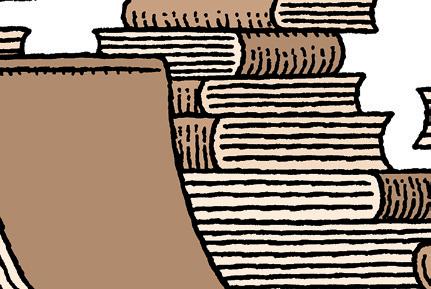



Increasingly the same can, alas, be said of Christianity. But nobody yet would consider churches eccentric, even though fortunes have been spent on them over the ages.
That said, this book is delicious. I love Fisher’s account of Beachborough Manor, which we know from a painting by Edward Haytley. We see its owner Squire Brockman leaning over his elegantly dressed daughter’s shoulder as she draws a temple he’s erected, while various other figures, including a clergyman, walk by his new lake.
Of modest size, the lake caused some head-scratching, according to a contemporary letter: ‘He wants some better name than that of pond … for he fears it is too small to call a Serpentine River, your father proposes he should call it ye Temple Pool or Sacred Pool.’
There are cattle in the meadow and

sheep on the hillside, showing that the Squire saw this as a productive as well as an ideal landscape.
He wanted to create his own Arcadia for himself and his family – a perfectly laudable ambition which doesn’t strike me as dotty at all.
David Garrick, the actor famed for having put Shakespeare on the pedestal

Clive Aslet salutes a new history of the sophisticated little buildings that have lifted spirits since the Elizabethans
he has occupied ever since, built a temple to the playwright; although now separated from Garrick’s house by a road, it can still be seen at Twickenham, beside the Thames.
It housed a full-length statue of the Bard which Garrick had commissioned from no less a sculptor than LouisFrançois Roubiliac, as well as memorabilia. Hogarth designed a chair from a mulberry tree that grew in Shakespeare’s garden at Stratford-uponAvon. Zoffany painted several scenes showing Garrick and his family, as well as his enormous dog; we see them fishing and having picnics.
Owning a riverside villa with a temple conferred status on a man whose early life had been so poor that he and his teacher in Lichfield, Samuel Johnson, had only one horse between them to make the journey to London. The temple was also a statement of his artistic values, in a context he held very dear.
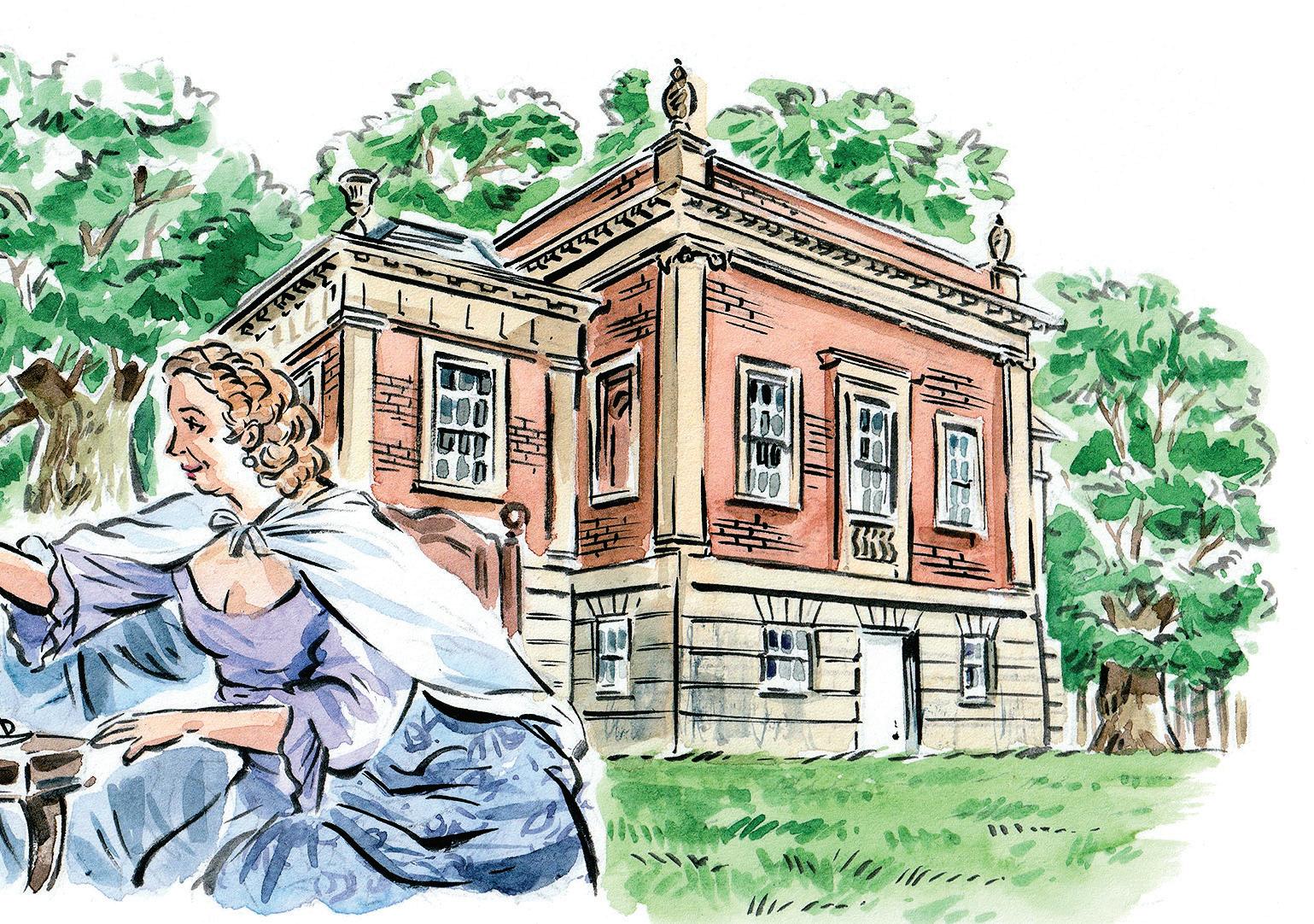
As a landscape feature, the folly came into its own during the Picturesque movement, which saw the creation of hundreds of parks around country houses. But follies were already being built in the Elizabethan period, when lawyers in particular delighted in setting their friends visual puzzles to work out.
These ‘conceits’ drew on the learning of the time, shared, to some degree, by every educated person, derived from the Classics and the Bible.
Some were built for courtly entertainments, some to eat in and some out of a sense of caprice – treehouses were popular. The triangular lodge at
Rushton, in Northamptonshire, built by Sir Thomas Tresham in the 1590s, was a statement of faith.
Father to one of the Gunpowder Plot conspirators, he had converted to Catholicism and wanted to demonstrate his devotion in the Trinity. Hence the three-sidedness, which also chimed with the first syllable of the Tresham name.
At Stowe, Buckinghamshire, Lord Cobham turned his folly-strewn landscape into an expression of his political philosophy. The busts in the Temple of British Worthies – Cobham’s heroes, from King Alfred to Newton –look across the lake (envisaged as the River Styx) to the Temple of Ancient Virtue, containing statues of figures from the classical world.
Originally there was a Temple of Modern Virtue – symbolically a fake ruin to depict the fallen nature of the times, over which Cobham’s nemesis, the Prime Minister Robert Walpole, presided in the form of a headless torso.
Virtue, modern or otherwise, was not always to the fore, since Cobham also had a Garden of Love, whose temple was decorated with erotic ceiling paintings and Latin poetry, providing a space for assignations or male ribaldry.
That suggests an overlooked motive
for folly-building: for people whose every move was normally observed by their servants, a temple, set by itself a good distance from the house, was one of the few places they could find privacy, whether for furtive meetings with the opposite sex or just for reading a book.
Occasionally, Fisher ventures beyond national boundaries to, for example, Bomarzo, the 16th-century condottiere Vicino Orsini, Duke of Bomarzo.
He created a garden of così stravaganti and phantasmagorias out of the volcanic rock there. It was dedicated to the memory of his wife Giulia Farnese, ‘adding a sense of doom’.
Enjoyable though these excursions are, I find them a bit random. And it’s disappointing that nearly all the contemporary follies cited in the last chapter – with the exception of the I M Pei Oare Pavilion in Wiltshire, built for the Keswicks, and the marvellous Charles Jencks’s Garden of Cosmic Speculation at his home in Dumfriesshire – are foreign.
There are plenty in this country. My favourite is the octagonal tower built by Nicholas Coleridge, chairman of the V&A, in Worcestershire. Designed by Quinlan Terry, it is somewhere drinks can be served, books read or written, and Zoom calls made. It was ready just in time for the lockdowns.
Eons ago, I spoke to the late Robert Heber-Percy, known as the Mad Boy for much of his life, about the folly Lord Berners built for him at Faringdon in 1935, on what became known as Folly Hill. To Berners – Nancy Mitford’s model for Lord Merlin in The Pursuit of Love – it served both to mark the birthday of a beautiful young man and as a neighbour tease.
An admiral became duly outraged, even though he could have seen it from his house only with a telescope. ‘It is my custom to look through a telescope at the view,’ he told an inquiry by the Ministry of Health.
‘What a marvellous present,’ I suggested to Heber-Percy.
‘Not really,’ he replied. ‘I would have preferred a horse.’
I recant. Some follies really are just eccentric after all.
The Story of Follies: Architecture of Eccentricity by Celia Fisher (Reaktion, £35)
Clive Aslet’s The Story of the Country House is out now. He is Visiting Professor of Architecture at Cambridge University
These ‘conceits’ drew on learning derived from the Classics and the Bible



A curse must have been placed on those teaching English at Oxford University.
Richard Ellmann died of motor neurone disease (MND), and never saw the publication of his Oscar Wilde masterpiece, which he’d been researching for 30 years.
The poet Mick Imlah, my contemporary, also succumbed to MND, aged 53. His posthumously produced Selected Essays (2015) is criticism at its finest. Humphrey Carpenter, the first-rate biographer, spent his last years ‘shaking, rattling and rolling’ (his words) from Parkinson’s.
Michael Gearin-Tosh, of St Catherine’s College, battled myeloma with (selfadministered) coffee enemas, or so he told me. I myself, once a junior fellow, am hardly a picture of rude health. On the seafront at Hastings, dogs bark at me as I halt by them.
Now we have Robert Douglas-Fairhurst, who makes ‘experiments with eye-liner and lip-gloss’ – so is a professor at Magdalen.
In 2017, he noticed he was stumbling and falling down the stairs more than usual. Fastening a shirt button, his fingers behaved ‘like clumsy sausages’. Fairhurst’s legs were ‘heavy and badly co-ordinated’.
His doctor’s diagnosis was blunt: ‘You have multiple sclerosis.’ The ailment, formerly known as disseminated sclerosis, wrecked the life of Jacqueline du Pré, the cellist, as well as Wilde’s wife, Constance, who’d complained of weakness in her right leg, headaches, extreme fatigue, tremors and vomiting.
Fairhurst endured a battery of scans and tests, which showed his brain and spinal column contained ‘hidden areas of inflammation’. That accounted for his drunken-seeming walk (or ‘steppage gait’) and uproarious digestion – ‘my guts turned to concrete’.
In medical language, Fairhurst had ‘demyelinating lesions’; ‘a pyramidal distribution of weakness in the distal upper limbs’.
A hot bath or hot weather (or cold weather) left him knackered. There were shooting electrical pains down his back if he moved his neck suddenly. Fairhurst’s nerves were misfiring or, as he poetically puts it, ‘My body was like a dying coral reef.’
Researching his disease, Fairhurst found only unpredictability and gloom.
The prognosis can’t be ascertained – some patients carry on for years; others are crippled within months. Susceptibility to the nasty symptoms also seems to be down to pot luck.
Who truly wants to know about a ‘life unworthy of life’, involving catheters and drainage bags, walking frames, fevers and infections? As Fairhurst says, in a matter-of-fact tone dusted with irony, ‘Control over the sphincter is so weakened that a return to nappies is required.’
As we all do these days, Fairhurst googles away, consults online blogs and chiefly discovers arrant nonsense. ‘It’s only through these changes,’ somebody (probably American) says, ‘that God can get our attention.’

Fairhurst the literary gent is put in mind of Kafka’s character in Metamorphosis, losing his human faculties and agonisingly metamorphosing into a beetle, or Beckett’s heroine in Happy Days, gradually buried up to her neck in sand.
Having multiple sclerosis, we are told, is like ‘being buried alive inside your own skin’. Only when we are proper poorly, like Fairhurst, do we appreciate how our bodies can decide to hate us. Every movement or thought meets obstacles: urinary retention, deterioration of speech, iritis, numbness and clumsiness, palpitations.
‘My tongue,’ says Fairhurst, ‘seemed to thicken and hesitate over even the simplest of sentences.’
Things we take for granted when young and healthy (Fairhurst is in his fifties) –the ‘functional systems’ enabling balance, sight, swallowing – all decide, as if on a mad whim, to deteriorate ‘little by little. You become a stranger to yourself.’
There is no cure for multiple sclerosis – only a brutal stem-cell transplantation procedure, to slow down the symptoms. Fairhurst spent months in hospital, undergoing bone-marrow grafts and other newish treatments. This was a year or so before the COVID pandemic, and he remains at huge risk from bacterial, fungal and viral infections.
At least, that he has written this surprisingly buoyant book suggests Fairhurst is still with us – even if he has had to become resigned to facing a future where he’ll be incontinent, unable to feed himself and condemned to sit in a wheelchair with ‘a frozen smile on [his] face’, the poor wretch.
Fairhurst is the author of a Lewis Carroll study, and is fully aware he has been sucked down the rabbit hole into the topsy-turvy kingdom of the chronically ill.
His conclusion? ‘It’s not death but the dreadful possibilities of life which are so depressing.’
Myself, I’d grasped something similar to that one when still a Mixed Infant.
Roger Lewis is author of Erotic Vagrancy: Everything about Richard Burton and Elizabeth Taylor, out later this year
Whatever Next? Lessons from an Unexpected Life
By Anne Glenconner Hodder & Stoughton £22As she enters her tenth decade, her spirits unflagging, her memory undimmed, and her patrician beauty unchanged, Anne Glenconner has clearly discovered the fountain of truth.
Four years after publishing her acclaimed autobiography, Lady in Waiting, and with a couple of novels in between, she has returned to her first subject and delved truthfully into that past.
She expands on the frequently distressing periods of her life, and in particular the mistreatment she suffered during her long and disturbing marriage to the waywardly charming though quixotically tempered Colin Tennant.
While, at the time, she hardly registered it as such – most people were barely aware such a ‘condition’ as being a battered wife existed – she was the victim of his mental and often physical abuse.
The mores of the period, and her family, insisted she grin and bear it. She maintained the grin by somehow making the public abuse ‘amusing … just Colin being outrageous’. After all, he was part of a famously eccentric family, and in those days men DID beat their wives, didn’t they? She bore his tantrums –thrown whenever he was thwarted – with speechless terror; this could lead to his spitting in her face.
Such outbursts were a mere
‘Now I only watch with the sound off’



curtain-raiser to future bodily assaults, and it becomes clear that Tennant was on the spectrum long before such a syndrome was universally recognised. Initially, to the author, much of this behaviour seemed to stem from his spoilt, uncontrolled childhood. While she gradually learns the truth, and suspects a latent gay tendency, there is a certain tenderness in her bewilderment.

There were shared periods of actual tragedy: the death of their two eldest sons, and the near-fatal accident of the third, which brought them close.
But one gets the impression that to Colin Tennant these were mere inconveniences rather than milestones of anxiety, and his ambivalence leads Anne to seek spiritual truth.
The subtlety of Whatever Next? is the matter-of-fact way in which Glenconner tells her story. Totally free from self-pity and any form of whining or fashionable woke views, she writes with an absolute, almost childlike, truth, and is not afraid to include her own liaisons.
In fact, one is deeply relieved to read she had an intermittent, but steady, lover over many years.
Above all, she never points fingers at any gods or mortals who inflicted such tragedies, many of which she bore in composed silence until her close friend Princess Margaret, who had had marital problems along the same lines, told her, firmly, to man up.
The time and circumstances of her youth preordained Anne Glenconner to be an innocent. In adulthood, the privilege of her role in the late Queen’s coronation added romance and allure. Her marriage brought heartbreak, histrionics and humour.
She matured, shielding the truth from herself and others. Having learnt the whole truth, she reveals it, in this book, with total honesty.
In an age of TikTok and lies, that honesty has made her not only a
worldwide bestseller, media star, lecturer and agony aunt but a gay icon to boot. With typical elegance, she blames no one for her innocence – least of all, fittingly, herself.
Nicky Haslam’s new tea towel – ‘Even more things Nicky Haslam finds common’ – is available now
The title page, and its verso, come dotted with little stars. How could they not be?
They are there not only to show that Elizabeth Taylor was a star, who outshone other stars, but I think also to suggest the jewellery she loved so much, lavished on her by so many husbands. Ah, so many husbands…
She once showed off a new ring to her ex-husband, Richard Burton (ex-exhusband? ex-ex-ex-husband?), which was slightly smaller than her usual baubles, but still in the double-digit-carat range. He said, ‘You on a diet, luv?’
By the way, this is the kind of book in which the carats of her diamonds, and sapphires, and whatnots, are measured to two decimal places. And again: how could they not be?
Her weight was an issue for much of her career in a way that seems strikingly hypocritical even for the times, for her body was very much an asset. Burton
described her breasts as ‘apocalyptic’, which is at least original.
Various creepy, religious-based busybodies who had a stranglehold on the production of Hollywood films would scrutinise her embonpoint. During the shooting of Cat on a Hot Tin Roof, she was visited by a BI, which actually stands for Bust Inspector. He asked for a stepladder, looked down, and declared that if they wanted to continue filming, she would have to have a higher neckline.
By that stage of her career, she had had enough of this nonsense and ignored him.
During the making of Suddenly, Last Summer, talk of her weight gain was going round the set. The producer, Sam Spiegel, said, ‘If Elizabeth Taylor is overweight, I for one am at a loss to suggest what there should be less of.’
Throughout the first third of the book, I wondered, at which point does she go mad? For, after all, how could she not?
She had been a star since National Velvet, when she was 12. When she was 17, MGM centred its publicity campaign around the claim her next film would feature her first actual kiss.
She had a mother who was so monstrous that she arranged for an operation that would determine whether she was a virgin or not. Only Marilyn Monroe had to deal with such ogling, and look what happened to her. Taylor said she was afraid of getting old. Joan Collins said the problem with beauty is that it’s like starting out rich and getting poorer.
I pinpointed the moment when the world got too much for her and took her off her hinges: in March 1958, when she learned that her husband, Mike Todd, had died in a plane crash. Very slight





variations of the sentence ‘Meanwhile, her marriage to X was unravelling’ occur throughout the book – but not with regard to Mike. They weren’t together for long, which might have had something to do with it, but he was the kind of man she liked: tough, domineering and ludicrously rich. He would buy Pissarros and Picassos to liven up her hospital room when she needed an operation, even when there were already plenty at home.
She dropped the need for wealth when she married Larry Fortensky, a construction worker she met in rehab who also happened to be 20 years her junior. That marriage unravelled.
But the real question is not when she went mad (early sign: dyeing her poodle to match her eyes for her first marriage) but when the world went mad. The maniac degree and intensity of the public’s appetite for her was boundless, and has no rival today that I can think of. It would have driven anyone off the rails.
Her idea of a good time came to be getting into a punching row with her latest husband and then rushing upstairs to have make-up sex. Not all the men she married liked that; her marriages to them unravelled.

But there was no wickedness in her. The director Mike Nichols said, ‘There are three things I never saw [her] do: tell a lie; be unkind to anyone; and be on time.’
If you were damaged and crossed her path – Montgomery Clift, Michael Jackson – she would be your friend. She stuck up for homosexual men at a time when it was considered unwise to do so. Lord knows how many lives she saved with her AIDS charities.
She was in a way monstrous; but one of the good ones. This book is unputdownable.
Nicholas Lezard is author of It Gets Worse: Adventures in Love, Loss and Penury
In the muscular movie Gladiator, which I recently re-watched with my far-tooyoung son, the hero Maximus harangues the jaded Roman spectators. ‘Are you not entertained?’ he bellows, after butchering his rivals in the arena. To his surprise, he finds they are.
Yet what made that film a hit in 2000 wasn’t, I think, just the bloodshed. It was also the vision it presents of a noble ideal behind Roman imperialism. ‘I have seen much of the rest of the world,’ Maximus observes earnestly. ‘It is brutal and dark and cruel. Rome is the light.’
That same light is now the theme of Christopher Hadley’s richly-written book about Britain’s Roman roads. As he notes, the dazzling feat of engineering and logistics, which created 50,000 miles of such roads across the European continent, wasn’t surpassed until the age of the railway. How did they do it? Why did they do it?
To explore these questions, Hadley picks a Roman road – rather a short one, in point of fact, the 14-mile route between Braughing in Hertfordshire and Great Chesterford in Essex. He has walked it many times over the years, and cobbles these strolls together into what reads like a single excursion, while pondering the past.
We pick up some wonderful things along the way. As a Thomas myself, I was thrilled to learn that the word Thomas can be used as a verb. On the feast of St Thomas on 21st December, the poor and aged used to wander door to door, begging for scraps so their Christmases might be bearable. This was known as ‘going a-Thomasing’.
I was similarly consoled, as I went a-Thomasing through this book, to be gifted the information that thousands of leather soles have been found by Hadrian’s Wall, which date back to the Roman occupation in the first four centuries AD.
I was gratified, too, to read about ‘Greek foot’, which is when your longest toe isn’t your big toe, but the next one along. This was an ideal of beauty in
those times. I instantly doffed my sock to see if I qualified. Enragingly I didn’t – but my wife did.
Overall, though, I felt I was depending on alms while I read this well-appointed volume, instead of being treated to a feast. I couldn’t work out why the author had chosen this road especially, rather than any of Britain’s four longer, more storied Great Ways: the Fosse Way, the Icknield Way, Watling Street or Ermine Street.
If it was near Hadley’s home, and if he was restricted from travelling further by lockdown, we never learn. He mentions that, according to Oliver Rackham (the ‘great historian of English landscape’), the lesser-known ways may be more ‘eloquent’. We get no better answer than this.
Like most art, The Road takes a synecdochic approach, using a part to represent the whole. Zoom in on this short stretch, it promises, and you shall understand the entire Roman-road map.
Yet the preference for a lesserknown way feels trendy. Too often, nowadays, we single out the example, the voice or the perspective that has been systemically overlooked, regardless of whether it can bear the weight of scrutiny.
When it does, the results are extraordinary. Here it doesn’t, for reasons I suspect are partly rooted in familiarity blindness. The author, who knows so much, loses sight of what’s necessary. He doesn’t caption his pictures or signpost in the text when we may find a note at the back of the book.
For me, he sells us short on human stories.
I wanted to be told more about Eric Stacey, the teenage archaeologist; Edward Thomas, the poet who



walked the Icknield Way; and Ivan Margary, the doyen of road-hunters, who also, I later learned, donated a quad to Exeter College, Oxford.
Hadley, whose last book, Hollow Ways, earned great acclaim, has a descriptive more than a narrative gift. He showers us with lovely Anglo-Saxon words such as berm, hoggin and smoring. But when he remarks that it’s hard to tell from Margary’s Roman Roads in Britain that roads were the author’s passion, I immediately thought that the same could be said of his own book.
Hadley loves the English countryside, but it’s not clear he feels the same about Roman roads. When it comes to their proverbial straightness, for example, he can barely bring himself to talk about it, calling the subject ‘tedious to all but a few enthusiasts’. This is clearly wrong: it is interesting to all but a few enthusiasts.
It was at that point that my imperial thumb turned upwards (the sign to execute gladiators, rather than the thumbs-down). I’m sorry to say it, but I wasn’t entertained.
Rory Knight Bruce was one of Fleet Street’s characters in the 1980s and ’90s: a bit of a legend in his own lunchtime.
A Puck-like, Will-o’-the-wisp Withnail in everyone’s peripheral vision, he seemed to appear from nowhere, leaving a trail of larger-than-life pranks, triumphs and more frequent disasters, which fuelled drunken gossip to everyone’s amusement.
For a period, he edited that prepschool of posh journos, the Evening Standard’s Londoner’s Diary, from where he sallied forth nightly to terrorise society and browbeat complainants.
And then he was gone – rumoured to have become a Master of Foxhounds somewhere in the great blood-drenched Valhalla that is the British countryside.
Twenty pages into An Unanchored Heart – a suitably 1930s-ish-sounding title, being both dated and poignant – the reader can admire the pace and vigour of his prose. Forty pages in and one begins to tire, along, one suspects, with the author himself, who resorts to somewhat gratuitous name-dropping and extensive, italicised quotes from what are, presumably, earlier pieces of journalism.
‘So I took the wife’s family out for tea and biscuits yesterday. They weren’t too happy about giving blood, though’
Being the lovable rogue he is, Knight Bruce barely disguises his impatient exasperation – and readiness to do almost anything – to get the word count up to book length.
What starts as a rollicking mash-up account of Hunter S Thompson/ Rabelaisian individualism set in Cold Comfort Farm becomes a toff version of the misery memoir. It is Shuggie Bain, but set in Devon and Kensington High Street and without the jokes.
In an episode early on in this strange and melancholy memoir our hero narrator is cruelly teased that his favourite (and blind) pet goat has to be slaughtered. Rather than show distress, the barely toddling child goes out and dispatches the animal himself with a gun.
A few sentences before, he describes slaughtering a much-loved pig with a knife. Aged five. Such Grand Guignol events – illustrating the author’s defiant courage in the face of horror – pepper the book.
Elsewhere it is his gargantuan libido that is put on display. When a girlfriend, catching the author in flagrante with a schoolgirl, confesses her own infidelities, he recalls, ‘I monstered her in groves of olives, on rocks and dusty grass with proprietorial revenge, [with] donkeys and widows watching and some passing hikers outside a church we did it in – thrice.’
Monstered seems quite the appropriate verb but also, perhaps, provoking a Matilda-like reaction that makes one gasp and stretches one’s eyes.
The nub of the thing appears to be his threadbare relationships with a gruff, alcoholic war-hero father and his everabsent, ever-glamorous TV-presenter mother – all gin, fags and Bentleys – along with endless changes of address.
Knight Bruce recalls his Proustian
Madeleine-moment coming on his overhearing his mother’s reply to a lunchtime guest’s question as to whether Rory had been ‘an inconvenience’. She replied, ‘Yeah, baby,’ before extinguishing her cigarette in a butter dish.
Two parental monsters then perhaps beget another, explaining and excusing our hero’s gadfly life. To offset them (and get to the end), he spatters the book with a genuine knowledge – and love – of the countryside, a Grand Tour of his favourite haunts in all the nations of the British Isles, and copious evidence of his erudition.

Chapters begin and sometimes end with quotes from Turgenev, Zola, Oscar Wilde, Dryden and A E Housman, bulked up with bathetic offerings from the Beatles, Deep Purple and Genesis (the latter of rock ’n’ roll rather than Biblical fame). None appears too deeply linked to the body text.
This being a gossip columnist’s memoir, celebrities regularly rear their pampered heads.
Much time is spent with Paddy Leigh Fermor, and at his Peloponnese retreat, both before and after his death. Harold Acton inevitably crops up, and there is much on John Osborne, who first appears as a chummy lunch companion and then, later, more characteristically, howling abuse.
Grouse butts full of minor Scottish lairds appear. There are toga parties attended by politicians and, in Wales, gurning huntsmen are meshed with Fleet Street grandees, all guests in KB’s rural slum conditions.
The author’s finest Fleet Street hour – when he gatecrashed Martin Amis’s book launch by spending several hours in a broom cupboard – ends with a dying fall.
His story, he proudly relates, was entitled ‘How I Gate-Crashed a Martin Amis Novel’ – a reference to the loathsome gossip-columnist character in The Information named Rory Plantagenet’s being based on Knight Bruce.
Nothing interesting was recorded at the party itself.
A certain heartlessness seems to be at the bottom of a book that fails to mention in any depth either of Knight Bruce’s wives, both of whom, no doubt, would feel that Unanchored alone would have made a better title.
All that said, like its author, it’s fun –if you like that sort of thing.
Ivo Dawnay was Washington Bureau Chief for the Sunday Telegraph



Either the camera will dance – or I will. Fred Astaire on how to film his dance sequences
Beauty is not the only thing in life. Money, power, intelligence, humour … these are forms of beauty, too.
Charles Aznavour
The rules [of manners], laid down clearly, reached back to a time before we could remember, so that following them wasn’t painful.
Diana AthillFor Americans, the most important thing is to be sincere and the worst is to be pretentious. For the British, the most important thing is to be sincere and the worst is to be boring. But, for Americans, English witticisms are pretentious and, for the British, American sincerity is boring. An anonymous Cambridge professor on his return from teaching at Harvard
It was not till 887, when he was nearly 40, that King Alfred began to read and translate Latin.
Asser, the medieval historian
Designed for evolutionary advantage. The Sunday Telegraph on the actress Jane Russell (pictured)

Childhood does not gather enough experience to satisfy memory in wistful age. Tim Hilton
I hate to sit at bus stops, since I am one of those people who believe, against all the evidence, that if you look hard enough up the road for a bus, it will miraculously appear.
Francis King
I have come to believe that my experiences on the geographical trail have been almost as important in practising the art of biography as my hours spent in archives.
Lady Antonia Fraser on ‘Optical Research’ in biography
While I still have got breath in my lungs, I will tell you what a dandy car you make. I have drove Fords exclusively when I could get away with one. For sustained speed and freedom from trouble, the Ford has got ever other car skinned and even if my business hasen’t been strickly legal, it don’t hurt enything to tell you what a fine car you got in the V8.
1934 letter to Henry Ford about Ford cars from Clyde Barrow, as in the bank robbers Bonnie and Clyde
Tâchez de devenir un oeil. (Try to become an eye.)
Flaubert’s advice on writing
Death is the black backing on the mirror that allows us to see anything at all.
Saul Bellow
Novelists presuppose a world of people interested in human relationships.
E M Forster
At home, I could gladly sit for hours, wrapped in a filthy dressing gown and filthier daydreams about myself, but I became restless when I had nothing to occupy me in other people’s time. I was always clamouring for work.
Quentin Crisp
I was a beautiful journalist. It was easy to meet people.
Disabled? Can’t drive? Then the person who cut the branches and uprooted the roots could do it.
Green bins Green bins make me see red.
The owner of the bin is throwing away a valuable resource – brown gold – and paying someone (about 50 quid a year) to take it away.
Some garden waste needs to be removed: branches, roots and so on. But that can be done via an occasional trip to the municipal tip.
How angry I am to see owners of big fat Volvos unloading grass cuttings at the tip. Why not put them on your very own compost heap? Or, better, leave the cuttings on the grass to nourish the next generation.
There’s really no need for green bins. Most green bins contain grass cuttings, leaves and weeds – all ideal for a compost heap. If a garden is big enough to have a lawn, flowers and shrubs, it’s big enough to accommodate a compost
Barbara Taufer
bin. Compost is the lifeblood/ life earth of a garden. It’s a living demonstration of nature’s cycle and, incidentally, a reminder of our own mortality.
A compost heap requires no expense. If tidiness is your thing, a nice plastic (recycled) or wooden bin can be had for less than you pay
Splashing in rain puddles, Gene Kelly-style, when no one’s around.

ALAN RICHARDS. LLANFAIRFECHAN, CONWY
Email life’s small delights to editorial@theoldie.co.uk
the council to empty your green bin. And there are those wonderful, expanded polypropylene ‘hot’ bins which produce temperatures of 40-60°C.
Admittedly expensive, they have the advantage of taking food waste and producing black gold in a few months. So there’s no need for those millions of little (plastic) food bins that decorate our pavements. We should recycle plant material in our own back gardens.
We should all play the circle game.
So don’t see red. Discard green bins in favour of black gold and earn yourself some brownie points.
 NICHOLAS NORWELL
NICHOLAS NORWELL
From the Armada to the Battle of Jutland, weather drove history david horspool

Britons are obsessed with the weather, so why doesn’t it play more of a part in our view of history?
As far as British history is concerned, that might be because extremes of weather have been quite rare. By the standards of the tropics, or the unforgiving polarities other countries have to put up with, we are, or at least have been, pretty lucky.
That is not to say that weather hasn’t played a part in our history – or been assigned one by historians and chroniclers when convenient. A book to be published later this year by the global historian Peter Frankopan – The Earth Transformed – set me thinking.
Frankopan’s canvas is as broad as it possibly could be: the whole of human history across the whole globe, tracing interactions between environment, climate and historical change.
But he also remarks that, at the level of the individual historical event, we tend to ignore the part weather plays. He gives as an exception the original kamikazes – ‘divine winds’ the Japanese said kept Kubla Khan at bay – and Russia’s General Winter, popularly believed to have done for both Napoleon and Hitler.
In both cases, Frankopan suggests myth-making has a lot to do with our understanding. The kamikaze played into a later providential view of Japanese history, while supply lines, strategy and communication had more to do with Napoleonic and Nazi failure than snow and ice.
A third example – Xerxes lashing the storm-tossed Hellespont when it hindered his Persian fleet’s invasion of Greece – Frankopan sees as a likely bit of orientalising; a story told to emphasise the tyrannous barbarism of the foreign king. In fact, the story that a storm destroyed Persian bridges doesn’t seem beyond belief. In any case, it didn’t stop Xerxes; merely delayed him a bit.

The weather used to play more of a part in our historical imagination, though. Before modern conveniences improved our lot, from housing and heating to roads, electrification and communications, we had to pay more attention to it.
More of us worked the land, too. Even in 1851, there were almost twice as many people employed in agriculture (1.7 million) as in the next biggest sector, domestic service (just over 1 million).
For many years, the British celebrated their own kamikazes – ‘Protestant winds’. They not only blew the Spanish Armada off our shores in 1588 but, 100 years later, blew William of Orange on to them – a helpful easterly brought him to undefended Torbay.
The Protestant Wind crops up elsewhere in Britain’s historical mythology. It’s mentioned in the marching song Lillibullero (‘Ho by my Shoul ’tis a Protestant Wind’), where it was blowing a Catholic – the Earl of Tyrconnell – away, rather than a Protestant in.
And it blew again in 1796, when the French first attempted to invade Ireland at the request of the United Irishmen.
For a maritime nation, wind is a perennial issue. So is fog. The most famous part played by misty conditions in British history was at the Battle of Jutland in the First World War, when the combatants often had little idea of what was happening all around them.
As one seaman described the battle, ‘I remember we could hear the firing and
firing. But it was so misty we didn’t see the actual ships.’
What about our favourite climatic condition, rain? Has that played a part in our history, or are we so used to it that we hardly notice?
The most catastrophic example dates back to 1315, when it rained for months, beginning in the spring and continuing with barely a break through into the New Year. Crops were ruined, starvation was rife and famine spread across Europe.
Historians think this unusual weather was part of the transition between two climatic periods – the Medieval Warm Period and the Little Ice Age – and due also to the eruption of a volcano in New Zealand, neither of which people in the 14th century had any clue about. They viewed it as a judgement from God.
There is one instance when rain changed the course of high political history. In 1483, Richard III’s erstwhile ally the Duke of Buckingham started a rebellion against him from his estates in Wales. His uprising failed in large part because it rained so much that he was unable to cross the River Severn to join his brother, combine forces and march east. Buckingham was tracked down, tried and executed by a vengeful king.
But Richard couldn’t rely on the weather for ever. One of the conspirators who failed to join up with Buckingham was Henry Tudor, unable to land from Brittany because of the same storm. But he came back.
General Rain, it turns out, is rather less mighty than General Winter.
One successful British export to the United States is journalists. They don’t attract any tariffs under World Trade Organisation rules.
The latest person to be dispatched westwards is Emma Tucker, who is swapping the editor’s chair at the Sunday Times for that at the Wall Street Journal. Both titles are owned by Rupert Murdoch.
Though not an experienced financial journalist, she has her admirers in Fleet Street, and may bring a lighter touch to a business newspaper that can still be rather stodgy.
Actually, while Ms Tucker is the first woman to be appointed editor-in-chief of the Wall Street Journal, she isn’t the first Briton. Her predecessor but one, Gerard Baker, also hails from our shores. Murdoch’s most senior executive in the US, Robert Thomson, is an erstwhile editor of the Times, though born in Australia.
Emma Tucker is the latest in a long line. Perhaps our most famous modern journalistic export is Tina Brown, who edited Vanity Fair and the New Yorker. Written off by American old-guard journalists as a brash and vulgar knownothing, she revitalised both magazines, which had grown self-satisfied and slightly boring.
Her late British husband, Harold Evans – a former editor of the Times and Sunday Times – edited the Atlantic Monthly. Other notable British exports include Anna Wintour, who has been editor-in-chief of Vogue since 1988, and Joanna Coles, who edited Cosmopolitan before becoming ‘chief content officer’ of the magazine’s parent company, Hearst.
The list goes on. The current editor-inchief of the Murdoch-owned New York Post is Keith Poole, who cut his teeth on the Mail and the Sun. Its rival, the New York Daily News, was once owned by our own ghastly Robert Maxwell, and in more recent times was edited by Britishborn Colin Myler. Will Lewis, former
editor of the Daily Telegraph, until recently worked in the US for Murdoch, who seems to prefer British (or Australian) journalists to American ones.
Nor should we forget Tory columnist Henry Fairlie, credited by some with coining the term ‘the Establishment’. He left Britain in the mid-1960s, escaping a libel suit. Fairlie ended his days at the New Republic magazine, where I briefly met him (for once, he was passably sober) in the late 1980s, not long before he died.
This is my question. Where are the American journalists in the British press? I can’t think of any, though there may be one or two. You may point out that the stage is bigger in the US, and therefore alluring to some of our journalists in a way Britain may not be to transatlantic hacks. But although the pay is better on American magazines than on British ones, I doubt this is true of newspapers.
The fact is that some American publications feel a need for the technical skills, humour and irreverence of British journalism. I’m thinking not of papers such as the sententious and prolix New York Times – though some years ago it hired Mark Thompson, ex-directorgeneral of the BBC, as chief executive –but of those that have some interest in the entertainment business.

Perhaps unsurprisingly, a few American journalists resent the invasion of their more light-hearted British
cousins. Alexander Chancellor, The Oldie’s former editor, was once a victim of such jealousy. Hired by Tina Brown to write the Talk of the Town column for the New Yorker, he eagerly noted that a huge Christmas tree had been erected in Rockefeller Center, unaware that this was a long-standing annual occurrence. Pompous American hacks had a field day.
Maybe there are some things we still do better than the Yanks, or at any rate with more brio. Thanks to the digital revolution, Americans can now read British journalism in the form of Mail Online and Guardian.com, both spectacularly successful in the States.
One way or another, exporting journalism is a British success story.
As for Emma Tucker’s successor at the Sunday Times, the world has assumed that her deputy, Ben Taylor, is a shoo-in.
He may well be, though as I write no appointment has been announced. One rumour is that Geordie Greig, defenestrated as editor of the Daily Mail just over a year ago, is making a last-minute run to attract Rupert Murdoch’s notice.
Admittedly, Greig is frequently the subject of gossip. In recent months, I have been told he is part of a consortium bidding for the Daily Telegraph. If this was ever true, that trail has gone cold.
Would Murdoch prefer the Old Etonian biographer of Lucian Freud to Taylor, a highly capable and driven executive, who left the Daily Mail for the Sunday Times in 2020 after 22 years on the mid-market tabloid? You certainly wouldn’t imagine so.
‘What do we want to remember from this meeting other than being happy it ended?’
But perhaps Geordie Greig reaches parts of Rupert Murdoch that Taylor doesn’t. He has experience of running a Sunday newspaper, having been editor of the Mail on Sunday for six years, and may possibly have worked his wiles on the increasingly intellectually sophisticated media tycoon.

ALLELUJAH (15)
Released on 17th February
‘The weasel under the cocktail cabinet’ –that’s what Harold Pinter said his plays were about. Well, Alan Bennett’s plays are about the rock in the rock bun.
By his own admission, Bennett isn’t the cuddly national treasure he’s often hailed as. His plays are so original and funny because of the dark seam beneath: the cynicism and paedophilia of the teachers in The History Boys, say, or the ruthlessness of Bennett’s motives behind his apparent kindness in taking in the lady in The Lady in the Van.
That’s why Allelujah is a rare dud from Bennett, now 88. Yes, there is a dark undertow in this 2018 play – his tribute to the NHS, now adapted for the big screen by Heidi Thomas and directed by Richard Eyre.
But the darkness is washed over by a gushing paean of praise to the health service, as told through the story of a traditional Yorkshire hospital, threatened with cuts by the wicked government.
Sister Gilpin (a subtle Jennifer Saunders) is the heroic senior nurse keeping the


hospital going through guts, willpower and no-nonsense common sense.
Ranged against her is Colin Colman (Russell Tovey, giving a nuanced, low-key performance), the government adviser set on closing down the hospital. That is, until he sees his father, former miner Joe Colman (a wonderfully grumpy David Bradley), dying in the hospital and receiving first-class care.
Well, it seems first-class until – and here the darkness creeps in – a patient, Mary Moss (Judi Dench, masterly in her supposed innocence and nervousness, masking wise sharpness), spots that all is not as heroic as it might seem in the running of the hospital.
I can’t reveal what the dark seam is, without revealing the whole plot. But it isn’t dark – or sophisticated – enough to prevent the film from becoming too much like agitprop.






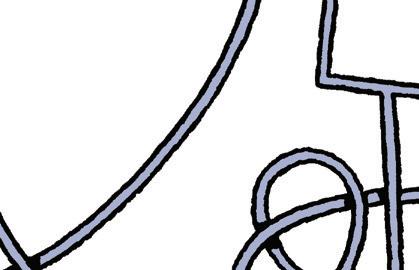


Alan Bennett’s laudable, altruistic views are all there on show in his compelling diaries, published each year in the London Review of Books. But they are usually kept out of his plays. Here there is a fatal bleeding of those views into what’s supposed to be a comedy –and the combination doesn’t gel.
The play came out just over a year before COVID struck. And so a hastily-
written postscript has been shoved into the film. The angelic young Dr Valentine (a bland Bally Gill) berates the Government for bashing the NHS when it battled so nobly through the pandemic.
All very admirable – but it makes for a clumsy bolt-on to the film and adds nothing to its drama. Some of the lines about the NHS are positively cloying: ‘We are love itself and, for love, there is no judge.’


The comedy also falls a bit flat. The big guns have been brought in, from Derek Jacobi to Julia McKenzie. But they aren’t as funny as Kenneth Williams as Dr Tinkle or Sid James in Carry On Doctor (1967).
And music-hall lines like these, that would work on stage, don’t land so well in the increased realism of film:
‘I had ten men under me,’ says one character of her career.

‘So did I – on a good day,’ says another.






There are some quite good lavatory gags. But the moving lines about death (‘Don’t leave it too late to die’) never really melt the heart, the way Bennett can do at his best – when he combines a more appealing strain of sentiment with some of the funniest lines in English literature.
Yorkshire rose: Gerald (Ross Tomlinson) in Allelujah
Garrick Theatre, until 25th February
‘The true length of a person’s life, whatever the Dictionary of National Biography may say, is always a matter of dispute.’
That’s Virginia Woolf’s surreal premise of her novel Orlando, about an androgynous Tudor nobleman who lives through several centuries without ageing, and ends up in 1928, the year this fantastical ‘biography’ was written.
It was inspired by the family history of Woolf’s lover, Vita Sackville-West, brought up at Knole, Kent, and later to revitalise Sissinghurst with her husband, Harold Nicolson.
Stories about time travel are always entertaining. What makes Woolf’s yarn so fashionable is the ambiguous sexuality of its hero – or heroine.
On his/her journey through the ages, Orlando falls in and out of love (and in and out of bed) with a bewildering variety of suitors, and even changes gender –becoming magically transformed from a man into a woman.
‘Gender fluidity’ is a terribly hot topic nowadays. Suddenly, all sorts of people are insisting you use particular pronouns to describe them, and people on both sides are getting terribly upset. A century since she wrote it, the radical ideas in Woolf’s groundbreaking book are now centre stage.

The only trouble is it’s such a difficult book to read! Whisper it in Bloomsbury, but I reckon it actually works better as a play.
This isn’t the first stage adaptation, but you’ll wait a long time for a better one. It’s written by Neil Bartlett, whose decade as Artistic Director of the Lyric Hammersmith re-energised that fine theatre. Like all the best playwrights, he really understands the mechanics of the stage.
Bartlett knows it’s not enough merely to put Woolf’s prose into the mouths of actors. He realises that on stage, actions speak louder than words. Despite its big ideas, Orlando never takes itself too seriously. A play that could so easily be bogged down by verbose dialogue is full of light and grace.
Some of Bartlett’s theatrical devices are inspired. Virginia Woolf is played by eight performers simultaneously, all talking over one another – a perfect metaphor for the weird multiverse of Woolf’s time-travelling tale.
Director Michael Grandage keeps all
his actors on their toes. They all look as though they’re having lots of fun and their enjoyment is infectious.
Deborah Findlay is especially engaging as the show’s affable narrator, Mrs Grimsditch. Emma Corrin’s Orlando is wonderfully complex, a tangle of paradoxical emotions – by turns supremely cocky and painfully insecure.
Watching Corrin’s mesmeric performance, I understood, for the first time, the true meaning of Orlando.
It isn’t about whether we want to ‘identify’ as male or female. It isn’t about being gay or straight. It’s about something far more profound. It’s about all the other people we could be – or could have been. We all have multiple personalities, but most of us never discover them. What a shame we can’t be like Orlando, roaming across the centuries, trying out all the different lives and lifestyles we might have led!
Yet, in spite of all these riches (acting, directing, scripting – all first-rate), the show never quite caught fire. Maybe it was the train strikes or the cold weather, but the atmosphere in the auditorium was, although attentive, subdued.
I should be reviewing the actors, not the audience, but if I’m going to recommend a show, I feel it’s only fair to warn you it won’t be everybody’s cup of tea. If you know a bit about Virginia Woolf, it’s fascinating – but I wonder how much sense it would make to someone who’d never heard of her. Not a lot, I fear – and surely that’s a weakness.
However, for anyone who’s at all interested in Woolf’s writing, this Orlando is a must-see. Why are so many people right now so preoccupied with sexual identity? It’s a mystery to me – I find the whole thing utterly perplexing –but, whatever your point of view, the stage is a far better place to explore these issues than the bear pit of Twitter.
‘The past shelters us on one side and the future on another,’ Woolf said.
I think she’d be amused by how topical her antique story seems today.
RADIOOnly a month ago we were mourning the sudden death of Andrew Nickolds.
He was co-creator of Ed Reardon’s Week, the best satire on a freelance writer’s life since – well, since George Gissing’s New Grub Street, on whose character Edwin Reardon the modern Ed was based.
Now, even before Andrew’s ashes have finished smouldering in a Cambridge crematorium, we hear of the death, in Bruges, of Victor Lewis-Smith at 65.
There is a species of humour that flourishes at the BBC despite its exploitation of the corporation’s pomposities and absurdities.
The late Ned Sherrin, Clive Anderson, Russell Davies and Ian Hislop all practised this: as did the late lamented Humph, Spike Milligan, Willie Rushton – and indeed the whole I’m Sorry I
Haven’t a Clue team. To satirise without belittling, mock without deflating – and cut down boundless narcissism wherever it appears.
The genius of Lewis-Smith, who wore his hair in dreadlocks, was his fantastic dexterity with the airwaves. His gift to radio comedy, much replicated by others (eg Down the Line), was the hoax phone call. He rang Princess Diana in the mechanical voice of Stephen Hawking, and got her to share her feelings. He rang the Jim’ll Fix It show in the guise of a father whose small daughter wanted to get into TV. He would ring the Broadcasting House foyer and get them to Tannoy General Pinochet – which they did, replying that General Pinochet had not responded.
‘Well, if you find him, could you please ask him to hold his fire until there’s been a reasonable discussion with NATO?’
He parodied BBC news bulletins in which the only deaths that get a mention are those of TV actors – so he invented ‘the truthful news’: ‘Some poncy actor has kicked the bucket after putting up not much of a fight. Tributes have trickled in, including one from his mother.’
Lewis-Smith also compiled the Funny Old World column in Private Eye, wrote scathing TV reviews for the Evening Standard and, with his straight hat on, produced Start the Week YouTube offers some gems among his phone spoofs. I recommend the first episode of the Victor Lewis-Smith radio show from 1990, which includes a lovely piece of monotone Michael Nyman/ Philip Glass-style music including the line ‘laughing all the way to the bank ha-ha-ha-ha-he-he’.
I’m glad to hear from Christopher Douglas, who plays the harrumphing Ed Reardon, that a 15th series will go out on Radio 4 this summer. So Ed is not dead, but grumbles bitterly on.
I asked Douglas, now a ‘comedy widow’, how he and Andrew Nickolds met. Douglas left school at 15 and became the back end of a donkey in Porthcawl. In 1980, he wrote a radio play. Nickolds – who had edited Varsity at Cambridge, and co-wrote the monologues for Ned Sherrin’s Loose Ends – admired the play and got in touch.
The two met for lunch, and from there it was lunches and laughter all the way. For a while, they inhabited a workshop space in Soho shared with cartoonists David Austin, Kipper Williams and Nick Newman (the latter two still going strong in The Oldie). I love these interlinked comedy networks.
‘We remained astonished,’ Douglas
told me, ‘that we could be paid (albeit poorly and very late) for turning our misfortunes and those of our fellow writers into material.’
Last year brought us many terrible stories, graphically told by bereaved parents of murdered young women, and other coverage from war reporters such as Orla Guerin and Jeremy Bowen. One day, when the temperature was zero degrees and the news unrelievedly awful, into the PM programme Evan Davis injected some timeless literary moments, including ‘The hare limped trembling through the frozen grass’ from Keats’s The Eve of St Agnes, and Louis MacNeice’s Snow
Both bliss.
How’s that for synchronicity!
No sooner have we recovered from six hours of the self-pitying, selfpampering Duchess of Sussex speaking her truth from a sun-drenched Californian mansion (Harry & Meghan, Netflix) than we are hurled headlong into Versailles, circa 1770.

Marie Antoinette (BBC1), created and written by Deborah Davis (who also wrote The Favourite), is the latest attempt to rebrand the most hated woman in France. In Davis’s version of history, the Queen, ‘free, independent and feminist’, tries to drag the fusty monarchy into the modern age.
The analogies between Marie Antoinette and the self-image of Meghan Markle are there for the asking:
the innocent girl transposed to the hostile foreign land; the drippy husband; the poor press relations; the airless world of protocols; the spying, plotting and scheming of the court.
When Meghan feeds her hens, there is an echo of Antoinette’s perfumed farm at the Petit Trianon. When Meghan says that she was required, when conducting her royal duties, to wear a palette of beige and brown so as not to clash with any brighter colour that the ‘senior’ members of the family might be wearing, we hear Madame de la Tour du Pin’s description of Antoinette’s plain ‘everyday’ gowns: ‘elaborately decorated and absolutely covered in diamonds’.
In her book Queen of Fashion: What Marie Antoinette Wore to the Revolution, Caroline Weber examines each of her sartorial choices, showing how, whatever she wore, especially when she dressed ‘simply’ like one of the peasants, ‘her costumes triggered severe socio-political disorder’.
Meghan also likes a fashion statement. For most of her documentary, she wears white, like Antoinette in the portraits by Élisabeth Vigée Le Brun. When she was introduced to Kate Middleton, she opted for bare feet and ripped jeans. Kate, meanwhile, had scrubbed up for the occasion, which was, Meghan recalls, her first indication of Royal stuffiness.
The Duchess of Sussex and the French queen differ in the instruction each received in the art of the curtsey. While Marie Antoinette (Emilia Schüle) is shown in the first episode practising her dip before being transported from Vienna to Versailles, Meghan, having
not been informed that she was required to bend her knees and bow her head in the presence of Queen Elizabeth, apparently had no idea how it might be done.
Her mocking impersonation of curtsying to her husband’s grandmother is the only moment when the otherwise doting ‘H’ looks a little shifty.
Marie Antoinette begins with the 14-year-old Austrian archduchess having her teeth straightened by the kind of torture contraption you might find in a chamber of horrors. That, of course, is where the wax model of her decapitated head, sculpted by Madame Tussaud, can now be found.
The child howls and screams as she is dragged from her mother. The French courtiers look like skulls and gargoyles. The first time she sees her future husband (Louis Cunningham), he is carrying a dead hare. The symbolism is piled as high as one of the bouffants Antoinette will soon be sporting.
The Countess de Noailles (‘Madame Etiquette’), who sends Antoinette’s emotional support dog back to Austria, is a version of Mrs Danvers. Madame du Barry, the King’s mistress, has hair like Elsa Lanchester in Bride of Frankenstein.
Versailles is a place of surveillance. There are spies in the hedges and walls. Even the queen’s maid is a male spy in a petticoat.
‘Tread carefully,’ Antoinette is warned. ‘Knives have been sharpened all over the palace.’ Davis might be writing
Meghan’s script. Louis XV’s three spinster daughters, known as Snip, Piggy and Rag, are here reduced to two ugly sisters, and Louis XVI now has only one brother, Provence.
The most irritating of the historical inaccuracies is that Versailles, which stank of sweat and urine and was riddled with bedbugs, fleas, mice and rats, is now as clean and fresh as a Glade Shake n’Vac ad.
Season one covers the first seven years, when nothing much happened apart from Antoinette’s discovery of hair crimpers. Because the marriage is unconsummated, Antoinette can’t produce the heir, which makes her redundant. The suggestion for her prolonged virginity is that the King, being autistic, has no idea what to do in bed. Louis XVI’s diary entry for 14th July 1789, was, notoriously, ‘Rien’.
My assessment of this perfumed and underwhelming series is pretty much the same.

Maurice Ravel is said to have looked back with pleasure, and a touch of envy, at what he called the ‘artless mastery’ of the string quartet he completed in 1903 at the age of 28.
It would be his only string quartet; a happy highway he once trod but could not tread again.
It’s a vibrant, multi-faceted piece that received an unforgettable performance by the Takács Quartet at last year’s Edinburgh Festival. Now the recording they made earlier in 2022 is with us, released by Hyperion on 6th January.
The other works on the new CD are Henry Dutilleux’s 1977 piece Ainsi la nuit, six short studies in sonority’s ‘suspended time’, and a delightful new six-movement divertissement for string quartet Les Six rencontres, which was commissioned by the Takács from pianist Stephen Hough.
It takes us back to 1920s Paris and the spirit of ‘Les Six’: Poulenc, Milhaud and other like-minded entertainers.
The quartet’s distinguished first violin, Edward Dusinberre, is also a writer, author of Beethoven for a Later Age, a widely praised two-in-one study of the Beethoven String Quartets and the Takács Quartet’s absorbed exploration of them.
He has now written a second book, Distant Melodies: Music in Search of Home. He uses his own experience as an itinerant dual-national English-born American to explore the lives of four favourite composers – Elgar, Dvořák, Bartók and Britten – for whom uprootedness was a factor in their creative lives.
The sharpening of memories of home which Dvořák experienced during his brief time in America in the early 1890s, married to his absorbed discovery of Negro folk music, would underpin two of his greatest works, the New World Symphony and his so-called American string quartet.
Britten’s brief sojourn in the United States was subtly different. Intoxicating as the shock of the new was, it was finding a copy of George Crabbe’s The Borough in a second-hand bookshop in Los Angeles in 1941 that reminded him that, as a composer, it was his native Suffolk where he needed to be.
Bartók was less lucky personally, composing music rooted in the soil of lands over which disputes raged for most of his adult life. Dusinberre writes absorbingly about the six Bartók string quartets. They are generally thought to be the finest since Beethoven, not least the terrifying sixth quartet, completed in 1939 under the shadow of a new European war, his mother’s death and what was about to be permanent exile from his native Hungary.
Dusinberre grew up in an intensely musical family, headed by his maternal grandfather, John Stainer. Grandson of the celebrated Victorian organist
and composer of the same name, Stainer had retired from positions at Shrewsbury School and the Royal College of Music to a cottage in Shropshire close to the Welsh border.
The extended Dusinberre family ate, slept and dreamt music, and would continue to do so. Dusinberre recalls his grandfather in his final years – he died in 2014 at the age of 98 – leaning into his beloved Bechstein grand, ‘his face creased with an expectant smile’.
As elements of his life faded all about him, music helped the old man retain a sense of who he was.
That Shropshire cottage is linked in Dusinberre’s mind with Brinkwells, the cottage near Fittleworth in West Sussex that Lady Elgar rented in the spring of 1917 as a place of recuperation and the recharging of her husband’s creative energies. There Elgar wrote the Cello Concerto and the magnificent but emotionally complex (and therefore less popular) Piano Quintet
When Dusinberre made a pilgrimage to Brinkwells in May 2017, the spectre of Britain’s imminent withdrawal from Europe triggered memories of the Quintet’s charged atmosphere and fractured wartime mood.
Three years earlier, an estate agent’s advert for his grandparents’ now empty Shropshire cottage had created another emotional jolt. Grieving for his own land of lost content, he found himself turning to Elgar’s music as a way of assuaging the loss.
Not the least of Dusinberre’s skills as a writer is the chamber-music-like give-and-take of narratives. They slip with enviable ease between biography and autobiography, hard-wired
musicology and a generous supply of unexpected story-telling.

There are pleasing tales of Dvořák’s love of pigeons and railway trains.
Others, such as those concerning Bartók’s lifelong inability to tolerate any form of extraneous noise, are more troubling. But who could forget the account of Elgar’s near-fatal attempt to deal with a wasps’ nest near Brinkwells, a cautionary tale if ever there was one?
Or the author’s visit to the Catholic church in Little Malvern?
There he hears of a recent visit by a well-dressed Japanese gentleman kneeling by Elgar’s grave, tears streaming down his face.
Video was supposed to have killed the radio star.
But who last slotted a video cassette tape into a clunky player, eh? And now radio and audio are totes boomtastic, thanks to the smartphone.
That means music, podcasts, drama, news and everything from T S Eliot reading The Waste Land to shouty talk radio is coming in your ears on demand. Over 73 per cent of podcasts are consumed on our smartphones.
Tempted though I am to plug my own radio show and podcast (the competition for eardrums is white-hot), we don’t have world enough and time to cover the audioscape. We do have the bandwidth to note another phenomenon as we head into 2023: the avatar.
So much going on here. In no
particular order, Abba Voyage showcases ‘ABBAtars’ of the Swedish foursome. This sell-out show is the brainchild of Agnetha, Björn, Benny and Anni-Frid, who spent five weeks in motion capture suits while 160 cameras recorded their moves and expressions. The results can be enjoyed on a 165-million-pixel invisible screen with ‘a selection of cold platters and desserts’ in a specially-built arena in Pudding Mill Lane in East London.

Then we have the Avatar franchise of James Cameron, who not only has given us two blockbusting Avatar movies but has also brought the rapper Tupac back to life to perform alongside Dr Dre and Snoop Dogg at Coachella. Elvis and Michael Jackson have also been recreated from beyond the grave, if not quite as avatars.
For those Oldie-readers who feel they are too, well, long in the tooth for all this technical wizardry and are not particularly sold on the idea of parting with cold, hard cash to watch an optical illusion or a 3D dancing hologram, I have this comfort.
It may look whizzy (that’s why you’re paying hand over fist for it), but what you are marvelling at is a Victorian technology called Pepper’s Ghost. Yes, the striking 3D images are not actually holograms. They are in fact the result of an optical illusion (images projected on an angled piece of plexi or glass; don’t ask me how it works) and in theatre terms it is a trick almost as old as time.
So there we go. We always think the new thing is going to replace the old thing. But it doesn’t. Consumers will always prefer Churchill’s old speeches to Zelensky’s new ones. We are more prepared to spend £127 on a single ticket to watch a projection of ABBA in the 1970s than we are to hear some penniless songbird spilling her guts for us live at the Troubador.
Conclusion on the rise of the avatar?
If people don’t want to shell out for new stuff, just find them a shiny new way to sell them the old stuff again … and again … and again…
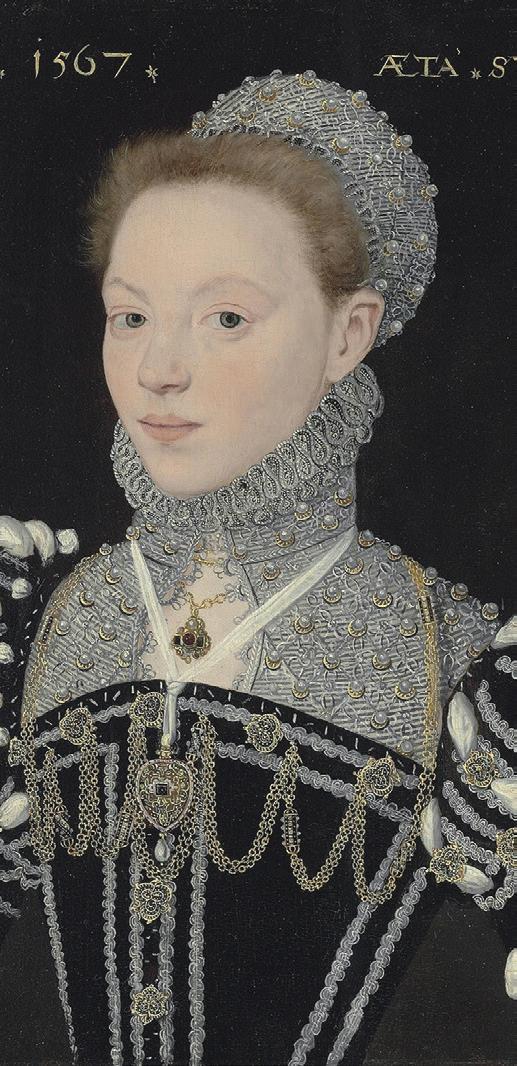
Compton Verney, to 7th May Connoisseurship is a word that you don’t hear often nowadays, because it’s deemed elitist and exclusionary.
However, even Wikipedia admits that ‘in the art trade, expert connoisseurship remains a crucial skill for the identification and attribution to individual artists of works by style and technique’. So it is admirable to find an exhibition that aims to develop that skill in its visitors.
In his 1969 The English Icon, Sir Roy Strong identified eight previously unattributed early-Elizabethan portraits as the work of a single artist, whom he labelled the Master of the Countess of Warwick after an example at Woburn Abbey. That was connoisseurship in action and more followed, since the Master is now credited with about 50 – mostly female – portraits.

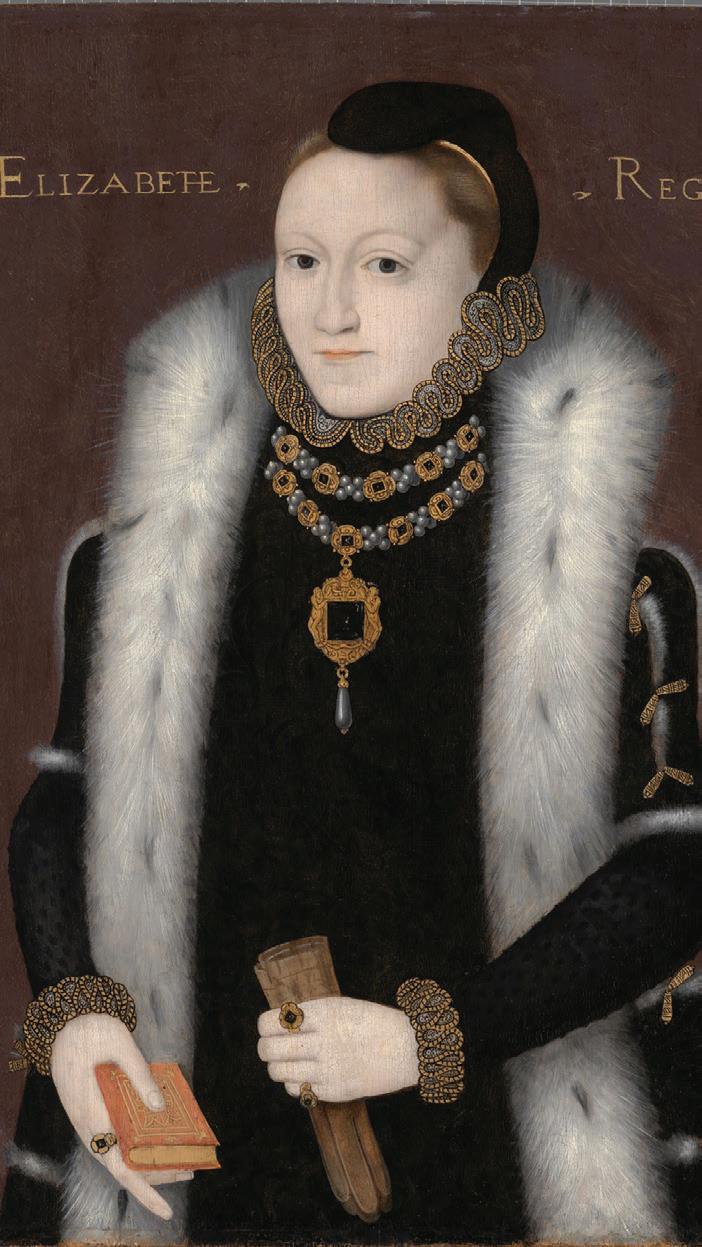
Among the rare males is Sir Thomas Knyvett (1539-1616), High Sheriff of Norfolk and de jure Baron Berners, which is a highlight among Compton Verney’s British portraits.
This exhibition, the work of Amy Orrock, the senior curator of the collection, brings together eight works by
the Master, including the Countess of Warwick. It shows them alongside eight others by Hans Eworth (c 1520-74), with whom he probably trained, and the younger miniaturist Nicholas Hilliard.
These comparisons allow Dr Orrock and Dr Edward Town, of the Yale Center for British Art, to propose a name for the prolific but obscure Master. They think he is Arnold Derickson, otherwise Deyrickeson, listed as Eworth’s servant in 1549 and later as a ‘stranger painter’, indicating that, like Eworth, he was a Fleming.
He was a friend and son-in-law of the artist John Bettes, who, although English, seems to have been associated with Holbein, and whose son was taught by Hilliard.
Dr Orrock says, ‘From the sitters’ clothing and jewellery to their status, ambitions and family relationships, these beautiful portraits offer rich and tangible insights into life in Tudor Britain. We are able to shine a spotlight on new research, which brings this period to life more vividly than ever before.’
The organisation of the show encourages visitors to gain an understanding of the questions, problems, approaches and tools that are used by art historians. These are further articulated through the display of fresh technical analysis and a film of the recent conservation of the portrait of the Countess of the Master.
Together with historical documents, the show has effectively resurrected a long-forgotten artist.
Works by the Master of the Countess of Warwick. Clockwise from left: Sir Thomas Knyvett; Susan Bertie, Countess of Kent; Elizabeth I; A Group of Four Chidren Making Music




 GARDENING DAVID WHEELER VALENTINE’S BOUQUETS
GARDENING DAVID WHEELER VALENTINE’S BOUQUETS
Pity those people who don’t get a Valentine’s card. Age is no excuse.

It’s unlikely but, should I be in your amorous thoughts on 14th February, no red roses please. These flowers are not exactly abundant in British gardens at this time of the year and, anyway, who wants expensive, unseasonal, scentless blooms flown in from several thousand miles away? (You could, however, send them on 6th July, when the Eastern Orthodox Church celebrates the venerated San Valentino and homegrown roses are plentiful.)
Instead, consider Lenten roses –hellebores, known variously as Helleborus orientalis and H x hybridus. Although native to Greece and Turkey, they’ve been in our island gardens long enough to avoid that controversial probe ‘Where are you really from?’

If you do want to know a garden plant’s true origin, try Toby Musgrave and Chris Gardner’s revealing new book, Wild Edens
The garden seems bereft without hellebores. Their early appearance – at New Year sometimes and still flowering up to and over Easter (hence Lenten) –rank them as primary occupants of February borders. Their flower shapes and colours are many: doubles, singles, upright, bowing, plain, flushed, picotee, pure white through apple green, primrose yellow, all shades of pink to red, winey purples, slate grey and near black.
Since their peak of popularity several decades ago, and thanks to their ease of propagation, retail prices (at most outlets) have stabilised – not something you can say about ornamental trees, whose costs have jumped outrageously.


The late, great plantswoman Beth
Chatto, who died nearly five years ago, wondered if there wasn’t something heart-stopping about the earliest flowers, in particular Lenten roses.





‘At this bleak time of the year,’ she wrote, ‘they evoke strong emotion, often more intense for me than the “gaudy flowers” of summer. Is it because they return unfailingly with the coming of the light, their delicate beauty concealing an unshakeable life force? Yes!’
I only once saw Beth’s Essex garden in the depths of winter. We strolled together, braving the elements, rewarded by defiant scents, similarly enduring a cold blast. For her, whiffs of flowering currant Ribes sanguineum ‘Albescens’ were part of the awakening garden:
‘I like to pick long, curving branches just as the flower buds begin to swell. I bruise the stem ends, put them in a large jug. Within a few days, tiny, fan-shaped, pleated leaves will be unfolding along the bare, polished brown stems, followed by drooping tassels of white flowers, making an unusual bouquet for St Valentine’s Day.’
My new garden remains largely devoid of perennial favourites. By hitherto concentrating on those costly trees and numerous shrubs, I am only now beginning to make flower-beds where a February display is paramount.
I’ve sourced the hellebores –50 yearlings in 9cm pots from Farmyard Nurseries in Llandysul, where the price of plants constantly pleases.
We have achieved an ‘instant’ pageant of bulbs by decanting into their permanent outdoor places numerous kinds, raised in pots – muscari, daffodils, dog’s-tooth violets, Anemone blanda and crocuses.
As I dig, I catch exotic fragrances –some from the pink-flushed flowers of Viburnum bodnantense ‘Dawn’ and its white-flowered cousin, ‘Deben’.
Always, reliably, shrubby winter honeysuckles sweeten the air. Among them are Lonicera fragrantissima, a Chinese plant brought to our attention by Scottish plant-hunter Robert Fortune in 1845, and L purpusii ‘Winter Beauty’.
Its flowers, say the RHS, are extremely attractive to insects, providing a vital source of nectar for bumblebees, whose hibernation might have been disturbed.
Roseless, perhaps, but otherwise richly endowed with so many truly seasonal late-winter flowering plants, the February garden bears untold secrets it begs to share.


David’s Instagram account is @hortusjournal
It was Apollo’s pursuit of Daphne, who escaped him by changing into a laurel tree, that spawned the laurel wreaths used as rewards for the military heroes, athletes and poets of ancient Greece.
Hence laureate and baccalaureate and the herb Laurus nobilis, in French laurier, which we call bay.








Unlike parsley and thyme, the other two components of the traditional bouquet garni, bay is not usually grown from seed but can be propagated from cuttings in late summer. A standard bay tree growing in a pot, about three feet in height, should not cost more than £40.
We have had one by the front
door for a few years which produces pale yellow flowers in spring and little berries in autumn. A regular feed of liquid seaweed extract throughout the summer is advised, especially if the leaves are turning a yellow shade of green and losing their gloss.
Bay may suffer from over-watering or too much rain. A potted plant should stand on pot feet or bricks to raise the container off the ground and allow water to drain away.
We also have a large bush of bay next to a yew of similar shape and size. Both are trimmed like topiary with a hedgecutter once a year, giving off a delicious scent as the bay leaves fall to the ground.
They will have a stronger flavour if used fresh but, if dried, the leaves should be stored in an airtight bag.
Bay trees are very hardy, the more so if planted in the ground. A sunny site is preferred, with well-drained soil. If severe frosts occur, it may be worth moving pot plants into the shelter of a wall or porch. Otherwise bay trees are relatively trouble-free. There are insects that attack the roots and leaves, but I haven’t come across them; and rabbits seem to leave the trees alone.
When bay is brought into the kitchen its flavour is probably most effective when used in slow-cooked casseroles, or when one or two leaves are stuffed into the cavity of a chicken.
Tuck up in a cosy corner of the kitchen with a fortifying bowl of soup. And read two books about what it means to be English at table.
Emma Kay’s sturdy, pocket-sized paperback, Fodder & Drincan, dives deep into the Anglo-Saxon way of life. The other, Diane Purkiss’s handsome hardback English Food: A People’s History, supplies the nuts and bolts of our much-maligned culinary habits.
Both are as entertaining as they are erudite. Kay examines the state of the nation in early medieval times.
When Alfred the Great styled himself King of the Anglo-Saxons, then as now a great gulf separated rich from poor and poverty led to starvation. The population was diverse: a gallimaufry of Scandinavian, Germanic, French, Flemish, Celts and Roman immigrants from the Mediterranean.
While no formal recipes exist from those days, the author’s reconstructions include a hearty winter soup with barley
and leeks – evidence of historical links with Scandinavia, where leek broth was ‘considered both medicinal and symbolic of comfort and nurture’. Just the ticket for a chilly February evening.
Professor Purkiss paints her story with a broad literary brush, citing Chaucer on waffles, Chinua Achebe on the beauty of apples and John Betjeman on ladies who lunch. Among chapter headings – the author has no time for frippery, as befits the English culinary habit – are Pigs, Loaves, Fishes, Breakfast, Lunch, Tea and Dinner.
She’s particularly scathing on the snobbery attached to foraged foods by diners in high-end restaurants: ‘The former foods of poverty are now prestige foods that not so much appeal to, as artificially instil, a sense of food from the past, offering the pleasure of something never actually experienced.’
Among the few recipes buried in the text, Professor Purkiss includes a recipe from 1744 for cardoon, a tall, fuzzystalked member of the artichoke family, exiled from the kitchen garden to become a decorative addition to the herbaceous border.
Emma’s Beow Brew Barley broth with leeks Prepare this nourishing bowlful, says Ms Kay, with a strong chicken stock made with a chicken carcass, diced carrot and parsnip, celery stalk, two quartered onions, parsley, rosemary and salt. Serves 2-3.

100g barley (hulled or pearled)
2 fine, fat leeks, finely chopped with their green
1 tsp mixed dried herbs
Butter for frying
1 litre strong chicken stock (see above)
For hulled barley, pre-soak overnight in enough water to cover. If using pearl barley, wash thoroughly before cooking.
Bring 300ml fresh water to the boil, add the barley, bring back to the boil, cover and simmer on a very low heat for 40-50 minutes till tender. Drain if the
water has not quite evaporated. Meanwhile, fry the chopped leeks in a little butter for about 5 minutes, stirring occasionally. Heat the stock and add the barley, leeks and herbs.
Reheat, ladle into bowls and serve with buttered slices of clæne hlaf – a ‘clean loaf’ prepared with a sourdough starter and flour in equal parts rye and spelt, to two parts barley, to six wheat.
Professor Purkiss’s gratin of cardoons (or chard or chicory) with orange
The juice of a Seville orange, in season now, balances the natural bitterness of winter vegetables. To prepare cardoons for the pot, trim off the tops and leaves, scrape and chop the stalks. Now you’re ready to ‘stew them until they are tender, put in a piece of butter rolled in flour, pour them into a dish; squeeze the juice of an orange into the sauce, sprinkle with grated Parmesan or Cheshire cheese, then brown them with a cheese iron’.
PRICE WAR – 1973 VS 2023
We’re in the depths of Dry January: the month of sobriety and austerity.
I’m utterly skint. I’ve already made some raids on the freezer, discovering mackerel from June and an iceberg of various stocks which I have dragooned into soups. Last night, I found a tin of gésiers de canard (duck’s gizzards), which I will have for dinner with a clothes peg on my nose.
I’m very bored – so bored that I have done an analysis of the cost of eating out in 1973 compared with 2023.
In front of me is a 1973 menu from the Ebury Wine Bar, on the edge of Belgravia. It had just been taken over by Nigel Pullan and Shura Shihwarg, the restaurateur husband of Joan Wyndham (Love Lessons), who went on to open The Golden Duck in Hollywood Road.
Britain had just joined the EEC. So Nigel and Shura were able to ‘introduce a number of wines from the lesser-known regions of France, from Italy – a country whose wines we believe represent excellent value’. A bottle of non-vintage Margaux is £1.30. A bottle of ’67 Château Bellevue is a staggering £1.65. A ’69 Gevrey Chambertin is £1.70. ‘Rich French onion soup’ is 35p. Prawn cocktail is 45p. Lamb cutlets are £1.
And there’s an extensive cold table of chicken, beef and ‘various continental sausages’ for 70p-80p at the buffet counter.
They are light on puddings: fresh fruit salad and cream for 35p. Ten per cent
VAT is included and the service charge is a minimum of 75p per person.
So a young couple could have prawn cocktail, lamb cutlets and fruit salad, accompanied by a six-year-old bottle of Château Bellevue, for a total of £6.75 including service.
According to the Bank of England’s inflation calculator, goods to that value would cost £67 today. Yet restaurant inflation has its own rules, and we need to find a true contemporary comparison.
Sadly, the Ebury Wine Bar is no longer with us. So I found another medium-priced restaurant in the area, About Thyme, a bistro in Wilton Street. They were offering a set Christmas menu for £39.50, from which you could choose prawns, lamb shank and an ice-cream medley. And you can have a bottle of 2014 Château Robin from Lussac-Saint-Émilion for £45.50. (A bottle of 2017 Château Bellevue costs £30 direct from a wine merchant. So you can assume £90 in a restaurant.)
Fifty years on, then, dinner costs £140 for two including 12.5% service and less good wine – over double the rate of inflation of other goods and services.
With my new January attention span (about 20 times that of mid-December), I have also examined affordability. Let’s assume one half of the 2023 couple earns £50,000 a year. That’s the equivalent of a salary of £4,295 in 1973, worth £232 per month after tax, compared with £3,100 per month now.
So the same dinner represented 3% of the monthly budget in 1973 compared with 4.5% today. The same dinner is 50% less affordable and, again, the wine is not as good.
And yet, proud as I am to have channelled my inner accountant, none of my research has changed my attitude in the least. Eating out is expensive but no more so than a trip to the theatre to watch a tired play performed by uninterested actors.
And life really is too short for always eating at home. Roll on Soggy February.
SHERRY,
Thanks to our capricious climate, you may be reading this on a sun-dappled terrace in shirtsleeves (I do hope so). But now, as I gaze through frosty windows at the garden, even our fiercely territorial local cats are huddling together for warmth.
I am too young to remember the bitter winter of 1962-3 but if, as a child, I ever complained about being cold, I was firmly put in my place with hyperbole reminiscent of the Four Yorkshiremen
sketch, reminding me of the privations of the Big Freeze. My grandparents had survived that winter, so family legend had it, only because of a case of sherry.
They lived in Bristol, in a terraced house with just a few fireplaces for warmth and a temperamental geyser for occasional hot water. But my grandma worked for John Harvey & Sons, the venerable local wine merchants, blenders and importers. As a Christmas bonus, she had been given a dozen bottles of Harvey’s Bristol Milk. As a substitute for central heating, it proved invaluable.
‘Bristol milk’ was originally a generic term, used by several of the city’s wine merchants to describe a sweet, goldencoloured sherry, blended in Bristol and matured in oak butts. Its history predates Harvey’s, founded in 1796. In his diary entry for 13th June 1668, Samuel Pepys writes approvingly of a meal of venison pasty and strawberries with ‘plenty of brave wine and above all, Bristol milk’.
In the 1880s, Harvey’s developed a more complex blended sherry, which they named – and trademarked as –Bristol Cream. They did not, however, trademark the word ‘cream’, thus creating a new style of sherry that anyone could make and sell. Bristol Milk did not survive the 1980s, but Bristol Cream, bottled since 1994 in Bristol blue glass, survives, though it is no longer made in Bristol and is owned by a Philippines conglomerate.
For decades, wine writers have been fighting a largely fruitless battle to persuade their readers to drink sherry. Sweet sherry is the hardest sell of all, perhaps because of the bottle that languishes on sideboards from one Christmas to the next, uncorked only to be slugged into a trifle, or dispensed for guests who ‘don’t normally drink … but maybe a small sherry’.
But it can be utterly, hedonistically delicious. I am especially fond of Gonzalez Byass’s Matusalem, a dry oloroso sherry, sweetened with 25-percent Pedro Ximénez and matured for 30 years (ocado.com, £24/37.5cl), either to sip or to dribble over vanilla ice cream. Or both.
You might also try the Wine Society’s Exhibition Mature Medium Sweet Oloroso Blend (thewinesociety.com, £12.95/75cl) or Lustau’s Pedro Ximénez Murillo (waitrose.com, £13.99/50cl), either of which, in the sad absence of Harvey’s Bristol Milk, would have happily tickled my grandma’s sherry-loving palate.
And she was in good company. Apparently, the Prince of Wales – later Edward VII – took one swig of Bristol Milk and remarked that the city ‘must have damn fine cows’.
WineThis month’s Oldie wine offer, in conjunction with DBM Wines, is a 12-bottle case comprising four bottles each of three wines: a classic Picpoul from the south of France, and two great-value, organic Spanish reds which demonstrate why Spain is such a happy hunting ground for budgetconscious wine-lovers. Or you can buy cases of each individual wine.
Ornezon, Vignerons de Florensac, Picpoul de Pinet 2021, offer price £11.49, case price £137.88

Deliciously aromatic Picpoul with hints of citrus and peach; perfect with seafood.
Te Quiero, Red Field Blend, La Mancha, Tierra de Castilla 2019, offer price £9.99, case price £119.88
A plethora of grape varieties, primarily Tempranillo and Syrah, offering bags of spicy, brambly fruit.
Gatito Loco, Rioja 2020, offer price £9.99, case price £119.88

Lively, fruity, new-wave Rioja made from Tempranillo and Garnacha: organic and unoaked.

HOW TO ORDER
Call 0117 370 9930
Mon-Fri, 9am-6pm; or email info@dbmwines.co.uk
Quote OLDIE to get your special price. Free delivery to UK mainland. For details visit www.dbmwines. co.uk/promo_OLD
NB Offer closes 28th February 2023.
There is no more terrifying sporting place of work than a ski-jump tower.
Forget walking out at Wembley with 80,000 voices bellowing out their affiliation. Never mind the summit of an Alpine climb in the Tour de France before you make the descent. The top of a 10-metre diving board, petrifying as it might be as you stand on the edge looking down way below on to the water, is nothing in comparison.
Up at the top of a tower, waiting to jump, is on another level entirely.
I climbed to the top of an Olympic tower many moons ago and the thought of it still brings me out in a cold sweat. I was in Oslo to interview Willi Railo, the Norwegian professor who was SvenGöran Eriksson’s psychologist of choice.
We met in a skiing resort outside the city, in a café that was under the malevolent shadow of the tower. At the end of the interview, he took me, as I feared he would, to its peak. Up in the lift we went; then up the stairs, up, up, up to the top.
Once there, with Oslo laid out below like a train set, the wind howling in the steel ropes, the whole structure wobbling precariously, we looked out over the starting gate as the jump disappeared away below our feet. My knees buckled. I grabbed the sides and could not move.
It occurred to me, as we contemplated the fall, that it was no wonder a Norwegian became the master of sports psychology: there can be no mental barrier greater than pushing yourself off down there.
So what, I asked, would Railo, the doyen of the science, say to someone about to jump this jump?
‘I would say,’ he said, gingerly putting his hands on the metal retaining bar and peering over into the chasm below our feet. ‘I would say, if I was you, I would turn right round, take the lift back down and forget about it.’
On 17th February, in Räşnov, Romania, the women’s and men’s ski-jumping World Cup begins. Young athletes will be climbing towers like the one I scaled. Instead of taking Railo’s advice and turning straight round, they will throw themselves off in the fond hope that, when they reach the bottom, they will fly. How they manage it – and convince themselves that this is somehow a good idea – is beyond me.
Yet when Eddie the Eagle Edwards did it at the 1988 Winter Olympics, he became a figure of international mockery.
Look at him, those who could barely climb the stairs cackled, the man’s a
buffoon. Except just to go where he did required the most phenomenal levels of bravery.
To put yourself in the position of looking downward along the runway as you wait for the green light, knowing you will have
to push yourself off into a slope not so much vertiginous as suicidal, a slope that finishes some 20 feet above the ground, depositing you into mid-air, is an act of extraordinary nerve. Particularly for Edwards, who had no experience.
The man was heroic.
Since he did his devil-may-care act and finished last, few Britons have followed Edwards up a tower. Apart from him, only Glynn Pedersen in 2002 has represented Britain at the Winter Olympics. And he was born and raised in Canada.
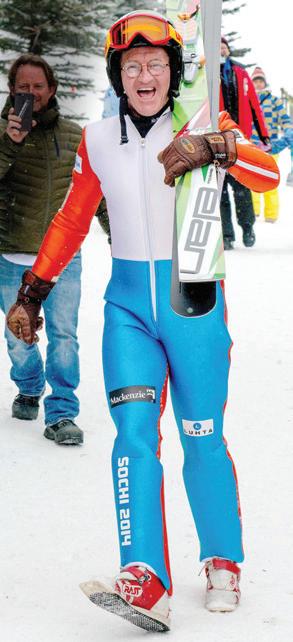
In Romania, there will be nobody from this country taking part. As a nation, we prefer to follow the advice of Willi Railo. Which seems smart to me.
A seven-year-old Range Rover Sport hybrid suffered complete main-battery failure. It was the hybrid battery, not the ordinary car battery.
A partial failure would apparently not have been too serious because sections can be replaced. But replacing the whole thing requires a special jig (because the battery is built into the car) and specially trained fitters (because of ’elfnsafety). The bill? That’ll be 21,000 smackers, guv.
Next, a gentleman describing himself as the ‘happy owner’ of a 14,000-mile BMWi3 wrote to Autocar about what happened after his drivetrain warning light came on. His main dealer had the car for four weeks while replacing the ECU and the electric motor.
That was 17,000 smackers – and it didn’t even solve the problem. An engineer from BMW head office diagnosed a faulty battery-cooling condenser, replaced in a day for £300.
Such stories are more than enough to put you off electric vehicles. But it’s not all bad news. The same edition of Autocar reports the findings of specialist battery analysts covering a range of EVs.
Although commercial users reckon
that 10 per cent degradation of battery capacity is half the life of an EV and that its operational life is over when it degrades to 80 per cent, on the whole EV batteries are lasting longer than expected.
A 2019 study of 6,300 EVs found an average annual degradation of 2.3 per cent, with wide variations due more to how the battery is treated than to the make of car. Frequent rapid-charging, for example, wears out a battery more quickly, as does charging the car fully and not going anywhere – heat produced by charging damages battery cells.
Frequent charging combined with infrequent use is the worst way to treat your battery. The best way to prolong its life is not to charge until endurance is down to 20 per cent, then not to charge above 80 per cent – and then to drive it.
Most private owners, however, tolerate lower levels of battery capacity by accepting less range than when the car was new.
Batteries degrade more rapidly when they get below 70 per cent capacity and that is acceptable to many because their driving is local. There are plenty of old Nissan Leafs pottering and purring happily around with only 50 miles of range.
But be warned: if you’re buying a used EV and the seller does a battery-capacity test for you, make sure it’s from cold. A warmed-up battery gives a better reading.
However, before your complexion takes on a deeper shade of virtuous green, take a look at The Rare Metals War by journalist and documentarymaker Guillaume Pitron. He explores the environmental costs of producing, separating and finally recycling the rare metals essential to the lithium and similar batteries that virtually all EVs depend on (not to mention your mobile phone).
Clean energy, he argues, ‘is a dirty affair. We feign ignorance because we refuse to take stock of the end-to-end production cycle of wind turbines and solar panels’.
Renewable and ‘clean’ energy sources and transport can be produced only by the mining of non-renewable resources. And that process is hugely productive of greenhouse gases, especially as so much of it happens in coal-fired China.
We in the west may pat ourselves on the back for going greener, but we do so by exporting our pollution to bits of the world where environmental and welfare standards are much lower. Energy costs.
Or so he says. I’m not qualified to judge, but I’ve long suspected that the concept of carbon neutrality is a con, achieved only by dumping your carbon on someone else.
But you can still do your bit by helping your battery live longer.


A new year is the time to make predictions for the next 12 months. But, as somebody once said, prediction is very difficult, especially about the future.
Looking back at my past prophecies is a salutary business. Some years ago, I predicted that, as filters improve, spam emails might soon become a thing of the past. That was hopelessly optimistic. If anything, the opposite has happened.
In the digital world, developments are as hard to foresee as anywhere. Throughout the industry, people with large brains are constantly working on new ways to use this relatively new thing called the internet.
So, this year, rather than trying to guess what will happen, I’ll list some
For my latest tips and free newsletter, go to www.askwebster.co.uk
When will your broadband improve? www.openreach.com/fibre-checker This will tell you when you’ll get the best broadband. If ever.
Time and date www.timeanddate.com Everything about time, time zones, the moon and sun, weather and time calculators.
I will happily try to solve your basic computer and internet problems. Go to www.askwebster.co.uk or email me at webster@theoldie.co.uk
things that won’t happen. Frankly, I’m more likely to be right.
First, local newspaper websites will continue to be almost unreadable, encumbered as they are by endless slow-loading adverts and ‘clickbait’ (‘Your jaw will drop when you see…’) desperately aimed at generating advertising income.
This will continue until the publishers accept my theory that there is a market for local ad-free websites of record for which people will pay a modest annual subscription and which report on local sports, crime, politics and community events.
People hate intrusive adverts on websites, and many will pay to avoid them. While they would never be big money-spinners, these sites could support small local teams, especially if the technical stuff were handled centrally.
Another thing that won’t happen this year is the effective reining-in by government of the excesses and harmful activities that take place on social-media sites, whatever laws they pass. It’s depressing, but a fact of internet life. Controlling what people put online is like trying to grip jelly, even if you pass all internet traffic through a government censor, as the Chinese do.
You could shut down Facebook, Twitter and the other big companies, but there would still be thousands of alternative platforms coming and going like will-o’-the-wisps, many based outside this country and so beyond our government control anyway.
Next, 2023 won’t see an end to passwords, or all the other irritating logging-on procedures we endure.
I concede they are a necessary evil, but there are so many options that it’s bewildering at best and impenetrable at worst. I maintain an online password vault, which is remembering over 3,000 passwords, most of which are for sites I will never visit again. This is absurd.
On top of that, many sites want to phone me, send me texts and emails or insist I use an ‘authenticator’ on my phone before admitting me. Banks want me to put my debit card into a machine and press endless buttons. The one I have from HSBC is so small that my arthritic fingers often mess it up.
It’s all a muddle. While this sort of security is undeniably important, by now there really ought to be a better, more standard way of doing it.
Another non-event in 2023 will be the improvement in the quality and reliability of voice calls on mobile phones and via the internet.
Almost nobody uses a landline any more, but they are more reliable than mobiles and Zoom and easier to use. Not for long, though. BT is shutting down all landlines by 2025. So we’ll be stuck with indistinct mobiles that cut out regularly or simply don’t connect, or peering up someone’s nose on a Zoom call.
One cheery thought is that this will mean we oldies can irritate young people by endlessly starting sentences with ‘In the old days, when we had proper telephones…’
I’m looking forward to that, at least.
Fraudsters will steal anything.
Even people’s homes are being stolen – house-hijacked – with several instances a year. Since 2009, the Land Registry has prevented 400 fraudulent applications being registered, worth more than £207 million.
One property that slipped through belonged to a vicar who returned to his empty house in Luton to find the locks changed and builders working inside.
Crooks had broken into his house, applied for a duplicate driving licence in his name and then managed to sell his home to innocent buyers – who immediately became the legal owners. A year later, he was still in limbo.
Paper-based property deeds no longer prove you own a property. HM Land Registry’s electronic register is the only accepted record and whoever’s name appears on the register
is the legal owner. A separate register operates in Scotland.
When more properties were being left empty during the COVID lockdown, the Land Registry warned homeowners about fraudsters taking advantage of the pandemic and trying to sell, or remortgage, their houses. Most at risk are unregistered, unmortgaged, empty, high-value houses and tenanted properties.
To commit title fraud, crooks steal the genuine owner’s identity and redirect the post, and they can then steal money in several ways. They might change their name to yours by deed poll, so the same name appears on the register. This enables them to apply for loans, using the equity in your house as security.
With rented property, a dishonest tenant might never actually move in but instead steal the owner’s identity, perhaps open a bank account in that name and put the property up for sale.
If you are away from home at the time, they can sell the house, bank the proceeds paid by an unsuspecting buyer and disappear. The new ‘owner’ might be well settled into your home before you discover what has happened.
When you are selling a property, criminals might pretend to be a buyer and then pull out at the last minute, having gleaned enough information about you to commit title fraud.
When stolen items other than buildings are bought inadvertently, ownership remains with the original owner and the duped purchaser loses out. When houses are stolen, the Land Registry decides who really owns the property, aware that both parties have paid for it in good faith. It does not simply transfer ownership back to the first owner if they weren’t living there at the time and a new person has moved in. 13th-20th October 2023
The Land Registry has an indemnity fund to compensate losers and pays out millions of pounds each year to the victims of property fraud, but compensation is not automatic.
To protect yourself, check that your property is registered with the Land Registry and sign up to the Land Registry
Property Alert service, which will warn you about any searches and applications made on your property. You can also put a restriction on the title deeds, requiring that any sale or mortgage must include a solicitor’s certification that it really is you making the application.
Above all, ensure the Land Registry has your up-to-date address for communication if this is not the same as the property’s. Notify reportafraud@ landregistry.gov.uk if you have any suspicions fraud is taking place.


La Foce was the Tuscan home of Iris Origo, which she immortalised in her wartime memoir War in the Val d’Orcia. In the 1920s, she commissioned Cecil Pinsent to design the world-famous gardens. Four years ago, her granddaughter renovated the 15th-century villa and its outbuildings, and they are now available to rent. So we snapped up an available week. We will have the Origos’ home to ourselves, and will be able to swim in the pool and wander through the gardens, while looking across the valley and its famous zigzag road which features on so many book jackets. Not to be missed.
Friday 13th October – arrival
Morning flight to Rome; late lunch at the villa followed by tour of the garden.
Saturday 14th October –Perugia and Assisi
Guided tours of Perugia, where we will have lunch, and Assisi, to marvel at Giotto’s frescoes of the life of St Francis.
HOW TO BOOK: Please email Katherine at reservations@theoldie.co.uk or call 01225 427311. Price per person: £3,250 which includes all meals, all drinks at the house and great wine with meals, transport and entrances. You need to book and pay for your own flights. Single supplement: £500. A non-refundable deposit of £750 will be required, with the full balance due on 1st July 2023.

Sunday 15th October – day at the villa
Dinner in the Dopolavoro restaurant, which was built by Iris Origo for the farm labourers.
Monday 16th October – Montepulciano and Montalcino
A day of wine-tastings in these two classic hill towns.
Tuesday 17th October – Arezzo
Guided tour of the city, including the duomo, followed by lunch in the Piazza Grande. Afternoon at La Foce.
Wednesday 18th October – Lake Trasimene and Cortona
Morning guided tour of the walled hilltop town of Cortona. Lunch at Albergo Ristorante da Sauro, on the pretty island of Maggiore on Lake Trasimeno, where Hannibal won his famous victory.
Thursday 19th October – Orvieto
Morning guided tour of the duomo followed by lunch. Afternoon at La Foce.
Friday 20th October – home
Leave after breakfast for Rome Fiumicino.
‘This new model comes with GPS’



Decimating avian flu continues to be the chief bird concern as this article goes to press.
The Tower of London ravens and equally treasured five zoo-bred pelicans in St James’s Park have been locked up for the duration. The pelican Gargi is wild – she arrived in a Southend garden 32 years ago. So she roams free, unpinioned, occasionally venturing beyond her St James’s Park base.
The pretty siskin (Carduelis spinus) provides a bright contrast to the doom and gloom. In 60 years, British numbers have grown from 40,000 to 370,000 pairs. The principal reasons are the commercial planting of conifer forests and the provision of garden-bird food and feeders.
In living memory, our resident siskin population was confined to the Caledonian Forest in the Scottish Highlands. Then came the industrialisation of forestry – to moorland what prairie farming has been to the spinneys and hedges of agricultural land.
Today, in Carrick, south-west Scotland, the ‘moors and mosses’ of Robert Burns – the ‘hills of home’ filled with the calls of ‘whaups’ (curlews) and ‘peewees’ (lapwings) in Robert Louis Stevenson’s sonnet To S R Crockett – are blanketed with serried ranks of silent, view-destroying fir trees. The most notable song-bird beneficiary of this smothering change has been the siskin.
More than half our conifer forests are in Scotland and three-quarters of conifer trees, north and south of the border, are Sitka spruce. The Sitka’s smaller seeds, relative to other conifers’, are particularly favoured by siskins and coal tits.
Availability is shaped by the weather. Conifer cones open to release seed on dry days but remain closed when it is damp. The peak period for damp conditions in the north is February and March. Siskins are forced to
wander from their forest breeding grounds, alder seeds proving the most popular natural alternative.
The southern spread of conifer forestation coincided in the 1960s with the creation of the garden-bird-feeding industry. Previously birds were provided with scraps, most extravagantly a halved coconut. Then came the arrival of buyable fat balls, netted peanuts, seed varieties and every type of metal container.
One of the first official records of a siskin seen in a garden was at Guildford, Surrey, in March 1963. The far southern location was perhaps a wandering response to that year’s exceptionally long and hard winter.

Today, Sitka spruce and nationwide bird-feeders have resulted in siskins’ earning a green population status of ‘no
concern’ and tenth place in the 2022 garden-bird census.
It is always thrilling to see their brightness at a bird-feeder, especially in winter and when it is a cock bird – its deeper yellow contrasted with a black crown and bib. This, coupled with ‘siskin’ prattle and docility, explains the species’s former popularity as a cage bird. Like other finches, siskins flock in winter.
My first January sighting, of several siskins crowding a bird-feeder, was in Berwickshire in the 1980s. It was surpassed only by the September visit of a single cock bird to my London garden in 2015.
The 2023 Bird of the Month calendar, with Oldie illustrations, is out now www.carryakroyd.co.uk
‘Iwould rather this article was more about Arcadia than about me,’ says Wendy Copage, quite sincerely – although she has done more than anyone in recent times literally to put this fabled but very real part of Greece on the map.

So, yes, let’s talk about Arcadia – before we come on to the remarkable work done by this 60-year-old Yorkshirewoman, who has just been granted Greek citizenship, thanks to her fluency in the language and her decades-long passion for her adopted country, particularly the wild beauty of its most unspoilt area.
In the history of art and literature, Arcadia is as much an idea as a place. In myth, it was the realm of the god Pan and featured in the poetry of Theocritus in the third century BC. Later, Virgil helped develop its image as a rural idyll populated by nymphs and shepherds.
But as Gregson Davis, a Classics professor at New York University, has pointed out, Virgil’s Arcadia was not ‘a world of escapist bliss’ but rather ‘permeated with portrayals of human
infelicity, catastrophic loss and emotional turbulence. Virgil’s primary concern is with the world of human misery rather than with frivolous escapist constructions purified of anguish and angst.’
Yet artists of the Renaissance couldn’t get enough of Arcadia the rustic dream world. Sannazaro’s pastoral poem Arcadia (1504) was a major influence on Shakespeare and Milton.
In the early-17th century, inspired by
Poussin’s Et in Arcadia Ego (1637-8): Greek shepherds read the Latin inscription

a line from Virgil, Guercino painted Et in Arcadia Ego, in which two shepherds study the inscription ‘Et in Arcadia Ego’ (‘I am even in Arcadia’) beneath a skull, a reminder of death being present even in the midst of rural paradise.
Twenty years later, Poussin, in his classier picture with the same title, painted shepherds grouped round an Arcadian tomb (pictured).
Since then, the potency of this dream world has endured via Keats’s
Ode on a Grecian Urn; the first chapter, ‘Et in Arcadia Ego’, of Evelyn Waugh’s Brideshead Revisited; and Tom Stoppard’s Arcadia (1993).

And recently we were treated to the publication of Paul Holberton’s lavish two-volume A History of Arcadia in Art and Literature
But the real Arcadia does exist – in the Peloponnese, a hundred miles south-west of Athens. Yes, it is an area of amazing natural beauty – but, in an echo of Professor Davis, it is also a place where only the tough survive.
Few know this better than Wendy Copage, whose traditional little Greek house stands in the coastal village of Tyros, in the shadow of the mighty Parnon mountains.


How did this come to be her home? ‘I was a Shirley Valentine,’ she smiles, ‘although I’ve never seen the film!’
Thirty-five years ago, she came to Greece on holiday, fell for a local and married him. They had a son and then divorced after ten years. Wendy stayed on, bringing up her child in Athens and working there as a sales manager for a major publishing company.
After her divorce, she met and married her present husband, Nigel. They lived in Athens and then, 16 years ago, bought the house in Arcadia. ‘I have always been an outdoor person and have always loved wild places,’ she says. ‘That whole coast is still so unspoilt – because it’s not on the way to anywhere. There is the mountain wilderness on one side and the sea on the other. We bought the house in Tyros knowing we were going to move there as soon as life allowed.’
When Wendy was made redundant, Arcadia beckoned. Wiry and fit from her days of trail-running, she looked for
paths to go walking. ‘But there was no walking map. I would set off on a walk from the house and just get lost! The people here are very local. They tend just to go as far as the rock on the horizon.’
She acquired a Russian map of the area made in 1830 – there was a strong connection between the Russian and Greek Orthodox churches, and a lot of monasteries in Arcadia. ‘It showed a cobweb of paths,’ she says. A 1950 Greek army map helped, and she also drew on the knowledge of local shepherds – still a major part of Arcadian life.
She located the paths, but many were disused and overgrown. She made it her mission to walk them and reclaim them. (To date, she has cleared 50 or so paths, covering a distance of around 300 miles.) Systematically she made her way through the vegetation, carefully cutting back bushes and marking the way with little strips of material cut from old bed sheets.
Eight years ago, she started her own walking company, Greece on Foot, guiding groups of independent hikers through the wilds of Arcadia. Her jaunts are not for the faint-hearted.
When leading people on a six-day ‘Arcadian journey’ staying in shepherds’ huts or at monasteries, she warns them, ‘There will not be a single step on tarmac. You need to be prepared for wilderness camping – without a tent. There will be no washing.’
Then came COVID and Brexit. ‘They meant taking a step back,’ she says. ‘COVID completely shrank my world. But I found so much that was just ten minutes outside my door.’
Brexit didn’t have such an upside; in fact, it made it impossible for Greece on
from far left: Wendy Copage at her Tyros home; the first chapter of Brideshead Revisited; Wendy’s house, in the shadow of the Parnon mountains
Foot, as a British company, to continue. The hoops to be gone through to restart it as a Greek company were too much – but by this time Wendy had locals working for her, so the solution was for them to take over and for her to work for them.
‘I am still a resource,’ she says. ‘I’m still taking people walking. And I am working more with the local authority.’
That work has led to making paths more accessible, putting up information boards, creating leaflets and producing a new large-scale map of her part of Arcadia, which is South Kynouria.
And after that? ‘We have three or four big canyons here. The idea is to install ladders and rungs so that people can get access. The scenery is breathtaking, absolutely spectacular. We will have six or eight circular routes.’
Wendy’s future is very much here in Arcadia. ‘The first time I came to Greece, I felt I had come home,’ she says. And now she is a fully-fledged citizen. ‘I have my Greek passport – and when my British passport expires, I will not renew it.
‘There are so many places described as unspoilt – but when you get there, they are actually spoilt. Arcadia is the least spoilt part of Greece. There are still subsistence farmers here; still people living in caves – it has always been tough. One of my best friends is a shepherd, the same age as me – she has no electricity, no running water, no pension. But here they appreciate the important things: the silence of the mountains, watching the sheep…
‘You stay pretty fit here because nowhere is flat! And the people live long, particularly the women. I knew a mother who was the last of eight girls; at the age of 92, having never been ill in her life, she took to her bed for two days and died.’
Would Wendy hope to be like that? ‘Yes,’ she says. ‘I’ll still be out on my mountains!’
But isn’t there yet a danger of Arcadia being spoilt? She answers firmly, ‘Not on my watch.’
Arcadia walking information: greeceonfoot.com
A History of Arcadia in Art and Literature by Paul Holberton is worth reading
The Duchess of Bedford – canoeist, ice-skater and crack shot – built a lovely temple to her Pekingese before flying to her death
Alone in a copse in the park at Woburn Abbey, Bedfordshire, stands a Corinthian temple. Built in 1916 by the Duchess of Bedford, it honours a pet Pekingese.
A bronze effigy of the dog, by Paul van de Kerckhove, lies atop a stone plinth on which are inscribed both his dynastic and his familiar names, Che Foo and Wuzzy. We read that he was born in 1904 and died in 1916.
The memorial has a stepped, circular base. Six Corinthian columns, carved with decorative bands and linked by benches – on which to sit sadly –

supported by lion’s feet, encircle the tomb. A stone frieze of bows, fruit and flowers carries the dome of wrought-iron work; no mean monument to a peke.
On her dog’s demise, the Duchess made a desolate entry in her diary: ‘My little Che Foo died. He has been my constant companion for over 11 years and a more faithful and devoted one I shall never have.’
Her memory was somewhat clouded by grief, as Wuzzy always resolutely refused to be trained to do tricks.
The Duchess, who relished her rapport with animals, was able to
persuade her quantity of either Persian or Siamese cats to be photographed as if playing the violin and croquet.
Wuzzy, on the other hand, would go only as far as riding on Viking the Shetland pony’s back, as well as allowing himself to be pulled along in a tiny carriage drawn by the pony.
Such is the stuff for smiles; but the Duchess of Bedford should be judged with serious admiration. Born Mary du Caurroy Tribe, daughter of the Archdeacon of Lahore, she met and married Lord Herbrand Russell when he was ADC to the Viceroy of India. The
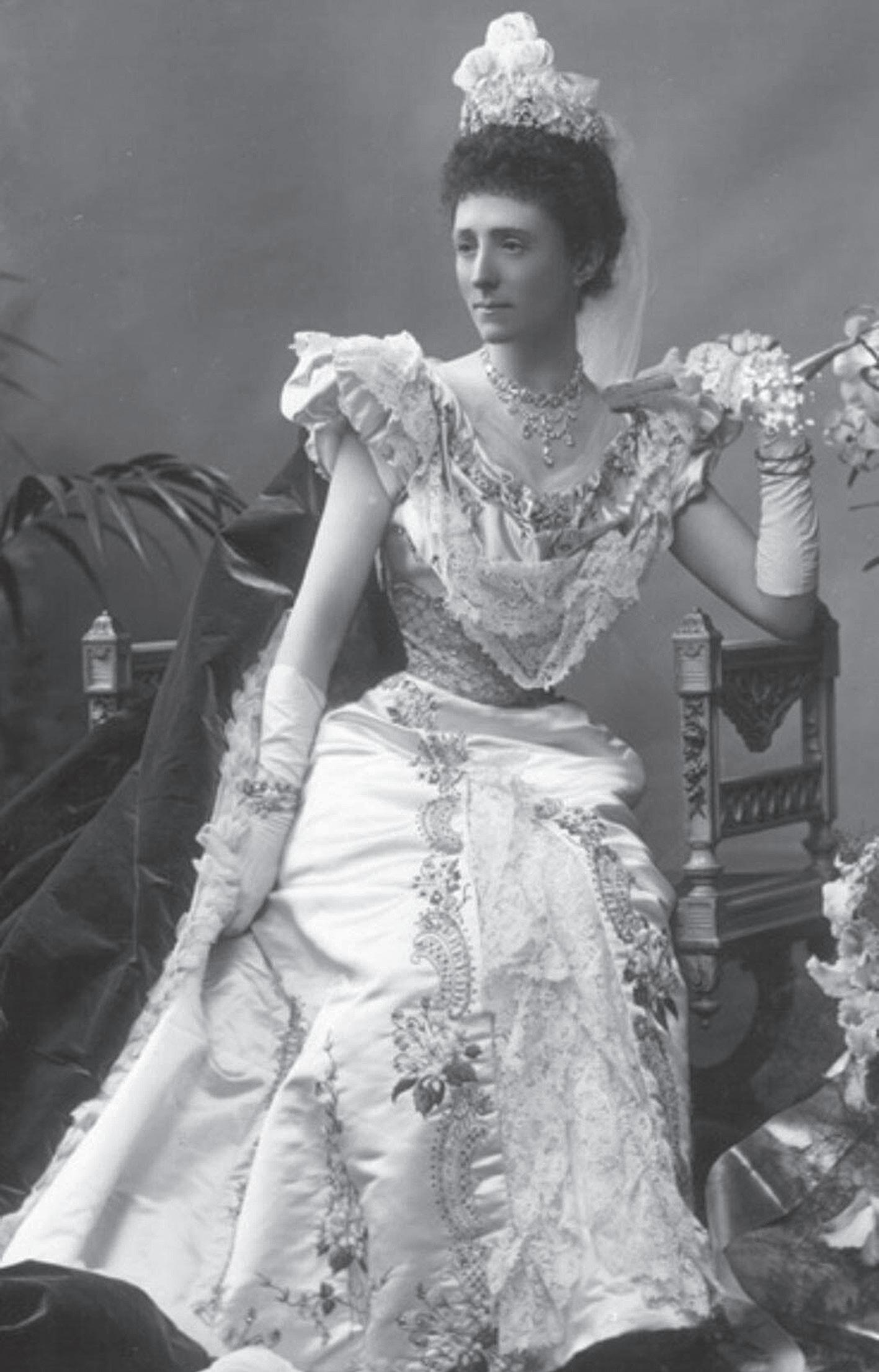
dukedom and Woburn were inherited unexpectedly and galvanised by the new duchess. With pink velvet-clad footmen behind every chair, she sprang forth into the world, becoming a renowned ornithologist and mountaineer.
As one of the best shots in the country, she was known as the ‘Annie Oakley of Britain’. Nor was that the end of it. She was a canoeist, ice-skater, skilled mechanic, artist and photographer.
Most importantly of all, she founded two hospitals, one in a house at Woburn, the other built from scratch
nearby. Having taught herself radiology and radiotherapy, she ran the X-ray department, as well as acting as theatre sister during operations, sometimes even performing minor operations herself.
Then, aged 61, she started to fly, thereafter becoming known as ‘the Flying Duchess’, thanks to her daredevil and record-breaking flights to India and South Africa.

She died, aged 71, when attempting to clock up 200 hours of solo flying time.
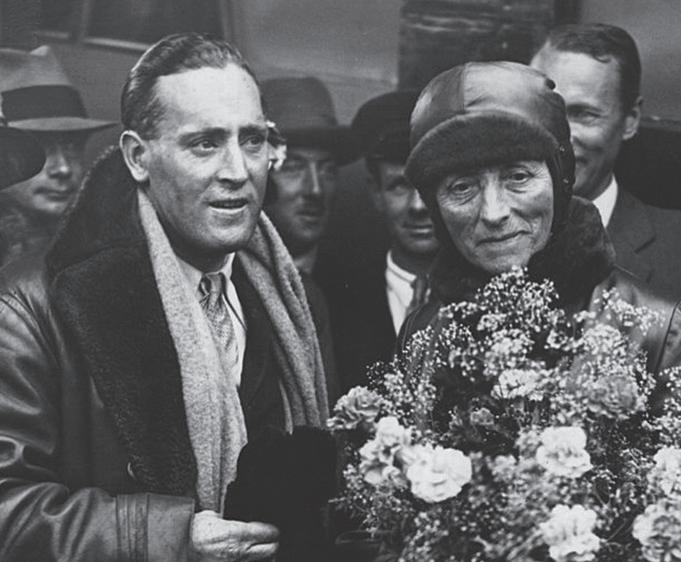
Having misread her compass in a snowstorm, she flew out to sea in her Gipsy Moth over Norfolk and was never seen again. Thus was the life led by the ‘premier aviatrix’, who built this temple to her dog.
The Pekingese breed had been bought to Europe in 1860 by French and British soldiers. They had found them in the Summer Palace after the raid on Peking (Beijing). As imperial dogs, they were the Emperor’s bodyguards, two to the fore barking his approach, two behind with the hem of the royal robe in their mouths. They had, after all, been objects of worship in China for centuries.
And quite rightly so.

Having misread her compass in a snow-storm, she flew out to sea and was never seen againAfter a return flight to India. Croydon, 1929 Wuzzy (centre), aka Che Foo, plus pals The Flying Duchess: at the Lord Northart Cup Competition for Women Pilots, Reading, 1936
Is there anything you can’t leave home without?
My long-haired miniature dachshund, Maurice. I paid huge amounts of money to bring him from America to England last summer. He’s even been to the Palio in Siena.
Is there something you really miss?
My family, my mum [Teresa Wells, sister of the late Alexander Chancellor, the former Oldie editor] and my siblings –or you think you do.
What are your memories of Alexander Chancellor, your uncle?
His crazy laugh [she cackles like him], playing the piano, smoking loads of cigarettes, and going to stay with them in Italy.
Do you travel light?
I wish I travelled light; I normally have a sticker on my bag saying HEAVY.
What’s your favourite destination? East Sussex, where all my brothers and sisters come together to see my mum.
What are your earliest childhood holiday memories?
Portofino in Italy and Fort Clonque in Alderney, a Landmark Trust house. I can remember in Italy going on a pedalo and meeting Isaiah Berlin.
Did you always want to be on the stage?
I think I did from the age of about eight. I remember watching my dad (the actor and writer John Wells, 1936-98) in Anyone for Denis? at the Whitehall Theatre and going on stage afterwards with no one in the audience and thinking it was a real rush. Also, he would come home from Anyone for Denis? with Edward Fox and different actors who were all just so friendly and funny and it seemed like a really fun thing to do.
I didn’t at university, weirdly, but at school I did loads. I was always a man. I remember being really proud directing
Noises Off by Michael Frayn, and then my dad introduced me to Michael Frayn and said, ‘This is my daughter, Dolly. She’s just directed your play Noises Off at school but she only used two acts,’ and then he walked off. It was only because we didn’t have long enough.
The actress Emily Mortimer, my old friend, was responsible for that. When I was about 27, she said, ‘Why don’t we write something together?’ and it felt like a bit of an extension of my dad. We started writing Doll & Em.

Was your dad pleased that you were following in his footsteps?
I don’t think as a parent you’re longing for your children to act, but he messed it up by demonstrating how much fun it can be. I think he minded that I get a university degree and he would have been pleased with me writing. I remember visiting him in hospital and I’d bought myself a really fancy pair of trainers and he said he was really proud, and I said, ‘What are you proud of?’ and he said, ‘Your trainers.’
Did your dad come to see you in things at school and drama school?
I was Portia in The Merchant of Venice at school. I remember seeing him sitting in the audience, trying to remind me of the speech ‘The quality of mercy is not strained’ by doing the actions.
Did you grow up seeing the Oldie founder, Richard Ingrams?
Yes, and on holiday in Alderney, hearing John on the phone to him doing his column Dear Bill and they’d be really laughing.
Where was the Dracula series for television filmed?
In Slovakia, but mostly in Bray Studios near Windsor.
And Inside Man?
In these new studios near Farnham and it was all the same gang again as for Dracula. So it was really fun.
By Louise FlindWhat’s David Tennant like?
Very nice. We met during COVID because I had a tiny part in Around the World in 80 Days.
What’s the most exotic location you’ve filmed in?
It feels quite exotic being an English person in Los Angeles.
And the worst location?
In Ireland, freezing cold, and I was in a swimsuit pretending to be warm and I had to do this stretch and go, ‘So lovely.’
How close to the truth is Doll & Em? The only reality was our names.
What did you miss about the UK in the US and vice versa?
When I’m in America, I miss the basic things such as Marmite, English chocolate, Gogglebox, my friends and my family. When I’m in England, I miss the straightforwardness of the people in America.
Was a Zoom divorce from your husband, photographer Mischa Richter, a brilliant new invention?
[She laughs.] I think these things are quite difficult whether you’re in court or on Zoom.
Do you like coming home?
Yes, especially now I’ve got Maurice.




Across 1 Neighbour sent back for a bit of brass (4)
3 Determined to see cover goes on for each relation, briefly (10) 9 Before function, millions meditate (4) 10 Estate worker willing to look back - I’m not sure! (10) 11 Shot after disputing title - don’t think about that (3,2,2)
13 9’s heartless time in continent without love (7)
14 Imagine accepting beaten emir must be put on top (11)
18 School leaver split coat on trophy, perhaps (6,5)
21 Surly chap - accountant with a love for drink (7)
22 A scream left one cold - that’s material (7)
23 Soldiers may wear these if group looks after old (10)
24 Drink is good, say, occasionally (4)
25 One might catch small mice at sea panicking (7,3)
26 Material left after construction (4)
Down



2 Where you’ll find boarders kiss best? (3,5)
4 9 may be in danger at once (5)
5 Loader seeing first wife and daughter in shop (9)
6 Delightful shower offering addition to salad (5,6)
7 Province of person elected in Ireland (6)
8 Serving dish that’s acceptable in woodwork (6)
12 9’s task to support priest in trouble (11)
15 9 Post Office workers in endless free-for-all (9)
16 Manage to accommodate everybody, with one getting 9 (8)
17 Trader offering French sea ditty (8)
19 Equipment items used by young scout in special army unit (6)
20 Indian princess wearing gold raised 9 (6)
How to enter Please scan or otherwise copy this page and email it to comps@theoldie.co.uk. With regret, we are temporarily unable to accept postal entries. Normal procedure will be restored as soon as possible. Deadline: 8th February 2023 We do not sell or share your data with third parties.
First prize is The Chambers Dictionary and £25. Two runners-up will receive £15. NB: Hodder & Stoughton and Bookpoint Ltd will be sent the addresses of the winners because they process the prizes.
Genius 420 solution
Altitude (6)
Abnormal (5)
Sad, infelicitous
(7)
Allowed within the law (5)
Fasten; draw (3)
Freezing cold (3)
Young of goat (3)
Personal (3)
Tooth (5)
Assert, state (7)
Student discussion group (7)
Vote in (5)
Circumvented, avoided (6)
Head of city government (5)
Down
1
Exactly alike (9)
Charming; stealing (6)
Breathe out (6)
Space; opening (3)
Secret lovers’ meetings (6)
Below par (11)
13
17
18
Winner: Alan Scollan, London W1 Runners-up: Dr Arabella Woodrow, Keighley, West Yorkshire; Neil Rogers, London N7
Moron 420 solution: Across: 1 Ghost, 4 Heady (Go steady), 8 Err, 9 Tonsillitis, 10 Service, 12 Check, 13 Remand, 14 Spider, 17 Annul, 19 Arrayed, 21 Supplements, 23 Sic, 24 Enemy, 25 Dopey. Down: 1 Gates, 2 Own, 3 Tuition, 4 Halved, 5 Attic, 6 Yesterday, 7 Trucker, 11 Reminisce, 13 Realist, 15 Pyramid, 16 Valley, 18 Lapse, 20 Dishy, 22 Nip.
The Oldie February 2023 89

I recall a biology class leading up to my O Level. We were doing a self-marked test. Not a model student at the time, I was reading a bridge book and had made no effort (of which I am not proud). ‘Please read out your mark,’ said the teacher. The highest mark before we got to R for Robson had been 96. ‘98,’ I said brazenly.
There was hush, as I was known to be an underachieving student. ‘Let me have a look,’ said the surprised teacher. My entirely blank sheet did not go down well and a trip to the headmaster was immediate. (PS: although my grade in the mock O Level was Unclassified and the school did not want me to take the O Level, I was determined to prove them wrong – and almost got an ‘A’.)

Speaking of 98 per cent, can you find the 98-per-cent line of play to make Four Hearts on this month’s conundrum? West leads the knave of diamonds to your ace.
At the table, declarer led a spade to the queen at trick two, keen to ruff a spade in dummy. East won the king and promptly switched to his singleton heart. There was no way home from here, declarer electing to finesse. West won the king and led a second heart. Declarer won in hand and, in an effort to make a tenth winner, tried a club to the queen. East won the king and led a spade through the knave, declarer losing two further spades to go two down.
Declarer was correct to play on spades early on in the hope of ruffing a spade in dummy. However, he needs to avoid losing an early trick to East, who can switch to a heart through your ace. The key – almost 100-per-cent line – is to cross to the ace of clubs at trick two and lead a low spade from dummy. East cannot profitably rise with the king (or you have a spade trick by force), so your jack loses to West’s ace. You ruff West’s (say) diamond return (West unable to switch to a heart without sacrificing his king) and lead a second spade. East beats the queen with the ace and switches to his heart – but you rise with the ace and ruff your third spade in dummy. Neat – innit.
ANDREW ROBSONIN COMPETITION No 288, you were invited to write a poem called Always Carry Water. For Paul Holland it was simple: ‘Always carry water is terrible advice/ It’s the same weight as beer and doesn’t taste as nice.’ So it was for Jennifer Coville: ‘Personally I like to have two hands free/ so carrying water is never for me!’ David Dixon put such advice among other nannying directives, such as ‘And if you put a deckchair up/Make sure your fingers don’t get stuck.’ Max Ross thought it ‘a useful metaphor;/Even when you live in peacetime/Realise there might be war.’ Commiserations to them and to Susan Greenhill, Katie Mallett and Con Connell, and congratulations to those printed below, each of whom wins £25, with the bonus prize of Chambers Dictionary going to Bill Holloway for his surprising zodiacal invention.
‘If you want the world to notice’ –Uncle Leo was notorious For badgering his timid stars In matters pomp-and-glorious –‘Then throw your chest out, raise your voice And always be uproarious. Yea, leave to lesser folk the paths To safety that are various, And burn the candle at both ends –Enjoy la vie precarious!
I know you’re not a dead-eye Dick Like Cousin Sagittarius, But – big and simple, like yourself –Be doughty, temerarious!’ ‘He could always carry water,’ Muttered Grandaddy Aquarius. Bill Holloway
It was the Duke of Wellington (Not easily unnerved) Who on the road to Waterloo Immortally observed
That one should never miss a chance, When viewing foreign scenes,
To give the horses water, or To visit the latrines.
So always carry water! For you can never tell What microbes may be lurking Within a foreign well.
Always carry water! So when the rockets burst, You’ll have one consolation: You didn’t die of thirst.
Gail White
We learned in school the camel’s hump Is not a bony solid lump But fills with water for the road And thus the camel bears its load.
It crosses deserts, miles of sand, This brimming water tank on hand. And we believed this simple truth With all the innocence of youth.
But now this isn’t fact, we’re told; The camel’s hump can only hold Water because it’s packed with fat. It’s not a barrel, tank or vat.
So what of other ‘truths’ that school Instilled in us? Is there some rule About cross-checking, now, each year Those ‘facts’ that we once held so dear?
D A Prince
I always carry water. It’s a thing That creeps up on one, like so many ills Of later life. This one contrives to bring The slack-topped socks and diuretic pills Along with the increased necessity For hasty visits to the yes-indeed Which seldom offers synchronicity In terms of opportunity and need. My middle is a living reservoir That ripples with its fluid overload; My thighs are jellies and my ankles are Two leather bottles eager to explode. I have become resigned to all of these But wish I didn’t piddle when I sneeze.
Ann Drysdale
COMPETITION No 290 You are invited to write a poem with the title Spring Cleaning, and please make it an acrostic, so that the first letter of each line spells out the title. We cannot accept any entries by post, I’m afraid, but do send them by e-mail (comps@theoldie. co.uk – don’t forget to include your own postal address), marked ‘Competition No 290’, by Thursday 9th February.
‘Where do you see yourself in five lives from now?’
Imagine the Scottish coast. If you’re a southern tourist like me, you’ll picture the drama of the west coast and the romance of its islands. So a walk on its east coast was an education, and a revelation.

I began by parking on the pier in the comely fishing village of Collieston, north of Aberdeen. Read that sentence again, oh lovers of Cornwall, and envisage a miraculous universe where you can still find a free space on the harbourside for your car.

The fishwives of Collieston once trudged inland with wicker rucksacks full of the catch of the day, to exchange for meat or cash from farmers’ wives.
The fishing has gone now and, when I visited, Collieston harbour was populated by cold-water wives standing neck-deep in the icy sea, chatting to each other. I was walking back in balmy September but even then it was impressive. I bet they are still at it now, as you read these words beside the fires of midwinter.
Huffing up through High Town, I took the coast path south into a wilderness of granite cliffs peppered with little inlets like the geos of Orkney. Each rocky bay and outcrop was named: the Sheverock, the Rawn, Poor Man, Bennet’s Love and Corbie Holes.
The north-east offers not so much four seasons in one day as four seasons in one landscape. On land, it was cool and grey but, out to sea, there was a patch of brilliant blue sky, where God’s rays spilled on to the water.
The light in this part of the world is stern and uncompromising but tricksy, too. Far out to sea, I saw a fantasy island appear of low, rolling hills. Only binoculars revealed that they were clouds, halfway beyond the horizon, a trick of such clear light.
The sea offered enough drama but inland was stranger still, a vast dunescape of rolling sand. These dunes had somehow coalesced above the cliffs, blown up and over by centuries of ferocious easterlies.
This was the 1,000 hectares of Forvie
national nature reserve. In September, the dunes and heathland were still pretty with purple heather and yellow bird’s-foot trefoil. But capricious, too. I clambered up one particularly tall dune to orient myself but, from its heights, could see only a maze of hummocks and hillocks in every direction.
I reached Hackley Bay, a spectacular sandy cove equal to Cornwall’s finest. Unlike the West Country, it was empty of human life. So much coast; so few folk.
On the sands there were hefty nautical ropes alongside a yellow bucket once wielded by a digger, washed up by previous tides. Visit after a storm for big prizes.
The land gradually lowered towards the mouth of the River Ythan as I reached the abandoned village of Forvie, which had been either swallowed by sand dunes or destroyed in a storm in the 15th century. No one quite remembered. A large sallow grew over the rubble of what might have been the old church.
I turned inland and suddenly the sun flashed out and red admirals flew everywhere, even though it was still spitting with rain. A low rainbow appeared over the purple heather.
After a short stroll away from the sea, I took the first right, north again, on a track back through the dune heath, filled with little flitting birds and painterly efflorescences of grey-green lichen over the turf.
It was stark, peaceful and beautiful, and almost a relief to reach the cosy streets of Collieston again. I finished a memorable walk with a dip in the harbour: gloriously bracing in September; madness in midwinter.
Follow the coast south for nearly three miles to the ruins of Forvie. Take the track inland for half a mile, before picking up a northerly track that becomes a wiggly footpath leading back through the dunes to Collieston – tricky to navigate in a sea fog!














































QMy husband has always been a workaholic, spending long hours at the office, and away on business I’d long dreamed of the day we could at last have time to ourselves, being able to travel, spend relaxing evenings watching television together, go out to nice restaurants and visit our grandchildren. But now he’s retired, it seems he has no intention of letting up. For the last six months, he’s signed up to all kinds of duties, delivering food to food banks, visiting lonely old people, driving them to hospital appointments and so on. Now he’s just dropped the bombshell – he says he’s going to apply to be a local councillor! When he told me, I felt like weeping. I feel I might as well not be married at all.
If I protest, he says I’m selfish and he’s helping a lot of people and so on.
J P, IpswichACan’t he see the lonely old person in front of his nose – you, at home? It’s time to suggest that you both consult a marriage therapist.
They might suggest that you spend at least one designated evening a week, entirely on your own, together. I suspect, once you knew that every Thursday, say, you’d have him to yourself, you’d be able to relax the other days of the week and perhaps get wider interests of your own.
Without that, you’ll just be waiting, like a hungry dog under the table, in a state of permanent anxiety. The situation isn’t good for you – or your marriage.
QWe live in the country, down a very narrow lane that leads to a dead end. Instead of parking in
front of their own house, my neighbours often park in the turning point at the bottom. It means that if I want to get out, I have to back up the lane – something I’m not very good at, particularly when it gets dark.
They have every right to park where they want – there are no restrictions here – but it’s just so inconsiderate.
My friend, who’s been involved in disputes with neighbours, advises that I say nothing because, he says, it will only turn nasty.
But I sometimes feel so consumed with fury that I can’t sleep. I don’t know why – because, as he says, it’s only a car. No one has died.
Antonia G, HerefordshireAWhat you are angry about is not the car per se, but the way your power has been grabbed from you. You feel bullied by your neighbours, forced to back up the lane, even though you hate and fear doing it.
I imagine that every time they return home, you twitch the curtain to check where they park. If it’s in front of their house, you breathe a sigh of relief, knowing you’ll be able to sleep.
You’ve probably become so sensitised that your heart starts beating with anxiety the moment you hear the crunch of their wheels on the road. If you have a son, daughter or a partner, get them to explain to your neighbours – without your being present, of course – that you become a gibbering wreck every time you reverse down the road.
Instead of making the request a demand, make it seem a favour – give them the power, in other words. If they have a drop of kindness in them, they’ll do as they’re asked. Follow it up with a bunch of flowers, and ask if there’s anything you can do to return the favour.
ISSN 0965-2507. Printed in England by Walstead Group. Distributed by Seymour Distribution Ltd, 2 East Poultry Avenue, London EC1A 9PT; www.seymour.co.uk
House, 23/31 Great Titchfield Street, London W1W 7PA
To order a print subscription, go to subscribe@theoldie.co.uk or call 0330 333 0195
Print subscription rates for 12 issues: UK £49.50; Europe/Eire £58; USA/Canada £60; rest of world £69.
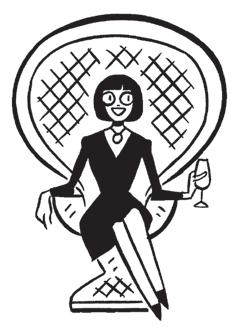
QI’m a single mother – my husband died when my son was only one year old – and my son and I have always been very close.
Now, at 18, he’s just told me he thinks he might be gay. I was perfectly fine with that, until my best friend implied he wouldn’t be gay if we hadn’t been so close. I told another friend what she’d said, and this friend said that of course he was gay, because he hadn’t had a father around when he was young. Now I feel terribly guilty. I know I can’t put the clock back, but I feel it is my fault. And though I know he can be happy anyway, because he’s well adjusted, bright and kind, I wish he could have had a family of his own and children, and know the pleasures of a normal relationship. Name and address supplied
AWhy are you listening to these frightful, poisonous, old finger-waggers? What on earth do they know about why some people are gay? They’re just regurgitating old wives’ tales. Very little is known about it, and no research has shown that having a single parent has anything to do with it. As for having a family of his own, he may well find a lifetime partner, adopt children and end up far happier than lots of heterosexual couples. And as for a ‘normal’ relationship – what century are you living in? If these ghastly ‘friends’ try to blame you again, stand up for yourself and ask what they’re trying to blame you for. Having a lovely, well-adjusted, happy son? What’s wrong with that?
Please email me your problems at problempage@theoldie.co.uk; I will answer every email – and let me know if you’d like your dilemma to be confidential.
To buy a digital subscription for £29.99 or a single issue for £2.99, go to the App Store on your tablet or mobile and search for ‘The Oldie’.
All rights of reproduction are reserved in respect of all articles, drawings, sketches etc published in The Oldie in all parts of the world. Reproduction or imitation of any of these without the express prior written consent of the publisher is forbidden.
The Oldie is available in audio and e-text format for the benefit of blind and partially sighted readers through RNIB Newsagent. Telephone 0303 123 9999 or visit www.rnib. org.uk/newsagent for further details.

